Sony Group DCRPC120 Digital Video Camera Recorder - Bluetooth User Manual DCR PC115 PC120BT
Sony Corporation Digital Video Camera Recorder - Bluetooth DCR PC115 PC120BT
Contents
- 1. network operating instructions
- 2. Note on model names
- 3. Users Manual I
- 4. Users Manual II
Users Manual II
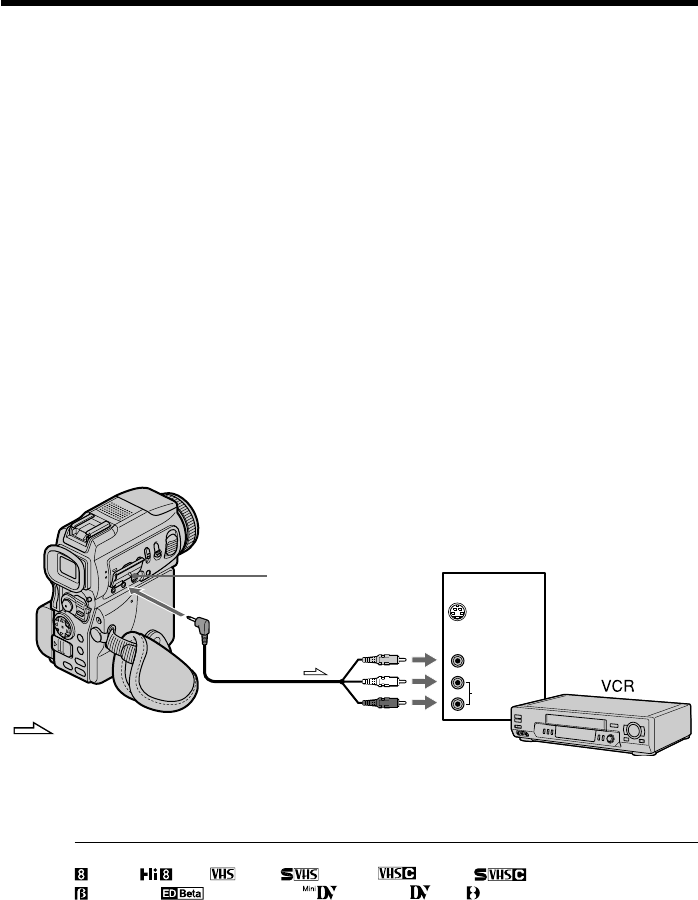
66
Using the A/V connecting cable
You can dub or edit on the VCR connected to your camcorder using your camcorder as
a player.
Connect your camcorder to the VCR using the A/V connecting cable supplied with
your camcorder.
Before operation
•Set DISPLAY to LCD in the menu settings. (The default setting is LCD.)
•Press the following buttons to make the indicator disappear so that they will not be
superimposed on the edited tape:
–DISPLAY
–DATA CODE on the Remote Commander
–SEARCH MODE on the Remote Commander
(1)Insert a blank tape (or a tape you want to record over) into the VCR, and insert
the recorded tape into your camcorder.
(2)Prepare the VCR for recording, then set the input selector to LINE.
Connect the A/V connecting cable to AUDIO/VIDEO jack.
Refer to the operating instructions of the VCR.
(3)Set the POWER switch to VCR on your camcorder.
(4)Play back the recorded tape on your camcorder.
(5)Start recording on the VCR. Refer to the operating instructions of your VCR.
When you have finished dubbing a tape
Press x on both your camcorder and the VCR.
You can edit on VCRs that support the following systems:
8 mm, Hi8, VHS, S-VHS, VHSC, S-VHSC,
Betamax, ED Betamax, mini DV, DV, Digital8
If your VCR is a monaural type
Connect the yellow plug of the A/V connecting cable to the video input jack and the
white or the red plug to the audio input jack on the VCR or the TV. When the white
plug is connected, the left channel audio is output, and when the red plug is connected,
the right channel audio is output.
— Editing —
Dubbing a tape
S VIDEO
VIDEO
AUDIO
IN
AUDIO/VIDEO
S VIDEO
: Signal flow
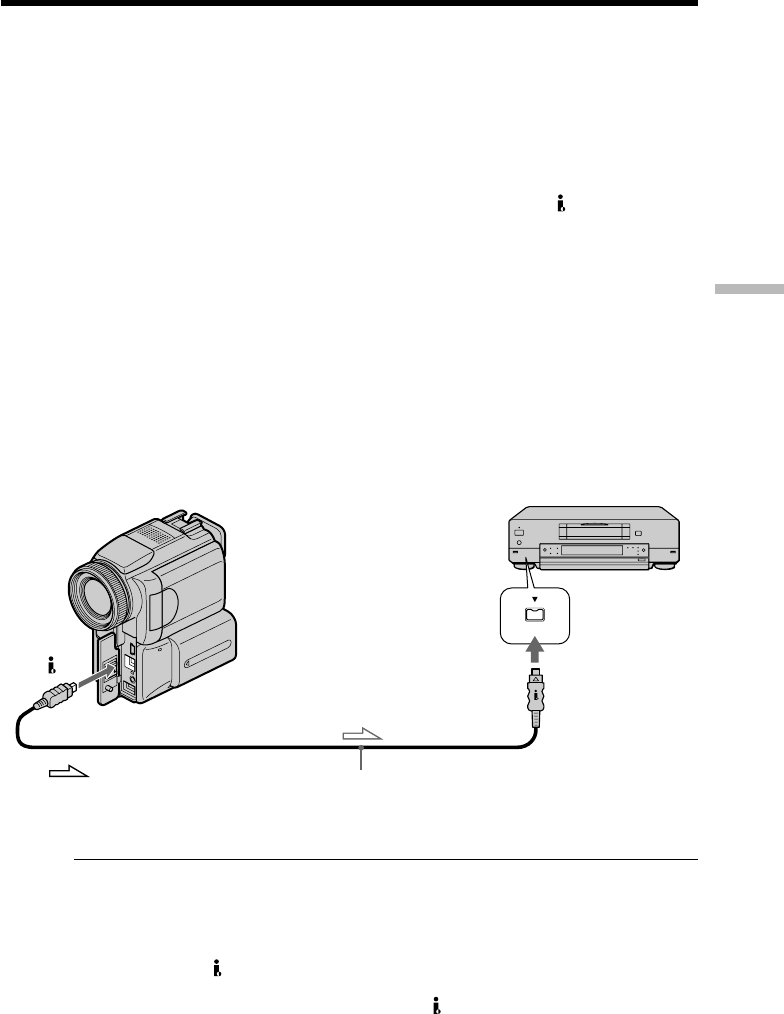
67
Editing
If your VCR has an S video jack
Pictures can be reprodeced more faithfully by using an S video cable (optional).
With this connection, you do not need to connect the yellow (video) plug of the A/V
connecting cable.
Connect an S video cable (optional) to the S video jacks of both your camcorder and the
VCR.
This connection produces higher quality DV format pictures.
Using the i.LINK cable (DV connecting cable)
Simply connect the i.LINK cable (DV connecting cable) (optional) to DV jack of your
camcorder and to DV IN of the DV products. With a digital-to-digital connection, video
and audio signals are transmitted in digital form for high-quality editing. You cannot
dub the titles, display indicators or the contents of cassette memory or letters on the
“Memory Stick” index screen.
Set the input selector on the VCR to the DV input position if the VCR is equipped with
the input selector.
(1)Insert a blank tape (or a tape you want to record over) into the VCR, and insert
the recorded tape into your camcorder.
(2)Prepare the VCR for recording.
Set the input selector to LINE. Refer to the operating instructions of the VCR.
(3)Set the POWER switch to VCR on your camcorder.
(4)Play back the recorded tape on your camcorder.
(5)Start recording on the VCR. Refer to the operating instructions of the VCR.
When you have finished dubbing a tape
Press x on both your camcorder and the VCR.
You can connect one VCR only using the i.LINK cable (DV connecting cable)
See page xxx for more information about i.LINK.
Pictures processed by the picture effect, the digital effect or PB ZOOM function
Pictures processed by the picture effect, the digital effect or PB ZOOM function are not
output through the DV jack.
If you record a playback pause picture with the DV jack
The recorded picture becomes rough. And when you play back the picture using the
other video equipment, the picture may jitter.
Dubbing a tape
DV
DV DV IN
(optional)
: Signal flow
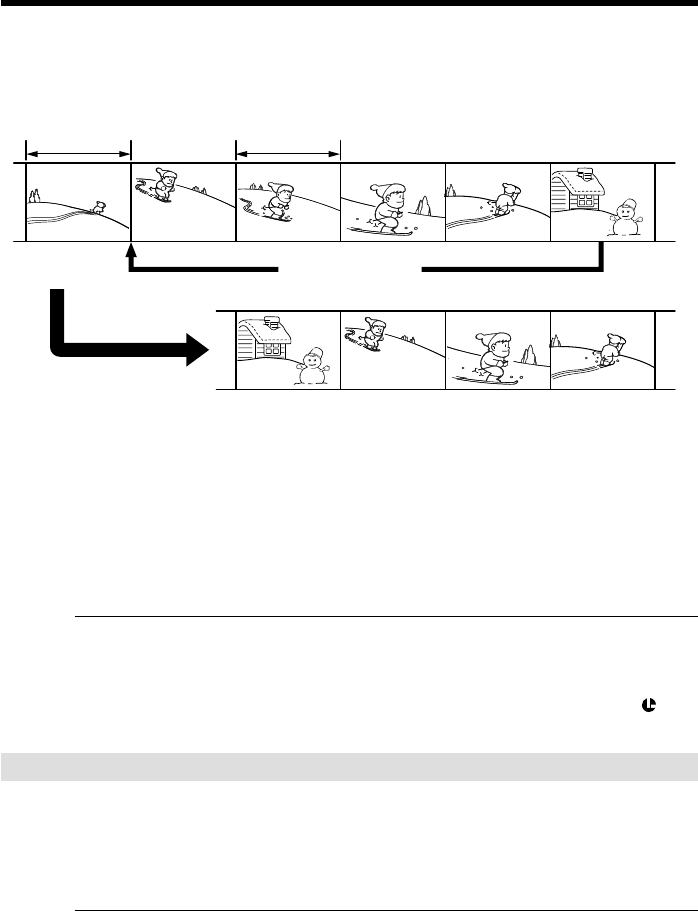
68
You can duplicate selected scenes (programs) for editing onto a tape without operating
the VCR.
Scenes can be selected by frame. You can set up to 20 programs.
Your camcorder can dub on “Memory Stick”s. See p. xx for more information.
Before operating the Digital program editing to a tape
Step 1Connecting the VCR (p. xx).
Step 2Setting the VCR for operation (p. xx, xx).
Step 3Adjusting the synchronization of the VCR (p. xx).
When you dub using the same VCR again, you can skip steps 2 and 3.
Using the Digital program editing function
Operation 1Making the program (p. xx).
Operation 2Performing the program (dubbing a tape) (p. xx).
Notes
•When you connect with an i.LINK cable (DV connecting cable), you may not be able to
operate the dubbing function correctly, depending on the VCR.
Set CONTROL to IR in the menu settings of your camcorder.
•When editing digital video to a tape, the operation signals cannot be sent with
LANC.
Step 1: Connecting the VCR
You can connect both an A/V connecting cable and an i.LINK cable (DV connecting
cable).
When you use the A/V connecting cable, connect the devices as illustrated on page xx.
When you use an i.LINK cable (DV connecting cable), connect the devices as illustrated
on page xx.
If you connect using an i.LINK cable (DV connecting cable)
With digital-to-digital connection, video and audio signals are transmitted in digital
form for high-quality editing.
Dubbing only desired scenes
– Digital program editing (to a tape)
Unwanted scene Unwanted scene
Switch the order
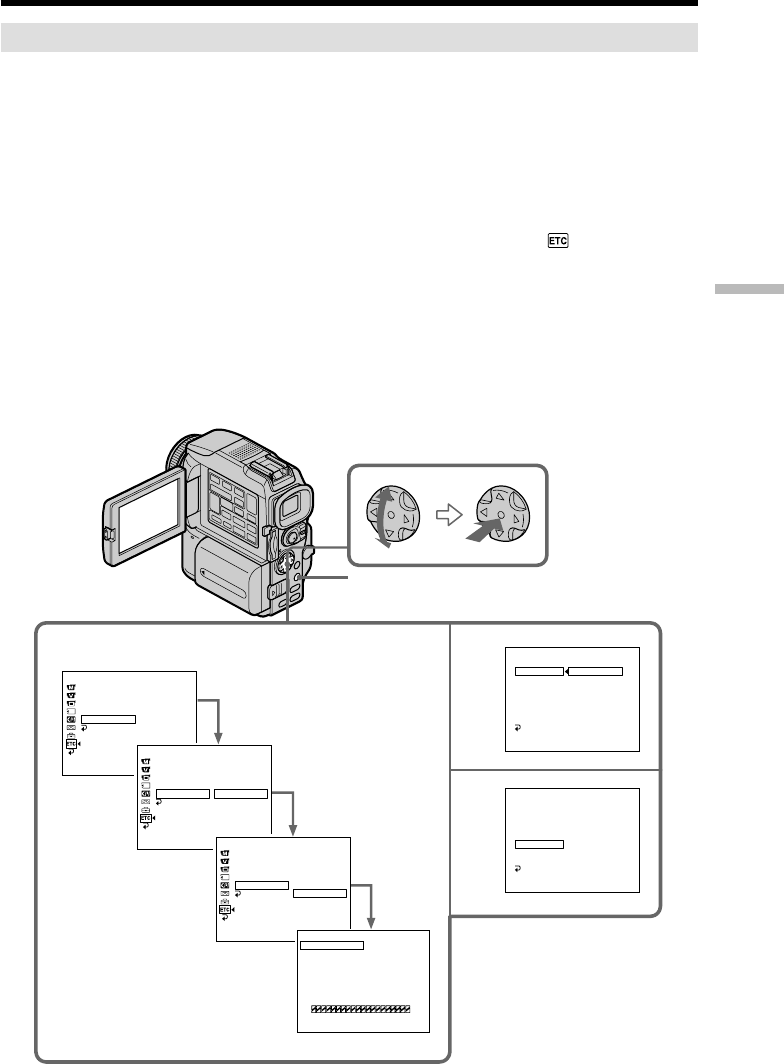
69
Editing
Step 2: Setting the VCR to operate with the A/V connecting cable
To edit using the VCR, send the control signal by infrared rays to the remote sensor on
the VCR.
When you connect using an A/V connecting cable, follow the procedure below, (1) to
(4), to send the control signal correctly.
(1) Set the IR SETUP code
1Set the POWER switch to VCR on your camcorder.
2Turn the power of the connected VCR on, then set the input selector to LINE.
When you connect a video camera recorder, set its power switch to VCR/VTR.
3Press MENU, then select and decide upon VIDEO EDIT in with the control
button (p. xx).
4Select and decide upon TAPE with the control button.
5Select and decide upon EDIT SET with the control button.
6Select and decide upon CONTROL with the control button.
7Select and decide upon IR with the control button.
8Select and decide upon IR SETUP, then select and decide upon IR SETUP code
of your VCR with the control button.
Check the code in “About the IR SETUP code.” (p. xx)
Dubbing only desired scenes – Digital program editing (to a tape)
6
8
3,4,5
VIDEO ED I T
ED I T SET
CONTROL
ADJ TEST
”
CUT
-
IN
”
”
CUT
-
OUT
”
IR SETUP
PAUSEMODE
IR TEST
IR
RETURN
[
MENU
] :
END
0:08:55:06
VIDEO ED I T
ED I T SET
CONTROL
ADJ TEST
”
CUT
-
IN
”
”
CUT
-
OUT
”
IR SETUP
PAUSEMODE
IR TEST
1
RETURN
[
MENU
] :
END
0:08:55:06
VIDEO EDIT
DATA CODE
OTHERS
BEEP
COMMANDER
DI SPLAY READY
[
MENU
]
:
END
RETURN
DATA CODE
OTHERS
BEEP
COMMANDER
DI SPLAY
VIDEO EDIT RETURN
TAPE
MEMORY
[
MENU
]
:
END
RETURN
DATA CODE
OTHERS
BEEP
COMMANDER
DI SPLAY
VIDEO EDIT RETURN
TAPE
MEMORY
[
MENU
]
:
END
RETURN
KRAM ODNU LLAESARE TRATS TES/TIDE
LATOT ENECS
NI
10:08:55:06
0:00:00:00
0
[
MENU
] :
END
VIDEO ED I T
i
.
LINK
MENU

70
Dubbing only desired scenes – Digital program editing (to a tape)
* TV/VCR component
Note on IR SETUP code
Digital program editing is not possible if the VCR does not support IR SETUP codes.
About the IR SETUP code
The IR SETUP code is stored in the memory of your camcorder. Be sure to set the
correct code, depending on your VCR. The default setting is code number 3.
Brand IR SETUP code
Sony 1, 2, 3, 4, 5, 6
Admiral (M. Wards) 89
Aiwa 80
Audio Dynamic 21, 35
Bell&Howell (M. Wards)
36
Brocsonic 70, 82
Canon 77, 78, 97
Citizen 47
Craig 47, 73
Curtis Mathis 8, 77, 80
Daewoo 26, 40, 77
DBX 21, 33, 35
Dimensia 8
Emerson 26, 48, 59, 70, 81, 82
Fisher 36, 37, 44, 45
Funai 80
General Electric 8, 32*, 77, 87, 94*
Goldstar 47
Hitachi 8, 42, 78
Instant Replay 77, 78
JC Penny 8, 21, 33, 35, 36, 42, 77
JVC 12, 13, 14, 21, 33, 35
Kenwood 21, 33, 35, 47
LXI (Sears) 36, 37, 42, 44, 45, 47, 80
Magnavox 77, 78, 83
Marantz 21, 33, 35
Marta 47
Memorex 37, 77
Minolta 8, 42
Mitsubishi/MGA 22, 23, 24, 28
Brand IR SETUP code
Multitech 23, 32, 80
NEC 21, 33, 35
Olympic 77, 78
Panasonic 16, 17, 77, 78, 96
Pentax 8, 42
Philco 77, 78
Philips 77, 78, 83
Pioneer 78
Quasar 16, 17, 77, 78
RCA/PROSCAN 7, 8, 16, 40, 41, 42, 77, 78*, 83,
101
Realistic 36, 77
Sansui 21
Singer 73
Samsung 24*, 32, 32*, 41, 94, 94*
Sanyo 36, 37
Scott 22, 23, 24, 28, 32, 37, 40, 41
Sharp 88, 89
Shintom 73
Signature 2000 (M. Wards)
80, 89
Sylvania 77, 78, 80, 83
Symphonic 80
Tashiro 47
Tatung 21, 33, 35
Teac 21, 33, 35, 80
Technics 77, 78
Toshiba 7, 40
Wards 37, 47, 88, 89, 95
Yamaha 21, 33, 35, 36
Zenith 95
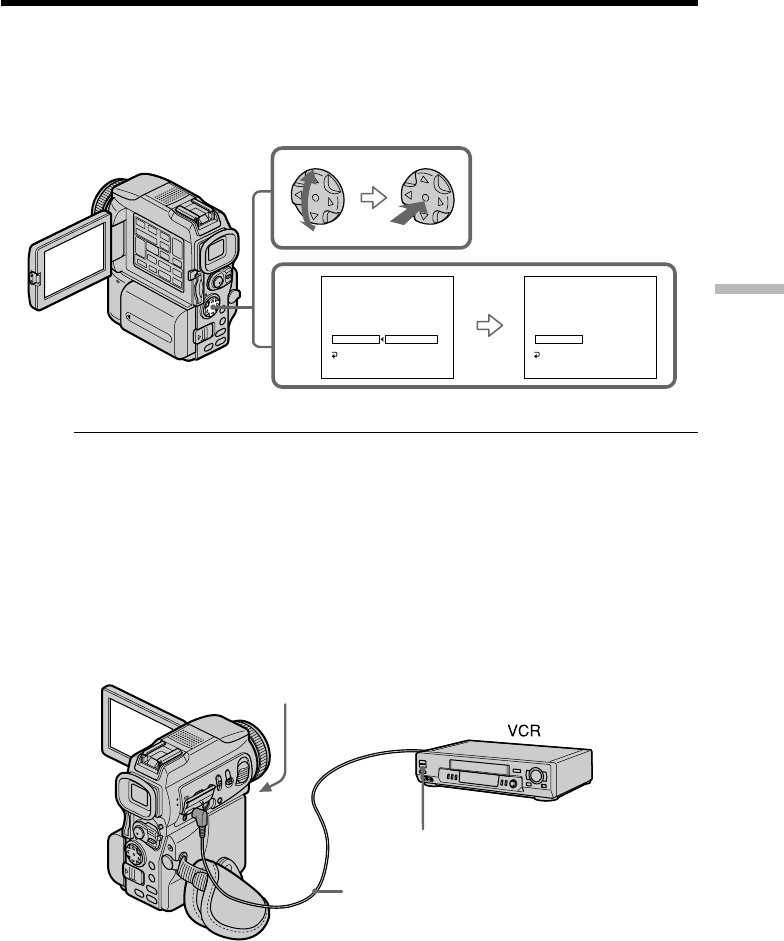
71
Editing
(2) Setting the modes to cancel the recording pause on the VCR
Select and decide upon PAUSEMODE with the control button, then select and
decide upon the mode to cancel recording pause on the VCR with the control
button.
Refer to the operating instructions of your VCR.
The buttons to cancel recording pause on the VCR
The buttons vary depending on your VCR. To cancel recording pause:
– Select PAUSE if the button to cancel recording pause is X.
– Select REC if the button to cancel recording pause is z.
– Select PB if the button to cancel recording pause is N.
(3) Setting your camcorder and the VCR to face each other
Locate the infrared rays emitter of your camcorder and face it towards the remote
sensor of the VCR.
Set the devices about 30 cm (12 in.) apart, and remove any obstacles between the
devices.
Dubbing only desired scenes – Digital program editing (to a tape)
ED I T SET
CONTROL
ADJ TEST
”
CUT
-
IN
”
”
CUT
-
OUT
”
IR SETUP
PAUSEMODE
IR TEST PAUSE
REC
PB
RETURN
[
MENU
] :
END
VIDEO ED I T
0:08:55:06
VIDEO ED I T
ED I T SET
CONTROL
ADJ TEST
”
CUT
-
IN
”
”
CUT
-
OUT
”
IR SETUP
PAUSEMODE
IR TEST PAUSE
RETURN
[
MENU
] :
END
0:08:55:06
Infrared rays emitter
A/V connecting cable
Remote sensor
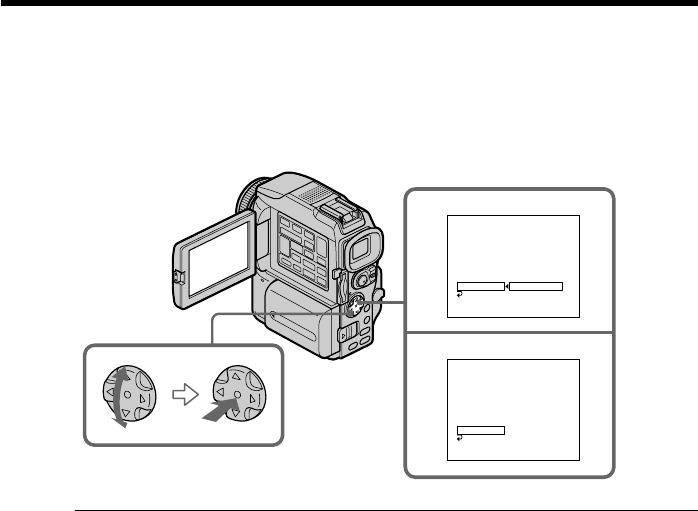
72
(4) Confirming the VCR operation
1Insert a recordable tape into the VCR, then set to recording pause.
2Select and decide upon IR TEST with the control button.
3Select and decide upon EXECUTE with the control button.
If the VCR starts recording, the setting is correct.
When recording is finished, the indicator changes to COMPLETE.
When the VCR does not operate correctly
•After checking the code in “About the IR SETUP code”, set the IR SETUP or the
PAUSEMODE again.
•Place your camcorder at least 30 cm (12 in.) away from the VCR.
•Refer to the operating instructions of your VCR.
Dubbing only desired scenes – Digital program editing (to a tape)
2
3
VIDEO ED I T
ED I T /SET
CONTROL
ADJ TEST
”
CUT
-
IN
”
”
CUT
-
OUT
”
IR SETUP
PAUSEMODE
IR TEST RETURN
EXECUTE
RETURN
[
MENU
] :
END
VIDEO ED I T
ED I T /SET
CONTROL
ADJ TEST
”
CUT
-
IN
”
”
CUT
-
OUT
”
IR SETUP
PAUSEMODE
IR TEST COMPL ETE
RETURN
[
MENU
] :
END
ENGAGE
RECCP A U S E
0:08:55:06
0:08:55:06
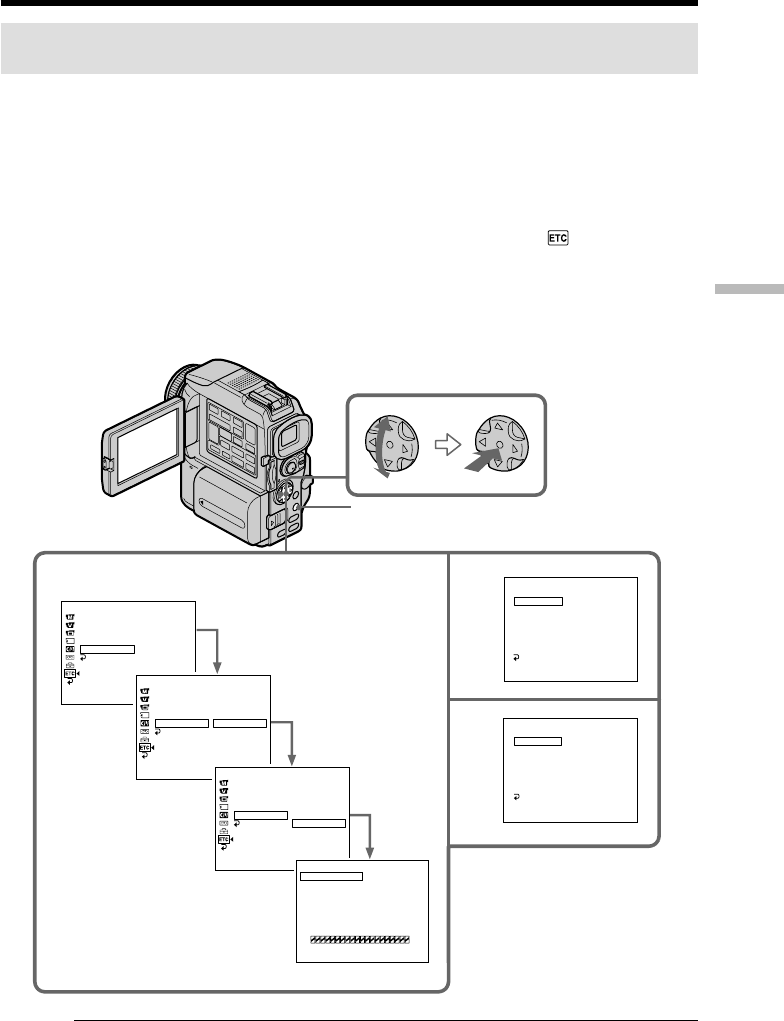
73
Editing
Step 2: Setting the VCR to operate with the i.LINK cable
(DV connecting cable)
When you connect using i.LINK cable (DV connecting cable) (optional), follow the
procedure below.
(1)Set the POWER switch to VCR on your camcorder.
(2)Turn the power of the connected VCR on, then set the input selector to DV
input. When you connect a digital video camera recorder, set its power switch
to VCR/VTR.
(3)Press MENU, then select and decide upon VIDEO EDIT in with the control
button (p. xx).
(4)Select and decide upon TAPE with the control button.
(5)Select and decide upon EDIT SET with the control button.
(6)Select and decide upon CONTROL with the control button.
(7)Select and decide upon i.LINK with the control button.
When you connect using i.LINK cable (DV connecting cable)
You cannot dub the titles, display indicators.
Dubbing only desired scenes – Digital program editing (to a tape)
VIDEO ED I T
ED I T SET
CONTROL
ADJ TEST
”
CUT
-
IN
”
”
CUT
-
OUT
”
IR SETUP
PAUSEMODE
IR TEST
iLINK
RETURN
[
MENU
] :
END
.
0:08:55:06
5
7
VIDEO ED I T
ED I T SET
CONTROL
ADJ TEST
”
CUT
-
IN
”
”
CUT
-
OUT
”
IR SETUP
PAUSEMODE
IR TEST
IR
RETURN
[
MENU
] :
END
0:08:55:06
VIDEO EDIT
DATA CODE
OTHERS
BEEP
COMMANDER
DI SPLAY READY
[
MENU
]
:
END
RETURN
DATA CODE
OTHERS
BEEP
COMMANDER
DI SPLAY
VIDEO EDIT RETURN
TAPE
MEMORY
[
MENU
]
:
END
RETURN
DATA CODE
OTHERS
BEEP
COMMANDER
DI SPLAY
VIDEO EDIT RETURN
TAPE
MEMORY
[
MENU
]
:
END
RETURN
3,4
MARK
UNDO
ERASE ALL
START
ED I T /SET
TOTAL
SCENE
1
IN
0:08:55:06
0:00:00:00
0
[
MENU
] :
END
VIDEO ED I T
MENU

74
Dubbing only desired scenes – Digital program editing (to a tape)
Step 3: Adjusting the synchronization of the VCR
You can adjust the synchronization of your camcorder and the VCR. Have a pen and
paper ready for notes. Before operation, eject a cassette from your camcorder.
(1)Set the POWER switch to VCR on your camcorder.
(2)Insert a blank tape (or a tape you want to record over) into the VCR, then set
to recording pause.
When you select i.LINK in CONTROL, you do not need to set to recording
pause.
(3)Select and decide upon ADJ TEST with the control button.
(4)Select and decide upon EXECUTE with the control button.
IN and OUT are recorded on an image for five times each to calculate the
numerical values for adjusting the synchronization.
The EXECUTING indicator flashes on the screen.
When finished, the indicator changes to COMPLETE.
(5)Rewind the tape in the VCR, then start slow playback.
Take a note of the opening numerical value of each IN and the closing
numerical value of each OUT.
(6)Calculate the average of all the opening numerical values of each IN, and the
average of all the closing numerical values of each OUT.
(7)Select and decide upon “CUT-IN” with the control button.
(8)Select the average numerical value of IN with the control button.
The calculated start position for recording is set.
(9)Select and decide upon “CUT-OUT” with the control button.
(10)Select and decide upon the average numerical value of OUT with the control
button.
The calculated stop position for recording is set.
(11)Select and decide upon RETURN with the control button.
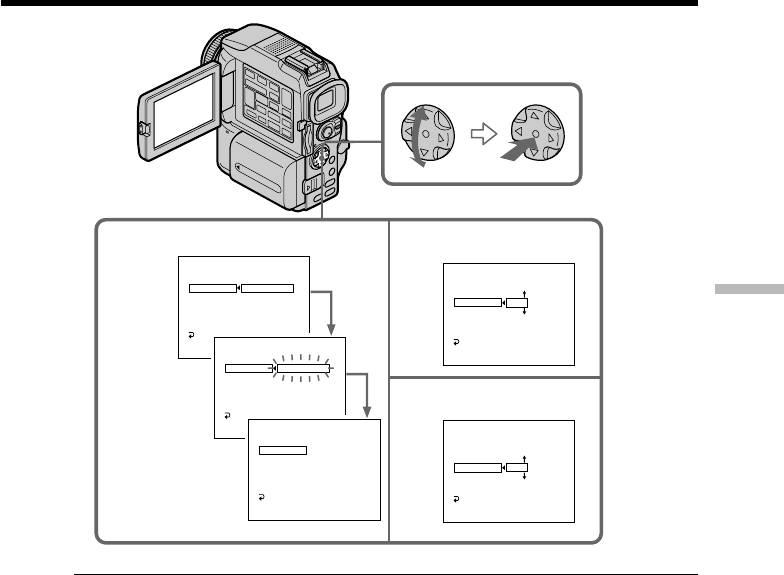
75
Editing
Notes
•When you complete step 3, the image to adjust the synchronization is recorded for
about 50 seconds.
•If you start recording from the very beginning of the tape, the first few seconds of the
tape may not record properly. Be sure to allow about 10 seconds’ lead before starting
recording.
•When the recording unit cannot be operated properly by the i.LINK cable (DV
connecting cable), leave the connection as it is, and make the A/V connecting cable
settings (p. xx). Video and audio are sent by digital signals.
Dubbing only desired scenes – Digital program editing (to a tape)
3,4 7
9
VIDEO ED I T
ED I T SET
CONTROL
ADJ TEST
”
CUT
-
IN
”
”
CUT
-
OUT
”
IR SETUP
PAUSEMODE
IR TEST
RETURN
EXECUTE
[
ME
ENGAGE
RECCP A U S E
0:08:55:06
VIDEO ED I T
ED I T SET
CONTROL
ADJ TEST
”
CUT
-
IN
”
”
CUT
-
OUT
”
IR SETUP
PAUSEMODE
IR TEST
EXECUT I NG
No
5
IN
–60
[
ME
.
0:08:55:06
VIDEO ED I T
ED I T SET
CONTROL
ADJ TEST
”
CUT
-
IN
”
”
CUT
-
OUT
”
IR SETUP
PAUSEMODE
IR TEST
COMPLE TE
RETURN
[
MENU
] :
END
0:08:55:06
VIDEO ED I T
ED I T SET
CONTROL
ADJ TEST
”
CUT
-
IN
”
”
CUT
-
OUT
”
IR SETUP
PAUSEMODE
IR TEST
0
RETURN
[
MENU
] :
END
0:08:55:06
VIDEO ED I T
ED I T SET
CONTROL
ADJ TEST
”
CUT
-
IN
”
”
CUT
-
OUT
”
IR SETUP
PAUSEMODE
IR TEST
0
RETURN
[
MENU
] :
END
0:08:55:06
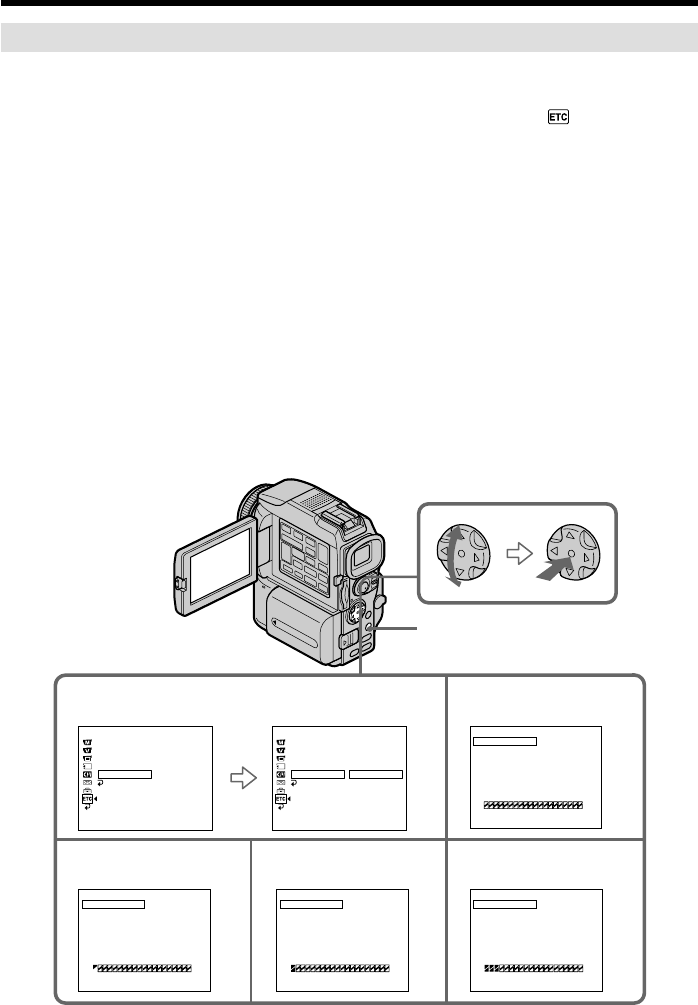
76
Dubbing only desired scenes – Digital program editing (to a tape)
Operation 1: Making the program
(1)Insert the tape for playback into your camcorder, and insert a tape for
recording into the VCR.
(2)Press MENU, then select and decide upon VIDEO EDIT in with the control
button (p. xx).
(3)Select and decide upon TAPE with the control button.
(4)Search for the beginning of the first scene you want to insert using the video
operation buttons, then pause playback.
You can fine-adjust one frame at a time with EDITSEARCH.
(5)Press MARK on the Remote Commander, or z on the control button.
The IN point of the first program is set, and the top part of the program mark
changes to light blue.
(6)Search for the end of the first scene you want to insert using the video
operation buttons, then pause playback.
(7)Press MARK on the Remote Commander, or z on the control button.
The OUT point of the first program is set, then the bottom part of the program
mark changes to light blue.
(8)Repeat steps 4 to 7, then set the program.
When the program is set, the program mark changes to light blue.
You can set up to 20 programs.
5
23
8
7
ED I T SET
MARK
UNDO
ERASE ALL
START
TOTAL
SCENE
1
IN
0:08:55:06
0:00:00:00
0
[
MENU
] :
END
VIDEO ED I T
MARK
UNDO
ERASE AL L
START
ED I T /SET EDI T /SET ED I T /SET
TOTAL
SCENE
1
OUT
0:08:55:06
0:00:00:00
0
VIDEO ED I T
[
MENU
] :
END
MARK
UNDO
ERASE ALL
START
TOTAL
SCENE
2
IN
0:09:07:06
0:00:12:00
1
VIDEO ED I T
[
MENU
] :
END
MARK
UNDO
ERASE ALL
START
TOTAL
SCENE
4
IN
0:10:01:23
0:00:47:12
3
VIDEO ED I T
[
MENU
] :
END
VIDEO EDIT
DATA CODE
OTHERS
BEEP
COMMANDER
DI SPLAY EXECUTE
[
MENU
]
:
END
RETURN
DATA CODE
OTHERS
BEEP
COMMANDER
DI SPLAY
VIDEO EDIT RETURN
TAPE
MEMORY
[
MENU
]
:
END
RETURN
MENU

77
Editing
Dubbing only desired scenes – Digital program editing (to a tape)
Erasing the program you have set
Erase OUT first and then IN from of the last program.
(1)Select and decide upon UNDO with the control button.
(2)Select and decide upon EXECUTE with the control button.
The last set program mark flashes, then the setting is canceled.
To cancel erasing
Select and decide upon RETURN with the control button in step 2.
Erasing all programs
(1)Select and decide upon VIDEO EDIT in the menu settings, then select and
decide upon TAPE with the control button.
(2)Select and decide upon ERASE ALL, then select and decide upon EXECUTE
with the control button.
All the program marks flash, then the settings are canceled.
To cancel erasing all programs
Select and decide upon RETURN with the control button in step 2.
To cancel a program you have set
Press MENU.
The program is stored in memory until the tape is ejected.
Note
You cannot operate recording during the Digital program editing.
On a blank portion of the tape
You cannot set IN or OUT on a blank portion of the tape.
If there is a blank portion between IN and OUT on the tape
The total time code may not be displayed correctly.

78
Operation 2: Performing the program (Dubbing a tape)
Make sure your camcorder and VCR are connected, and that the VCR is set to recording
pause. When you use an i.LINK cable (DV connecting cable) the following procedure is
not necessary.
When you use a digital video camera recorder, set its power switch to VCR/VTR.
(1)Select and decide upon VIDEO EDIT, then select and decide upon TAPE with
the control button.
(2)Select and decide upon START, then select and decide upon EXECUTE with
the control button.
Search for the beginning of the first program, then start dubbing.
The program mark flashes.
The SEARCH indicator appears during search, and the EDIT indicator appears
during edit on the screen.
The PROGRAM indicator changes to light blue after dubbing ends.
When the dubbing ends, your camcorder and the VCR automatically stop.
To stop dubbing during editing
Press x using the video operation buttons.
To end the Digital program editing function
Your camcorder stops when the dubbing ends. Then the display returns to VIDEO
EDIT in the menu settings.
Press MENU to end the program editing function.
You cannot record on the VCR when:
–The tape has run out.
–The write-protect tab on the cassette is set to lock.
–The IR SETUP code is not correct (when IR is selected).
–The button to cancel recording pause is not correct (when IR is selected).
NOT READY appears on the LCD screen when:
–The program to operate the Digital program editing has not been made.
–i.LINK is selected but an i.LINK cable (DV connecting cable) is not connected.
–The power of the connected VCR is not turned on (when you set i.LINK).
Dubbing only desired scenes – Digital program editing (to a tape)
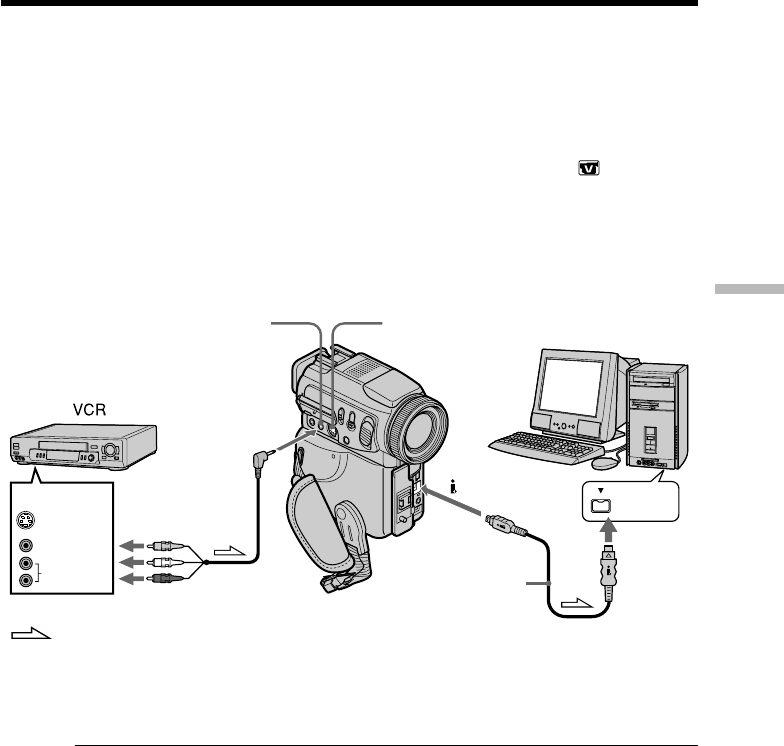
79
Editing
Using with analog video unit and your
computer – Signal convert function
You can capture images and sound from an analog video unit connected to your
computer which has the i.LINK (DV) jack to your camcorder.
Before operation
Set DISPLAY to LCD in the menu settings. (The default setting is LCD.)
(1)Set the POWER switch to VCR.
(2)Press MENU, then select and decide upon A/V t DV OUT in to ON with
the control button (p. xxx).
(3)Start playback on the analog video unit.
(4)Start capturing procedures on your computer. The operation procedures
depend on your computer and the software which you use.
For details on how to capture images, refer to the instruction manual of
computer and software.
After capturing images and sound
Stop capturing procedures on your computer , and stop the playback on the analog
video unit.
Notes
•You need to install software which can exchange video signals.
•Depending on the condition of the analog video signals, the computer may not be able
to output the images correctly when you convert analog video signals into digital
video signals via your camcorder. Depending on the analog video unit, the image may
contain noise or incorrect colors.
•You cannot record or capture the video output via your camcorder when the video
tapes include copyright protection signals such as ID-2 system.
•You can capture images and sound with an S video cable (optional) instead of the
A/V connecting cable (supplied).
i.LINK
VIDEO
AUDIO
S VIDEO
OUT
AUDIO/VIDEO S VIDEO
DV
(optional)
: Signal flow
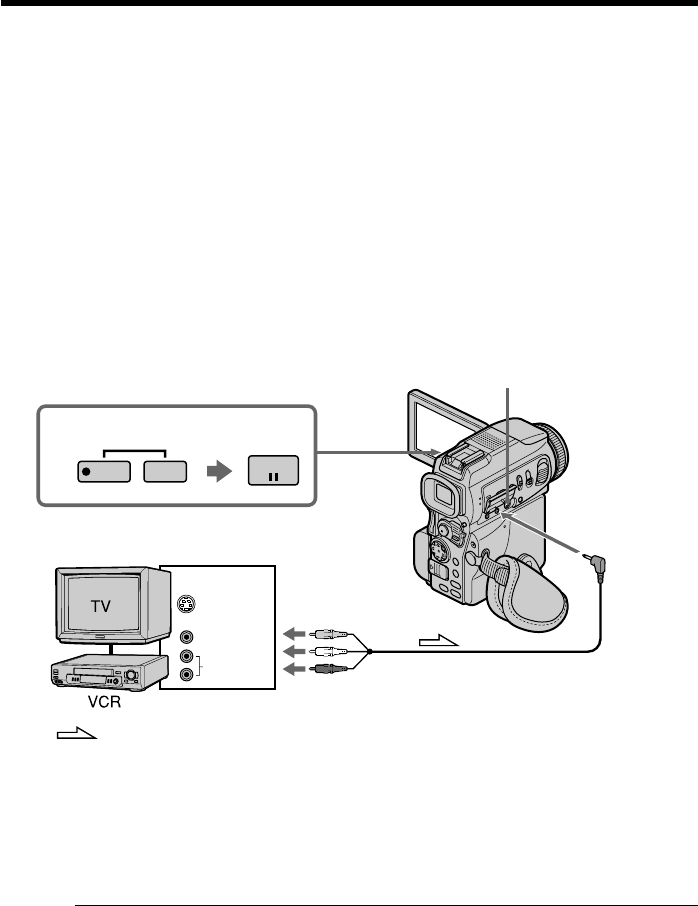
80
Recording video or TV programs
Using the A/V connecting cable
You can record a tape from another VCR or a TV program from a TV that has video/
audio outputs. Use your camcorder as a recorder.
Before operation
Set DISPLAY to LCD in the menu settings. (The default setting is LCD.)
(1)Insert a blank tape (or a tape you want to record over) into your camcorder. If
you are recording a tape from the VCR, insert a recorded tape into the VCR.
(2)Set the POWER switch to VCR on your camcorder.
(3)Press z REC and the button on its right simultaneously on your camcorder,
then immediately press X on your camcorder.
(4)Press N on the VCR to start playback if you record a tape from a VCR. Select
a TV program if you record from a TV. The picture from a TV or VCR appears
on the screen.
(5)Press X on your camcorder at the scene where you want to start recording
from.
When you have finished dubbing a tape
Press x on both your camcorder and the VCR.
Using the Remote Commander
In step 3, press z REC and MARK simultaneously, then immediately press X. And in
step 5, press X at the scene where you want to start recording from.
If your VCR is a monaural type
Connect the yellow plug of the A/V connecting cable to the video output jack and the
white or the red plug to the audio output jack on the VCR or the TV. When the white
plug is connected, the left channel audio is output, and when the red plug is connected,
the right channel audio is output.
3
PAUSE
REC
S VIDEO
VIDEO
AUDIO
OUT
AUDIO/
VIDEO
S VIDEO
: Signal flow
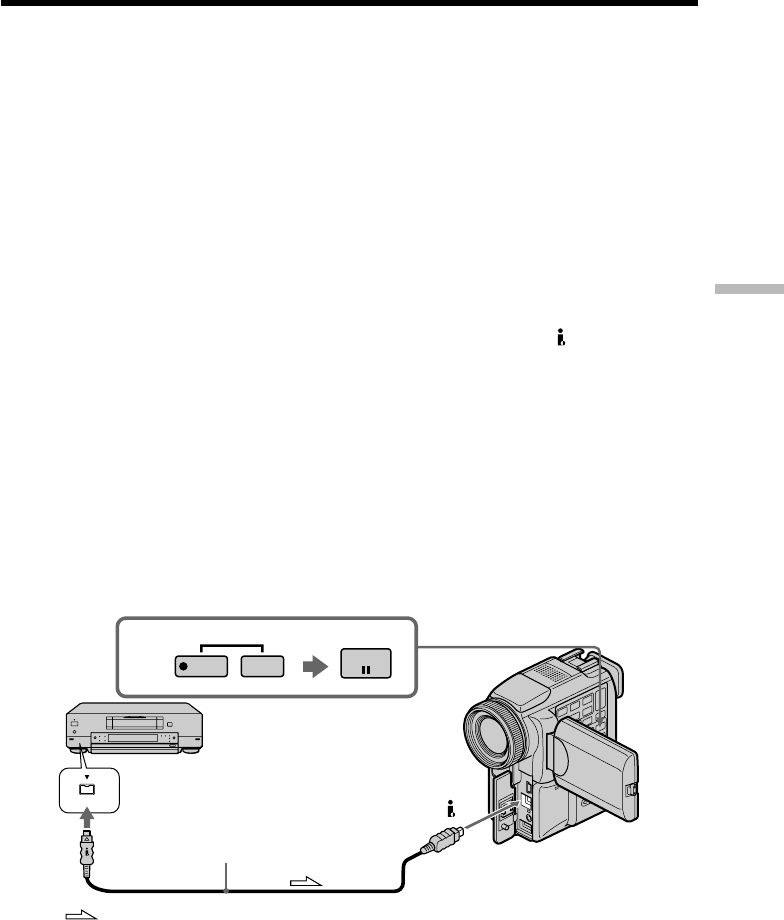
81
Editing
If your TV or VCR has an S video jack
Pictures can be reprodeced more faithfully by using an S video cable (optional).
With this connection, you do not need to connect the yellow (video) plug of the A/V
connecting cable.
Connect an S video cable (optional) to the S video jacks of both your camcorder and the
TV or VCR.
This connection produces higher quality DV format pictures.
Note on the Remote Commander
Your camcorder works in the commander mode VTR 2. Commander modes 1, 2 and 3
are used to distinguish your camcorder from other Sony VCRs to avoid remote control
misoperation. If you use another Sony VCR in the commander mode VTR 2, we
recommend changing the commander mode or covering the sensor of the VCR with
black paper.
Using the i.LINK cable (DV connecting cable)
Simply connect the i.LINK cable (DV connecting cable) (optional) to DV jack of your
camcorder and to DV OUT of the DV products. With a digital-to-digital connection,
video and audio signals are transmitted in digital form for high-quality editing.
(1)Insert a blank tape (or a tape you want to record over) into your camcorder,
and insert the recorded tape into the VCR.
(2)Set the POWER switch to VCR on your camcorder.
(3)Press z REC and the button on its right simultaneously on your camcorder,
then immediately press X on your camcorder.
(4)Press N on the VCR to start playback. The picture to be recorded appears on
the screen.
(5)Press X on your camcorder at the scene where you want to start recording
from.
Recording video or TV programs
DV
3
DV OUT DV
PAUSE
REC
(optional)
: Signal flow

82
When you have finished dubbing a tape
Press x on both your camcorder and the VCR.
Using the Remote Commander
In step 3, press z REC and MARK simultaneously, then immediately press X. And in
step 5, press X at the scene where you want to start recording from.
You can connect one VCR only using the i.LINK cable (DV connecting cable)
During digital editing
The color of the display may be uneven. However, this does not affect the dubbed
picture.
If you record playback pause picture with the DV jack
The recorded picture becomes rough. And when you play back the picture using your
camcorder, the picture may jitter.
Before recording
Make sure that the DV IN indicator appears on the screen. The DV IN indicator may
appear on both equipment.
Note on the Remote Commander
Your camcorder works in the commander mode VTR 2. Commander modes 1, 2 and 3
are used to distinguish your camcorder from other Sony VCRs to avoid remote control
misoperation. If you use another Sony VCR in the commander mode VTR 2, we
recommend changing the commander mode or covering the sensor of the VCR with
black paper.
Recording video or TV programs
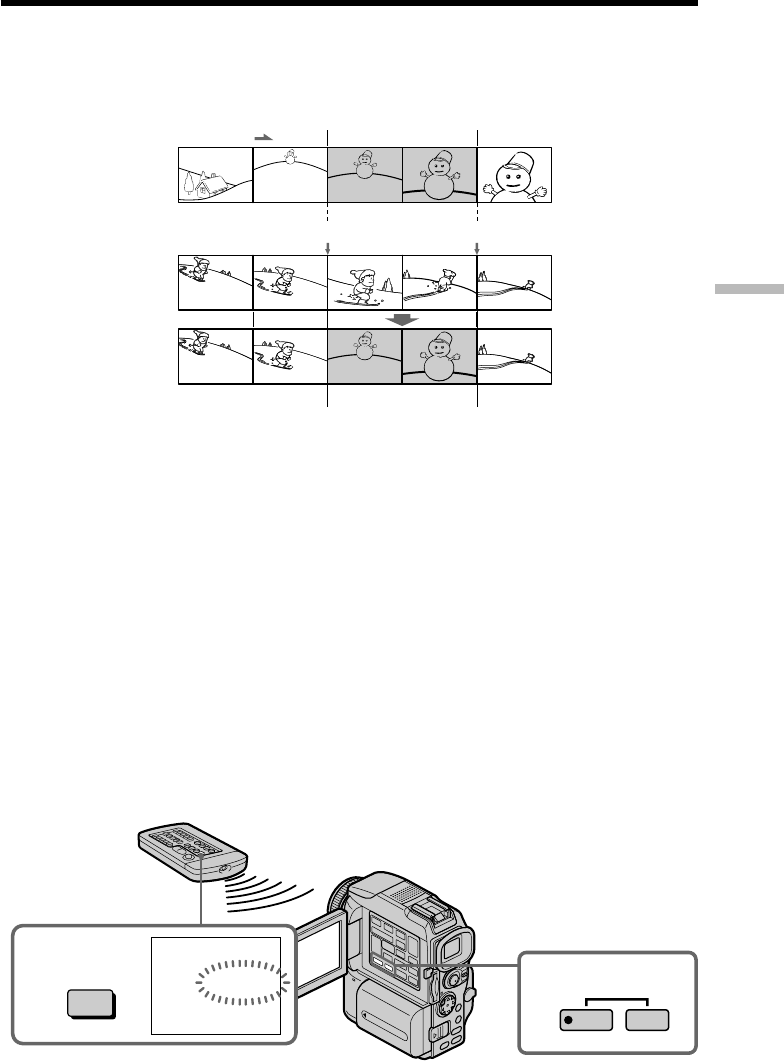
83
Editing
Inserting a scene from a VCR
– Insert editing
You can insert a new scene from a VCR onto your originally recorded tape by
specifying the insert start and end points. Use the Remote Commander for this
operation. Connections are the same as on page xx or xx.
Insert a cassette containing the desired scene to insert into the VCR.
[A]: A tape that contains the scene to be superimposed
[B]: A tape before editing
[C]: A tape after editing
(1)Set the POWER switch to VCR on your camcorder.
(2)On the connected VCR, locate just before the insert start point [a], then press
X to set the VCR to the playback pause mode.
(3)On your camcorder, locate the insert end point [c]. Then press X to set it to the
playback pause mode.
(4)Press ZERO SET MEMORY on the Remote Commander. The ZERO SET
MEMORY indicator flashes and the end point of the insert is stored in
memory. The tape counter shows “0:00:00.”
(5)On your camcorder, locate the insert start point [b] by pressing m, then press
z REC and the button on its right simultaneously.
(6)First press X on the VCR, and after a few seconds press X on your camcorder
to start inserting the new scene.
Inserting automatically stops near the zero point on the tape counter. Your
camcorder automatically returns to the recording pause mode.
4
0:00:00
ZERO SET
MEMORY
ZERO SET
MEMORY
5
REC
[a]
[b][c]
[A]
[B]
[C]

84
To change the insert end point
Press ZERO SET MEMORY again after step 5 to erase the ZERO SET MEMORY
indicator and begin from step 3.
Using the Remote Commander
In step 5, press z REC and MARK simultaneously, then immediately press X. And in
step 6, press X at the scene where you want to start recording from.
Note
The picture and sound recorded on the portion between the insert start and end points
will be erased when you insert the new scene.
If you insert scenes on the tape recorded with other camcorder (including other
DCR-PC115/PC120BT)
The picture and sound may be distorted. We recommend that you insert scenes on a
tape recorded with your camcorder.
When the inserted picture is played back
The picture and sound may be distorted at the end of the inserted portion. This is not a
malfunction.
The picture and sound at the start point and the end point may be distorted in the LP
mode.
To insert a scene without setting the insert end point
Skip steps 3 and 4. Press x when you want to stop inserting.
Note on the Remote Commander
Your camcorder works in the commander mode VTR 2. Commander modes 1, 2 and 3
are used to distinguish your camcorder from other Sony VCRs to avoid remote control
misoperation. If you use another Sony VCR in the commander mode VTR 2, we
recommend changing the commander mode or covering the sensor of the VCR with
black paper.
Inserting a scene from a VCR – Insert editing
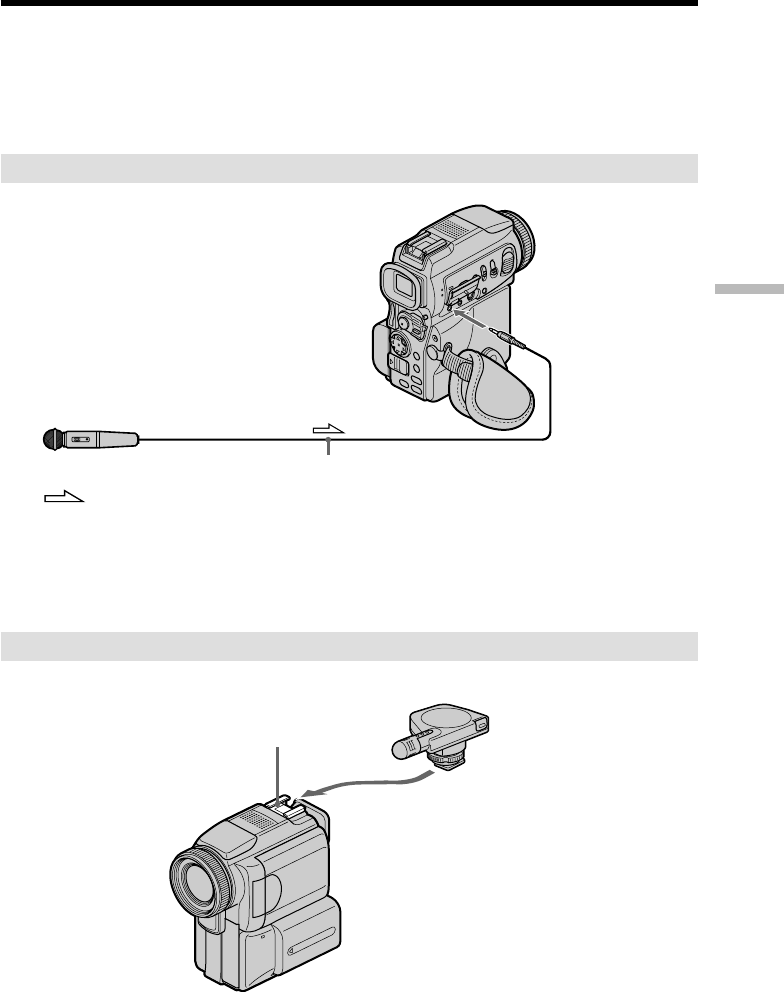
85
Editing
You can record an audio sound to add to the original sound on a tape by connecting
audio equipment or a microphone. If you connect the audio equipment, you can add
sound to your recorded tape by specifying starting and ending points. The original
sound will not be erased.
Use the Remote Commander for this operation.
Select one of the following connections to add an audio sound.
Connecting the microphone with the MIC jack
You can check the recorded picture and sound by connecting the AUDIO/VIDEO jack
to a TV.
The recorded sound is not output from a speaker. Check the sound by using the TV or
headphones.
Connecting the microphone with the intelligent accessory shoe
Audio dubbing
Microphone (optional)
Intelligent Accessory Shoe
Microphone (optional)
: Signal flow
MIC
(PLUG IN POWER)
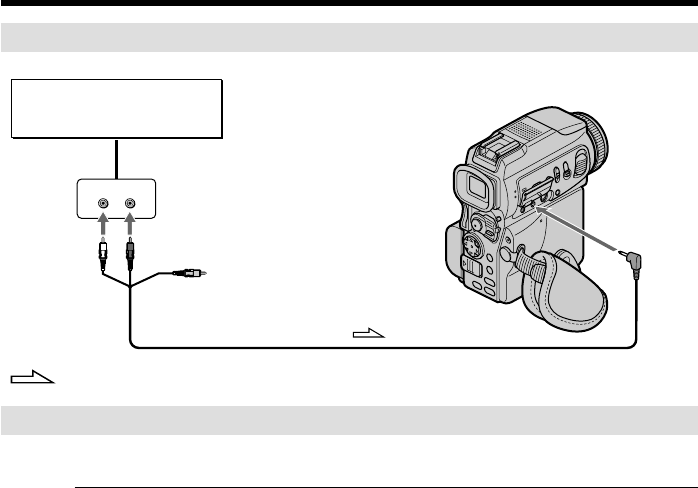
86
Connecting the A/V connecting cable to the AUDIO/VIDEO jack
Dubbing with the built-in microphone
No connection is necessary.
Note
When dubbing with the AUDIO/VIDEO jack or the built-in microphone, pictures are
not output through S VIDEO jack or the AUDIO/VIDEO jack. Check the recorded
picture on the screen. You can check the recorded sound by using headphones.
If you make all the connections
The audio input to be recorded will take precedence over others in the following order:
•MIC (PLUG IN POWER) jack
•Intelligent accessory shoe
•AUDIO/VIDEO jack
•Built-in microphone
Audio dubbing
LINE OUT
LR
AUDIO/
VIDEO
Audio equipment
Do not connect the
video (yellow) plug.
: Signal flow
AUDIO L AUDIO R
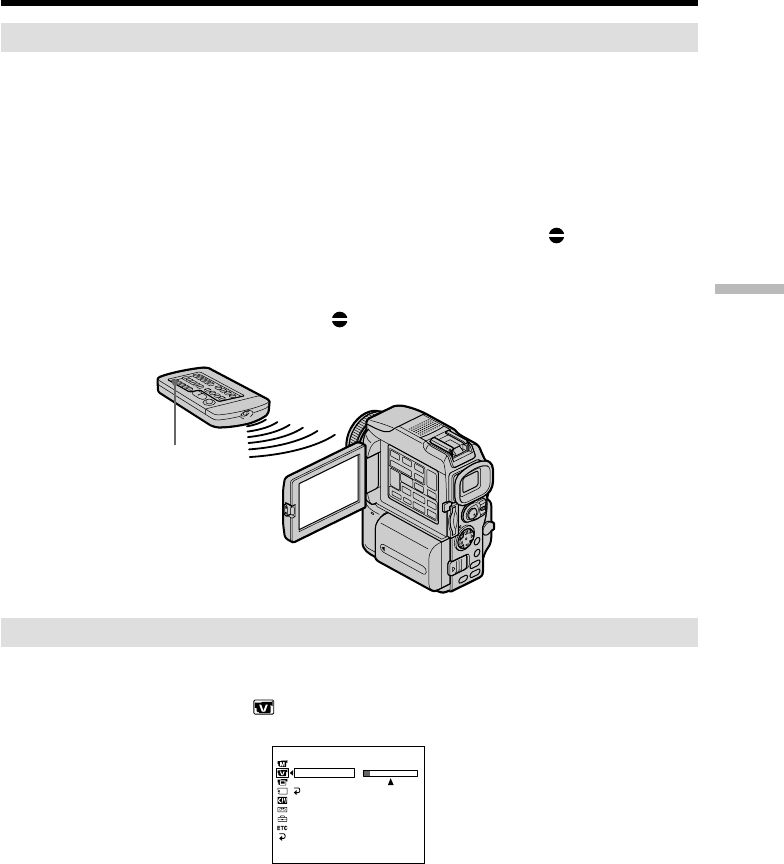
87
Editing
Adding an audio sound on a recorded tape
Choose a connection mentioned before, and connect audio equipment or microphone to
your camcorder. Then follow the procedure below.
(1)Insert the recorded tape into your camcorder.
(2)Set the POWER switch to VCR on your camcorder.
(3)Locate the recording start point by pressing N. Then press X at the point
where you want to start recording to set your camcorder to the playback pause
mode.
(4)Press AUDIO DUB on the Remote Commander. The green X indicator
appears on the screen.
(5)Press X and start playing back the audio you want to record at the same time.
The new sound is recorded in stereo 2 (ST2) during playback. During
recording new sound, the red appears on the screen.
(6)Press x at the point where you want to stop recording.
Monitoring the new recorded sound
To play back the sound
Adjust the balance between the original sound (ST1) and the new sound (ST2) by
selecting AUDIO MIX in in the menu settings (p. xx).
Five minutes after when you disconnect the power source or remove the battery pack,
the setting of AUDIO MIX returns to the original sound (ST1) only. The default setting
is original sound only.
Audio dubbing
ST1 ST2
VCR SET
RETURN
HiFi SOUND
AUD I O M I X
A
/
V
c
DV OUT
[
MENU
] :
END
AUDIO DUB

88
Audio dubbing
Notes
•New sound cannot be recorded on a tape already recorded in the 16-bit mode (32 kHz,
44.1 kHz or 48 kHz).
•New sound cannot be recorded on a tape already recorded in the LP mode.
•You cannot add audio with the DV jack.
•You cannot add audio on the blank portion of the tape.
If an i.LINK cable (DV connecting cable) (optional) is connected to your camcorder
You cannot add a sound to a recorded tape.
We recommend that you add new sound on a tape recorded with your camcorder
If you add new sound on a tape recorded with another camcorder (including other
DCR-PC115/PC120BT), the sound quality may become worse.
If you set the write-protect tab of the tape to lock
You cannot record on a tape. Slide the write-protect tab to release the write protection.
To add new sound more precisely
Press ZERO SET MEMORY on the Remote Commander at the point where you want to
stop recording later in the playback mode.
Carry out from steps 3 to 5. Recording automatically stops at the point where ZERO
SET MEMORY was pressed.
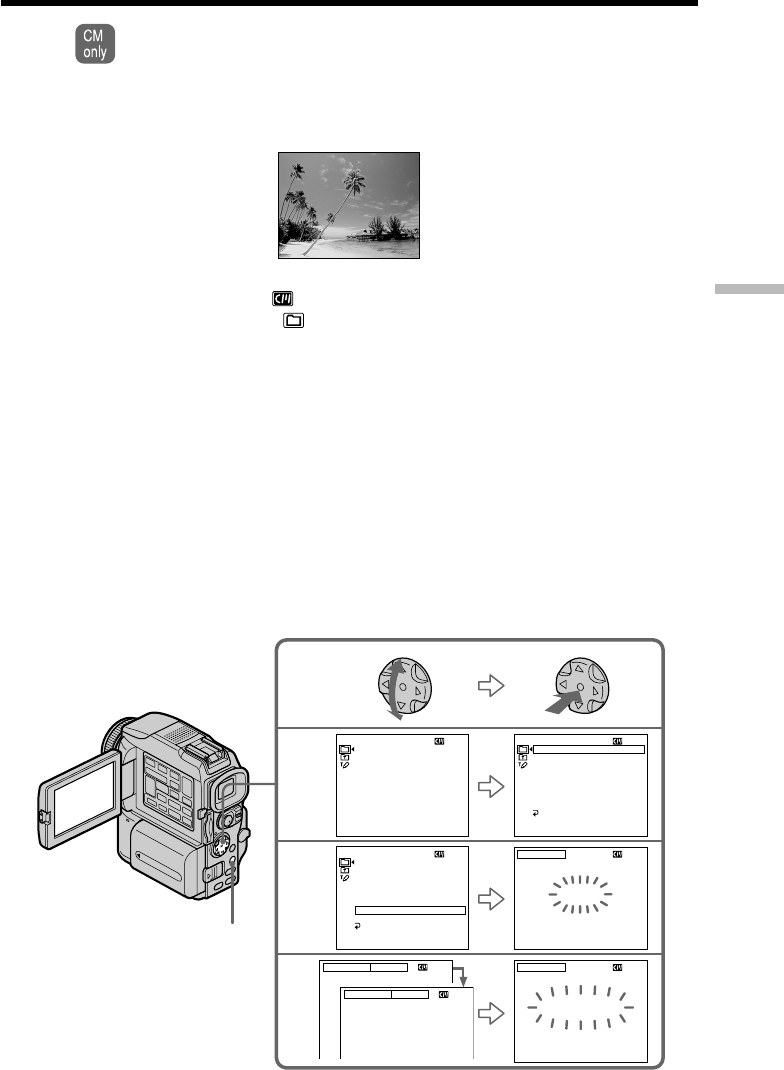
89
Editing
Superimposing a title
If you use a tape with cassette memory, you can superimpose the title. When
you play back the tape, the title is displayed for five seconds from the point
where you superimposed it.
You can select one of eight preset titles and two custom titles (p. xx). You can also select
the color, size and position of titles.
(1)Set the POWER switch to CAMERA or VCR. Press MENU, then select and
decide upon TITLE in with the control button (p. xx).
(2)Select and decide upon with the control button.
(3)Select and decide upon the desired title with the control button. The title
flashes.
(4)Change the color, size, or position, if necessary.
1Select and decide upon the COLOR, SIZE or POSITION with the control
button. The item appears.
2Select and decide upon the desired item with the control button.
3Repeat steps 1 and 2 until the title is laid out as desired.
(5)Press z on the control button again to complete the setting.
In the recording, playback or playback pause mode:
The TITLE SAVE indicator appears on the screen for five seconds and the title
is set.
In the standby mode:
The TITLE indicator appears. And when you press START/STOP to start
recording, TITLE SAVE appears on the screen for five seconds and the title is
set.
VACATION
2
3
4
SIZE SMALL
VACATION
SIZE LARGE
PRESET T I TLE
HELLO
!
HAPPY B I RTHDAY
HAPPY HOL I DAYS
CONGRA TUL AT I ONS
!
OUR S
W
EET BABY
W
EDD I NG
VACAT ION
THE END
[
MENU
]:
END
PRESET T I TLE
HELLO
!
HAPPY B I RTHDAY
HAPPY HOL I DAYS
CONGRA TUL AT I ONS
!
OUR S
W
EET BABY
W
EDD I NG
VACAT ION
THE END
[
MENU
]:
END
RETURN
PRESET T I TLE
HELLO
!
HAPPY B I RTHDAY
HAPPY HOL I DAYS
CONGRA TUL AT I ONS
!
OUR S
W
EET BABY
W
EDD I NG
VACAT ION
THE END
[
MENU
]:
END
RETURN
VACATION
TITLE
[
EXEC
]: :
SAVE
[
MENU
]
END
VACATION
TITLE
[
EXEC
]: :
SAVE
[
MENU
]
END
MENU

90
Superimposing a title
If you set the write-protect tab of the tape to lock
You cannot superimpose or erase the title. Slide the write-protect tab to release the write
protection.
To use the custom title
If you want to use the custom title, select in step 2.
If the tape has a blank portion
You cannot superimpose a title on the portion.
If the tape has a blank portion in the middle of the recorded parts
The title may not be displayed correctly.
The titles superimposed with your camcorder
•They are displayed by only the DV format video equipment with index titler
function.
•The point you superimposed the title may be detected as an index signal when
searching a recording with other video equipment.
If the tape has too many index signals
You may not be able to superimpose a title because the memory is full. In this case,
delete data you do not need.
Not to display titles
Set TITLE DSPL to OFF in the menu settings (p. xx).
Title setting
•The title color changes as follows:
WHITE y YELLOW y VIOLET y RED y CYAN y GREEN y BLUE
•The title size changes as follows:
SMALL y LARGE
You cannot input 13 characters or more in LARGE size. If you input more than 12
characters, the title size returns to SMALL even you select LARGE.
•If you select SMALL, you have nine choices for the title position.
If you select LARGE, you have eight choices for the title position.
One cassette can have up to about 20 titles, if one title consists of five characters
However, if the cassette memory is full with date, photo and cassette label data, one
cassette can have only up to about 11 titles with five characters each.
Cassette memory capacity is as follows:
–6 date data
–12 photo data
–1 cassette label
If the “ FULL” mark appears
The cassette memory is full. Erase the title you do not need.
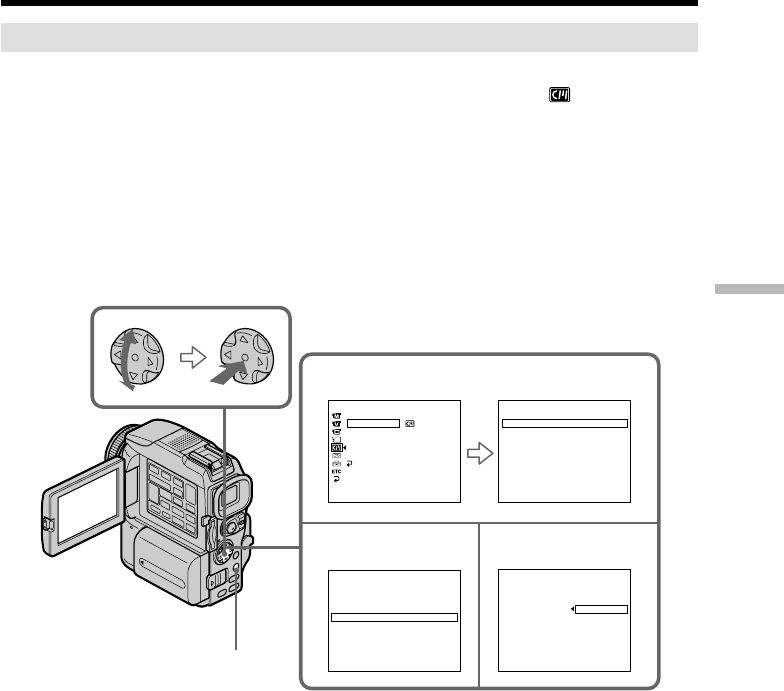
91
Editing
Erasing a title
(1)Set the POWER switch to CAMERA or VCR.
(2)Press MENU, then select and decide upon TITLEERASE in with the control
button (p. xx).
(3)Select and decide upon the title you want to erase with the control button.
ERASE OK ? indicator appears.
(4)Make sure the title is the one you want to erase, and select and decide upon
OK with the control button. OK changes to EXECUTE.
(5)Select and decide upon EXECUTE with the control button.
ERASING flashes on the screen. When the title is erased, COMPLETE is
displayed.
To cancel erasing a title
Select and decide upon RETURN in step 5.
Superimposing a title
2
34
CM SE T
TITLE
TITLEERASE
T I TLE DSPL
CM SEARCH
TAPE T I TLE
ERASE AL L
[
MENU
] :
END
[
MENU
] :
END
TITLE ERASE
1
HELLO
!
2
CONGRATULAT IONS
!
3
HAPPY NE
W
YEAR
!
4
PRESENT
5
GOOD
M
ORNING
6
W
EDD I NG
4
PRESENT
ERASE O OK
K
?
RETURN
[
MENU
] :
END
T I TLE ERASE
RETURN
[
MENU
] :
END
TITLE ERASE
1
HELLO
!
2
CONGRATULAT IONS
!
3
HAPPY NE
W
YEAR
!
4
PRESENT
5
GOOD
M
ORNING
6
W
EDD I NG
MENU
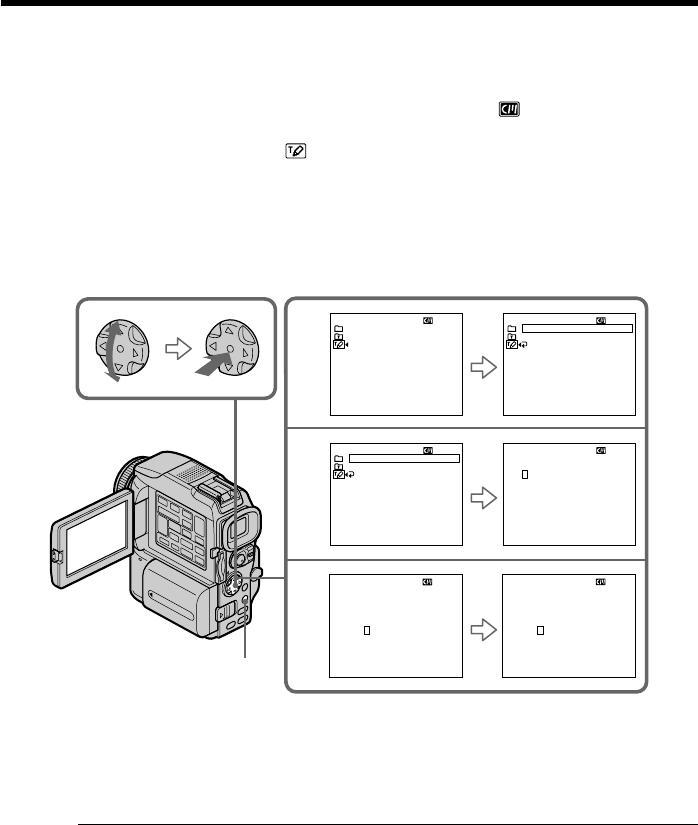
92
Making your own titles
You can make up to two titles and store them in the memory of your camcorder. Each
title can have up to 20 characters.
(1)Set the POWER switch to CAMERA or VCR.
(2)Press MENU, then select and decide upon TITLE in with the control
button (p. xx).
(3)Select and decide upon with the control button.
(4)Select and decide upon CUSTOM1 SET or CUSTOM2 SET with the control
button.
(5)Select and decide upon the desired character with the control button.
(6)Repeat steps 5 to complete making your own title.
(7)To finish making your own titles, select and decide upon [SET] with the
control button.
To change a title you have stored
In step 4, select the original title you want to change, and then press z on the control
button.
Select [C] to select the title to delete, then press z to delete the last character of your
title. Enter the new title as desired.
If you take five minutes or longer to enter characters in the standby mode while a
cassette is in your camcorder
The power automatically goes off. The characters you have entered remain stored in
memory. Set the POWER switch to OFF (CHG) once and then to CAMERA again, then
proceed from step 1.
We recommend setting the POWER switch to VCR or removing the cassette so that
your camcorder does not automatically turn off while you are entering title characters.
To erase the title
Select [C]. The last character is erased.
To enter a space
Select [ Z& ? ! ], then select the blank part.
3
4
5
____________________
TITLE SET
ABCDE
FGH I J
KLMNO
PQRST
UV
W
XY
Z
&?!
12345
67890
’.,/–
[
SET
]
[
MENU
]:
END
____________________
TITLE SET
ABCDE
FGH I J
KLMNO
PQRST
UV
W
XY
Z
&?!
12345
67890
’.,/–
[
SET
]
[
MENU
]:
END
S
___________________
TITLE SET
ABCDE
FGH I J
KLMNO
PQRST
UV
W
XY
Z
&?!
12345
67890
’.,/–
[
SET
]
[
MENU
]:
END
CUSTOM
1
TITLE SET
CUSTOM
2
[
MENU
]:
END
RETURN
TES TES
TITLE SET
CUSTOM
1
CUSTOM
2
[
MENU
]:
END
TES TES CUSTOM
1
TITLE SET
CUSTOM
2
[
MENU
]:
END
RETURN
TES TES
[
C
]
[
C
]
[
C
]
MENU
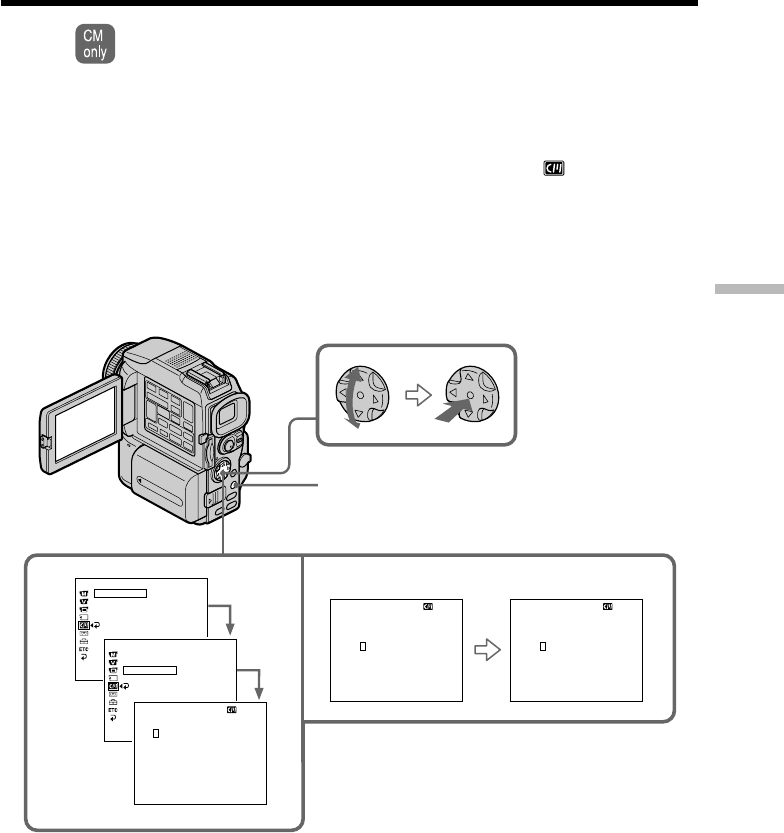
93
Editing
Labeling a cassette
If you use a tape with cassette memory, you can label a cassette. The label can
consist of up to 10 characters and is stored in cassette memory. When you insert
the labelled cassette and turn the power on, the label is displayed for about
five seconds.
(1)Insert the cassette you want to label.
(2)Set the POWER switch to CAMERA or VCR.
(3)Press MENU, then select and decide upon TAPE TITLE in with the control
button (p. xx).
Tape title display appears.
(4)Select and decide upon the desired character with the control button.
(5)Repeat steps 4 until you complete the label.
(6)Select and decide upon [SET] with the control button.
The label is stored in memory.
34
CM SE T
ERASE AL L
T I TLEERASE
TAPE T I TLE
RETURN
[
MENU
] :
END
__________
TAPE T I TLE
ABCDE
FGH I J
KLMNO
PQRST
UV
W
XY
Z
&?!
12345
67890
’.,/–
[
C
•]
[
SET
]
[
MENU
] :
END
M
_________
TAPE T I TLE
ABCDE
FGH I J
KL
M
NO
PQRST
UV
W
XY
Z
&?!
12345
67890
’.,/–
[
C
•]
[
SET
]
[
MENU
] :
END
TITLE YDAR E
CM SE T
TITLEERASE
__________
TAPE T I TLE
ERASE AL L
RETURN
[
MENU
] :
END
TITLE
__________
TAPE T I TLE
ABCDE
FGH I J
KLMNO
PQRST
UV
W
XY
Z
&?!
12345
67890
’.,/–
[
C
]
[
SET
]
[
MENU
] :
END
MENU
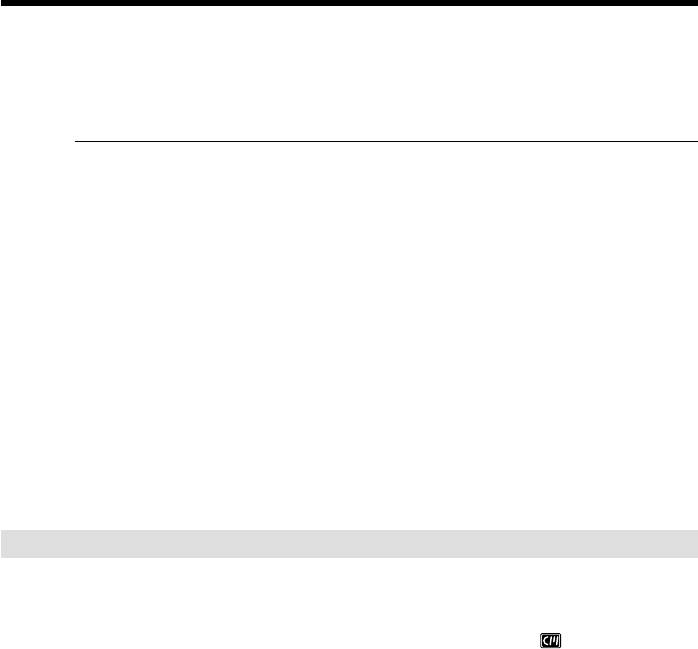
94
To erase the label you have made
Select and decide upon [C] with the control button in step 4. The last character is erased.
To change the label you have made
Insert the cassette to change the label, and operate in the same way to make a new label.
If you set the write-protect tab of the tape to lock
You cannot label a cassette. Slide the write-protect tab to release the write protection.
If the tape has too many index signals
You may not be able to label a cassette because the memory is full. In this case, delete
data you do not need.
If you have superimposed titles in the cassette
When the label is displayed, up to four titles also appear.
When the “-----” indicator has fewer than 10 spaces
The cassette memory is full.
The “-----” indicates the number of characters you can select for the label.
To erase the character
Press [C]. The last character is erased.
To enter a space
Select [ Z& ? ! ], then select the blank part.
Erasing all the data in cassette memory
You can erase all the data in cassette memory at once.
(1)Set the POWER switch to CAMERA or VCR.
(2)Press MENU, then select and decide upon ERASE ALL in with the control
button (p. xx).
(3)Select and decide upon OK with the control button. OK changes to EXECUTE.
(4)Select and decide upon EXECUTE with the control button. ERASING flashes
on the screen. When all the data is erased, COMPLETE is displayed.
To cancel deleting
Select and decide upon RETURN with the control button in step 4.
Labeling a cassette
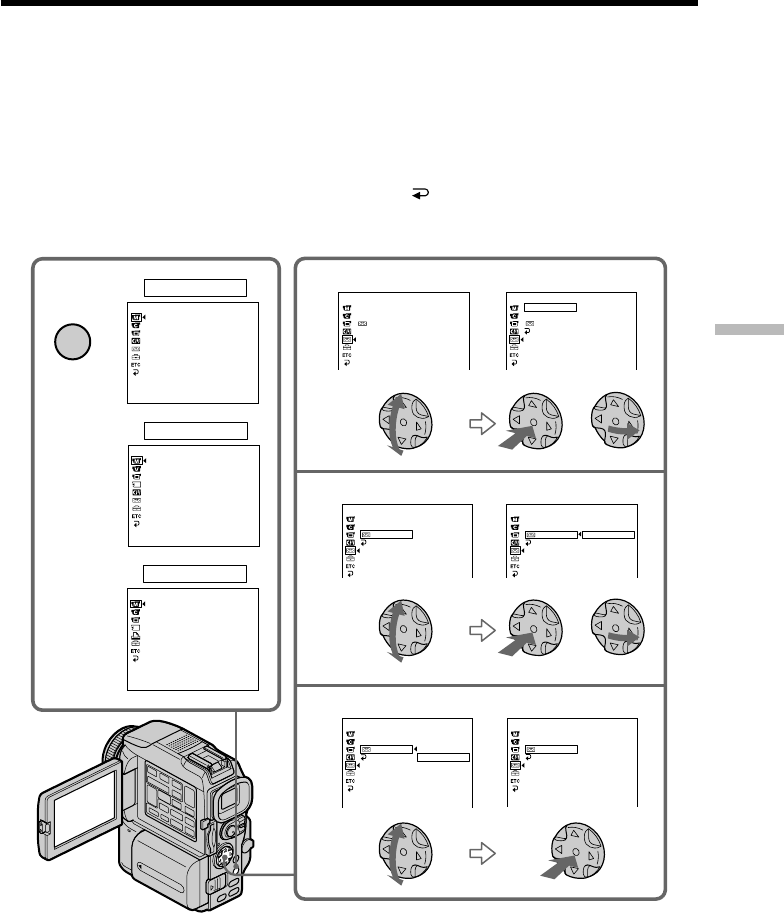
95
Customizing Your Camcorder
To change the mode settings in the menu settings, select the menu items with the
control button. The default settings can be partially changed. First, select the icon, then
the menu item and then the mode.
(1)Set the POWER switch to CAMERA, VCR or MEMORY, press MENU.
(2)Press v/V on the control button to select the desired icon, then press z or B.
(3)Press v/V on the control button to select the desired item, then press z or B.
(4)Press v/V on the control button to select the desired mode, then press z.
(5)If you want to change other items, select RETURN and press z or b, then
repeat steps 2 to 4.
For details, see “Selecting the mode setting of each item” (p. xx).
— Customizing Your Camcorder —
Changing the menu settings
CAMERA
VCR
MEMORY
MANUA L SET
PROGRAM AE
PEFFECT
DEFFECT
W
HT BAL
AUTO SHTR
[
MENU
] :
END
MANUA L SET
PEFFECT
DEFFECT
[
MENU
] :
END
MANUA L SET
PROGRAM AE
W
HT BAL
[
MENU
] :
END
TAPE SET
REC MODE
AUD I O MO D
REMA I N
RETURN AUTO
ON
[
MENU
]
:
END
MENU
TAPE SET
R
EC MODE
AUD I O MODE
REMAIN
TAPE SET
REC MODE
AUD I O MODE
REMA I N
RETURN AUTO
TAPE SET
REC MODE
AUD I O MODE
REMA I N
RETURN ON
[
MENU
]
:
END
TAPE SET
R
EC MODE SP
AUD I O MODE
REMA I N
RETURN
TAPE SET
REC MODE
AUD I O MODE
REMA I N
RETURN AUTO
ON
12
3
4
or
or
To make the menu display disappear
Press MENU.
This manual refers to selecting and deciding upon items by the
above procedure as “Select and decide upon [(item name)].”
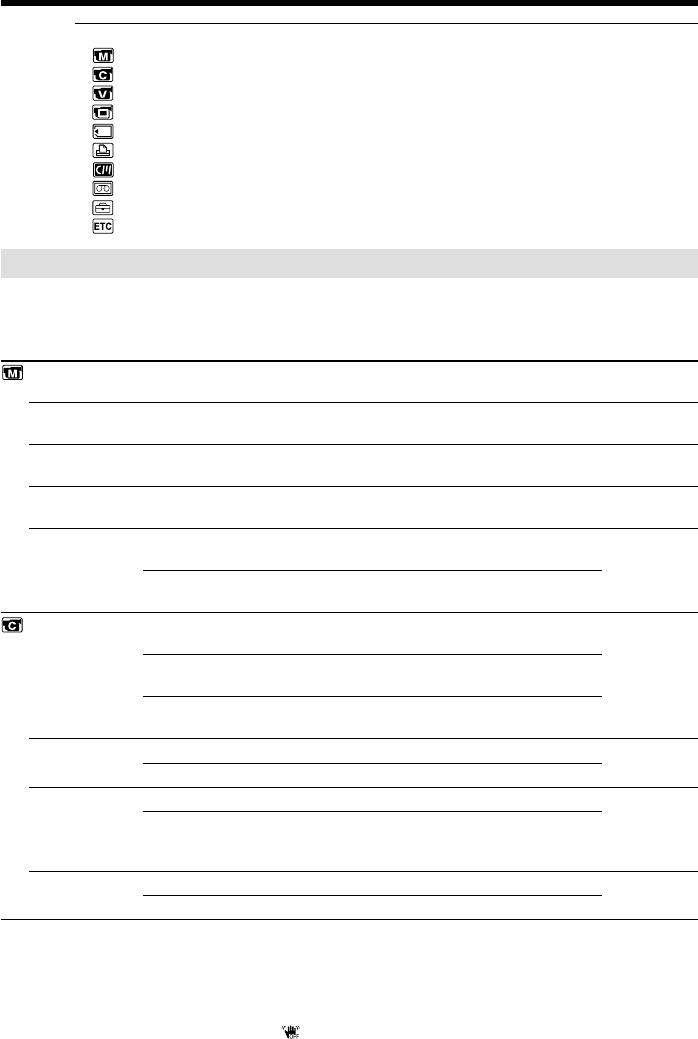
96
Changing the menu settings
Menu items are displayed as the following icons:
MANUAL SET
CAMERA SET
VCR SET
LCD/VF SET
MEMORY SET
PRINT SET
CM SET
TAPE SET
SETUP MENU
OTHERS
Selecting the mode setting of each item z is the default setting.
Menu items differ depending on the position of the POWER switch. The screen shows
only the items you can operate at the moment.
Mode
——
——
——
——
zON
OFF
zOFF
20×
120×
zOFF
ON
zON
OFF
zON
OFF
Meaning
To suit your specific shooting requirement
(p. xx).
To add special effects like those in films or on
the TV to images (p. xx, xx).
To add special effects using the various digital
functions (p. xx).
To adjust the white balance (p. xx).
To automatically activate the electronic shutter
when shooting in bright conditions.
Not to automatically activate the electronic
shutter even when shooting in bright conditions.
To deactivate the digital zoom. Up to 10× zoom
is carried out.
To activate the digital zoom. More than 10× to
20× zoom is performed digitally (p. xx).
To activate the digital zoom. More than 10× to
120× zoom is performed digitally (p. xx).
—
To record a 16:9 wide picture (p. xx).
To compensate for camera-shake.
To cancel the SteadyShot function. Natural
pictures are produced when shooting a
stationary object with a tripod.
To use the NightShot Light function (p. xx).
To cancel the NightShot Light function.
POWER
switch
CAMERA
MEMORY
VCR
CAMERA
VCR
CAMERA
CAMERA
MEMORY
CAMERA
CAMERA
CAMERA
CAMERA
CAMERA
MEMORY
Notes on the SteadyShot function
•The SteadyShot function will not correct excessive camera-shake.
•Attachment of a conversion lens (optional) may influence the SteadyShot function.
If you cancel the SteadyShot function
The SteadyShot off indicator appears. Your camcorder prevents excessive
compensation for camera-shake.
Icon/item
PROGRAM AE
P EFFECT
D EFFECT
WHT BAL
AUTO SHTR
D ZOOM
16:9WIDE
STEADYSHOT
N.S. LIGHT
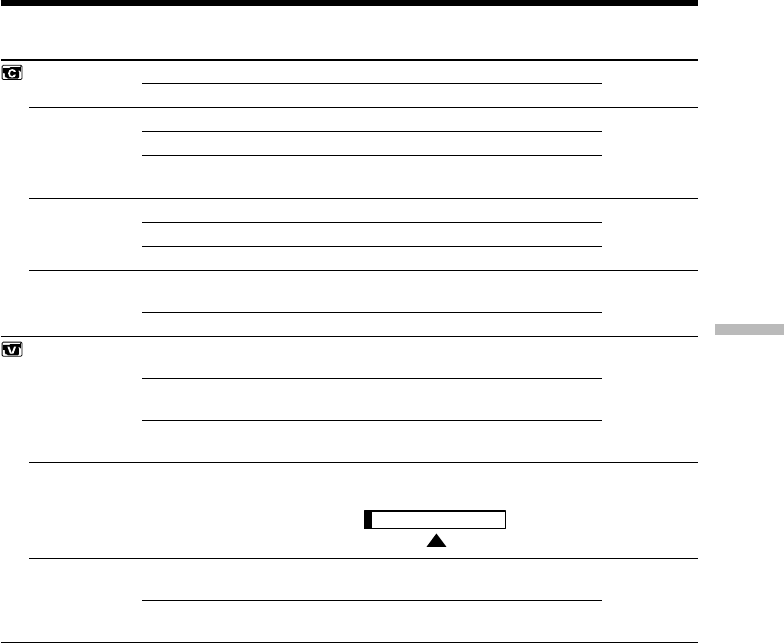
97
Customizing Your Camcorder
Icon/item
FRAME REC
INT. REC
FLASH LVL
HOLOGRAM F
HiFi SOUND
AUDIO MIX
A/VtDV OUT
Mode
zOFF
ON
ON
zOFF
SET
HIGH
zNORMAL
LOW
zAUTO
OFF
zSTEREO
1
2
——
zOFF
ON
Meaning
To deactivate Cut recording function.
To activate Cut recording function (p. xx).
To activate Interval recording function (p. xx).
To deactivate Interval recording function.
To set INTERVAL and REC TIME for Interval
recording function (p. xx).
Makes the flash level higher than normal.
Normal setting.
Makes the flash level lower than normal.
The HOLOGRAM AF emits when focusing on
subjects is difficult in dark places (p. xx).
The HOLOGRAM does not emit.
To play back a stereo tape or dual sound track
tape with main and sub sound (p. xx).
To play back a stereo tape with the left sound or
a dual sound tape with main sound.
To play back a stereo tape with the right sound
or a dual sound track tape with sub sound.
To adjust the balance between the stereo 1 and
stereo 2 (p. xx).
To output digital images and sound in analog
format using your camcorder.
To output analog images and sound in digital
format using your camcorder (p. xx).
Changing the menu settings
POWER
switch
CAMERA
CAMERA
CAMERA
MEMORY
MEMORY
VCR
VCR
VCR
ST1 ST2
Note on FLASH LVL
You cannot adjust FLASH LVL if the external flash (optional) is not compatible with the
flash level.
(Continued on the following page)
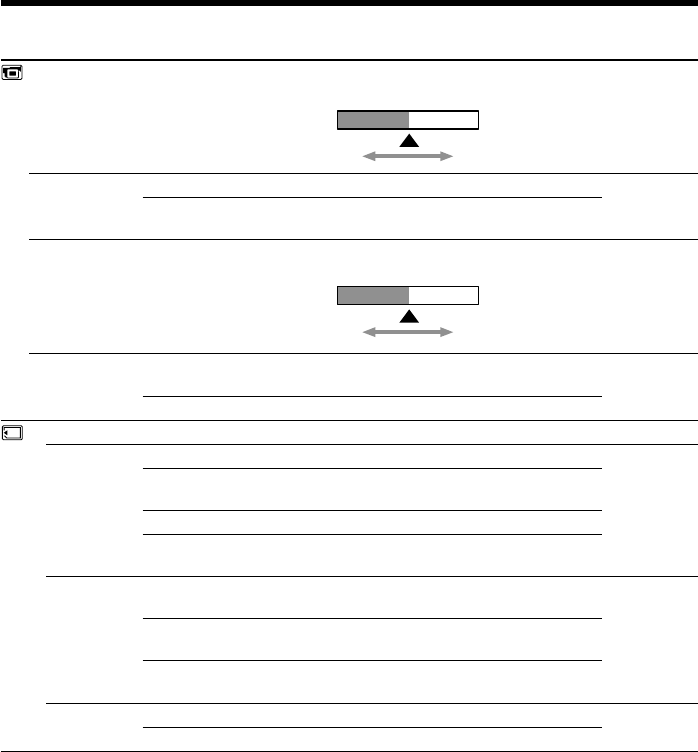
98
Changing the menu settings
Icon/item
LCD BRIGHT
LCD B. L.
LCD COLOR
VF B.L.
STILL SET
PIC MODE
QUALITY
IMAGESIZE
Mode
——
zBRT NORMAL
BRIGHT
——
zBRT NORMAL
BRIGHT
zSINGLE
NORMAL
HIGH SPEED
MULTI SCRN
zSUPER FINE
FINE
STANDARD
z1360 × 1020
640 × 480
Meaning
To adjust the brightness on the LCD screen with
b/B on the control button.
To set the brightness on the LCD screen normal.
To brighten the LCD screen.
To adjust the color on the LCD screen, press
b/B on the control button.
To set the brightness on the viewfinder screen to
normal.
To brighten the viewfinder screen.
Not to record continuously.
To record from three to nine images
continuously (p. xx).
To record up to 16 images continuously fast.
To record nine images continuously, display the
images on a single page divided into nine boxes.
To record still images in the finest image quality
mode (p. xx).
To record still images in the fine image quality
mode.
To record still images in the standard image
quality mode.
To record still images in 1360 × 1020 size (p. xx).
To record still images in 640 × 480 size.
POWER
switch
VCR
CAMERA
MEMORY
VCR
CAMERA
MEMORY
MEMORY
VCR
MEMORY
MEMORY
To get low-
intensity To get high-
intensity
To darken To lighten
Notes on LCD B.L. and VF B.L.
•When you select BRIGHT, battery life is reduced by about 10 percent during
recording.
•When you use power sources other than the battery pack, BRIGHT is automatically
selected.
Even if you adjust LDC BRIGHT, LCD B.L., LCD COLOR and/or VF B.L.
The recorded picture will not be affected.
VCR
CAMERA
MEMORY
VCR
CAMERA
MEMORY
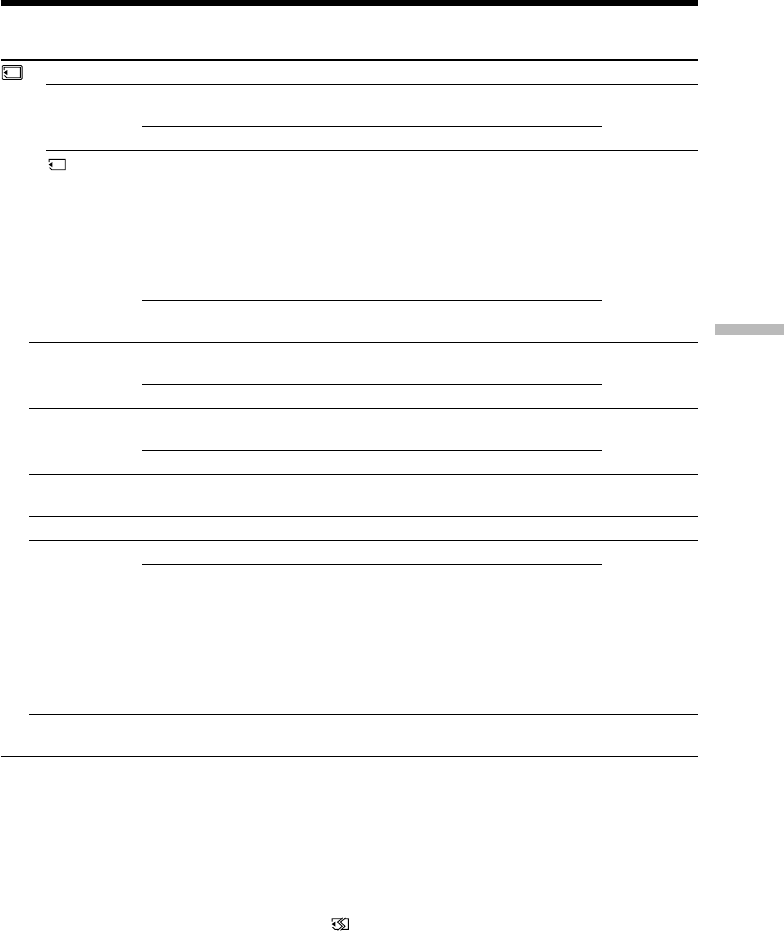
99
Customizing Your Camcorder
Icon/item
MOVIE SET
IMAGESIZE
REMAIN
PRINT MARK
PROTECT
SLIDE SHOW
DELETE ALL
FORMAT
PHOTO SAVE
Mode
z320 × 240
160 × 112
zAUTO
ON
ON
zOFF
ON
zOFF
——
——
zRETURN
OK
——
Meaning
To record moving pictures in 320 × 240 size
(p. xx).
To record moving pictures in 160 × 112 size.
To display the remaining capacity of the
“Memory Stick” in the following cases:
•For five seconds after inserting a “Memory
Stick” into your camcorder
•When the capacity of the “Memory Stick” is
less than 1 minute in MEMORY mode
•For five seconds after completing a moving
picture recording
To always display the remaining capacity of the
“Memory Stick.”
To write a print mark on the recorded still
images you want to print out later (p. xx).
To cancel print marks on still images.
To protect selected images against accidental
erasure (p. xx).
Not to protect images.
To play back images in a continuous loop
(p. xx).
To delete all the unprotected images (p. xx).
To cancel formatting.
To format an inserted “Memory Stick.”
1. Select FORMAT.
2. Select and decide upon OK with the control
button.
3. After EXECUTE appears, press z on the
control button. FORMATTING flashes during
formatting. COMPLETE appears when
formatting is finished.
To duplicate still images on tape onto “Memory
Stick” (p. xx).
POWER
switch
VCR
MEMORY
VCR
MEMORY
VCR
MEMORY
MEMORY
MEMORY
MEMORY
VCR
Changing the menu settings
Notes on formatting
•Supplied “Memory Stick”s have been formatted at factory. Formatting with this
camcorder is not required.
•Do not turn the POWER switch or press any button while the display shows
FORMATTING.
•You cannot format the “Memory Stick” if the write-protect tab on the “Memory Stick”
is set to LOCK.
•Format the “Memory Stick” when FORMAT ERROR is displayed.
Formatting erases all information on the “Memory Stick”
Check the contents of the “Memory Stick” before formatting.
• Formatting erases sample images on the “Memory Stick.”
• Formatting erases the protected image data on the “Memory Stick.”
VCR
MEMORY
(Continued on the following page)
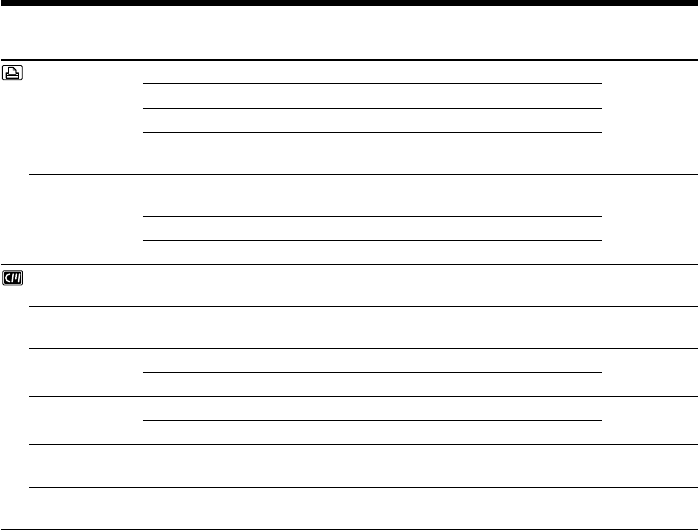
100
Icon/item
9PIC PRINT
DATE/TIME
TITLE
TITLEERASE
TITLE DSPL
CM SEARCH
TAPE TITLE
ERASE ALL
Mode
zRETURN
SAME
MULTI
MARKED
zOFF
DATE
DAY&TIME
——
——
zON
OFF
zON
OFF
——
——
Meaning
To cancel prints of split screen.
To make prints of same split screen (p. xx).
To make prints of different split screen.
To make prints of images with print marks in
recording order.
To make prints without the recording date and
time.
To make prints with the recording date (p. xx).
To make prints with the recording date and time.
To superimpose a title or make your own title
(p. xx).
To erase the title you have superimposed (p. xx).
To display the title you have superimposed.
Not to display the title.
To search using cassette memory (p. xx, xx, xx).
To search without using cassette memory.
To label a cassette (p. xx).
To erase all the data in cassette memory (p. xx).
POWER
switch
MEMORY
MEMORY
VCR
CAMERA
VCR
CAMERA
VCR
VCR
VCR
CAMERA
VCR
CAMERA
Changing the menu settings
Note on PRINT SET
9PIC PRINT and DATE/TIME are displayed only when an external printer (optional) is
connected to the intelligent accessory shoe.
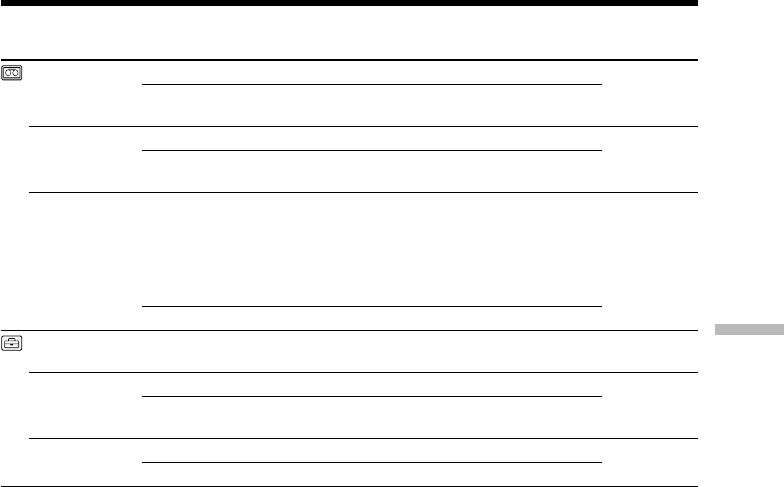
101
Customizing Your Camcorder
Icon/item
REC MODE
AUDIO MODE
qREMAIN
CLOCK SET
LTR SIZE
DEMO MODE
Mode
zSP
LP
z12BIT
16BIT
zAUTO
ON
——
zNORMAL
2×
zON
OFF
Meaning
To record in the SP (Standard Play) mode.
To increase the recording time to 1.5 times the
SP mode.
To record in the 12-bit mode (two stereo sounds).
To record in the 16-bit mode (one stereo sound
with high quality).
To display the remaining tape bar:
•for about eight seconds after a cassette is
inserted and your camcorder calculates the
remaining amount of tape.
•for about eight seconds after N or DISPLAY
is pressed.
To always display the remaining tape indicator.
To set the date or time (p. xx).
To display selected menu items in normal size.
To display selected menu items at twice the
normal size.
To make the demonstration appear.
To cancel the demonstration mode.
POWER
switch
VCR
CAMERA
VCR
CAMERA
VCR
CAMERA
CAMERA
MEMORY
VCR
CAMERA
MEMORY
CAMERA
Changing the menu settings
Notes on the LP mode
•When you record a tape in the LP mode on your camcorder, we recommend playing
the tape on your camcorder. When you play back the tape on other camcorders or
VCRs, noise may occur in pictures or sound.
•When you record in the LP mode, we recommend using a Sony Excellence/Master
cassette so that you can get the most out of your camcorder.
•You cannot make audio dubbing on a tape recorded in the LP mode. Use the SP mode
for the tape to be audio dubbed.
•When you record in the SP and LP modes on one tape or you record some scenes in
the LP mode, the playback picture may be distorted or the time code may not be
written properly between scenes.
Notes on AUDIO MODE
•You cannot dub audio sound on a tape recorded in the 16-bit mode.
•When playing back a tape recorded in the 16-bit mode, you cannot adjust the balance
in AUDIO MIX.
Notes on DEMO MODE
•You cannot select DEMO MODE when a cassette is inserted in your camcorder.
•When NIGHTSHOT is set to ON, the “NIGHTSHOT” indicator appears on the screen
and you cannot select DEMO MODE in the menu settings.
•DEMO MODE is set to STBY (Standby) as the default setting and the demonstration
starts about 10 minutes after you have set the POWER switch to CAMERA without a
cassette inserted.
To cancel the demonstration, insert a cassette, set the POWER switch to other than
CAMERA, or set DEMO MODE to OFF. To set to STBY (Standby) again, leave the
DEMO MODE at ON in the menu settings, turn the POWER switch OFF (CHG), and
return the POWER switch to CAMERA. (Continued on the following page)
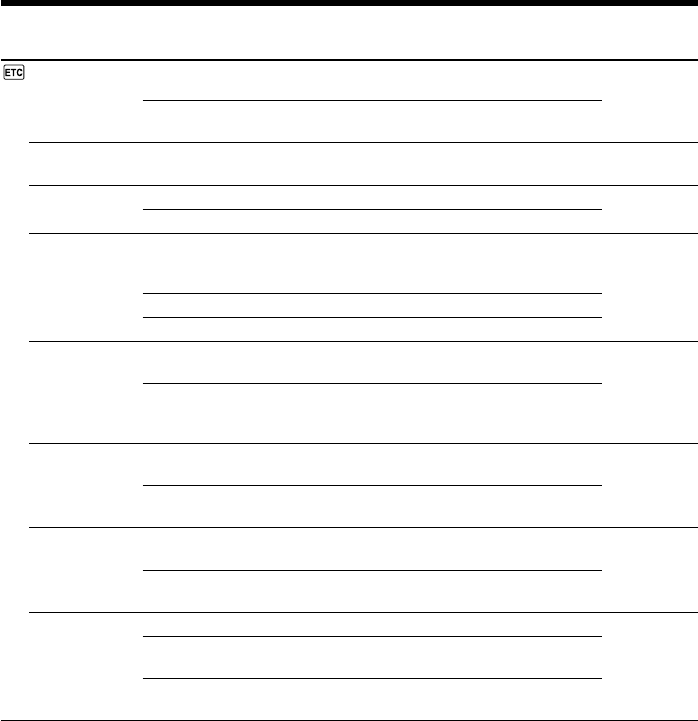
102
Icon/item
DATA CODE
AREA SET
SUMMERTIME
BEEP
COMMANDER
DISPLAY
REC LAMP
VIDEO EDIT
Meaning
To display date, time and various settings
during playback (p. xx).
To display date and time during playback
(p. xx).
Temporarily change the area where you are
using your camcorder.
Not during summer time.
During summer time.
To output the melody when you start/stop
recording or when an unusual condition occurs
on your camcorder.
To output the beep instead of the melody.
To cancel all sound including shutter sound.
To activate the Remote Commander supplied
with your camcorder.
To deactivate the Remote Commander to avoid
remote control misoperation caused by other
VCR’s remote control.
To show the display on the LCD screen and in
the viewfinder.
To show the display on the TV screen, LCD
screen and in the viewfinder.
To light up the camera recording lamp at the
front of your camcorder.
To turn the camera recording lamp off so that
the person is not aware of the recording.
To cancel video editing.
To make program and perform video editing
(p. xx).
To make program and perform MPEG editing
(p. xx).
Changing the menu settings
Mode
zDATE/CAM
DATE
——
zOFF
ON
zMELODY
NORMAL
OFF
zON
OFF
zLCD
V-OUT/LCD
zON
OFF
zRETURN
TAPE
MEMORY
Note
If you press DISPLAY with DISPLAY set to V-OUT/LCD in the menu settings, the
picture from a TV or VCR will not appear on the LCD screen even when your
camcorder is connected to outputs on the TV or VCR.
When recording a close subject
When REC LAMP is set to ON, the red camera recording lamp on the front of the
camcorder may reflect on the subject if it is close. In this case, we recommend you set
REC LAMP to OFF.
In more than five minutes after removing the power source
The PROGRAM AE, WHT BAL, FLASH LVL, HiFi SOUND, AUDIO MIX and
COMMANDER items are returned to their default settings.
The other menu items are held in memory even when the battery is removed.
POWER
switch
VCR
MEMORY
CAMERA
MEMORY
VCR
CAMERA
MEMORY
VCR
CAMERA
MEMORY
VCR
CAMERA
MEMORY
CAMERA
MEMORY
VCR
CAMERA
MEMORY
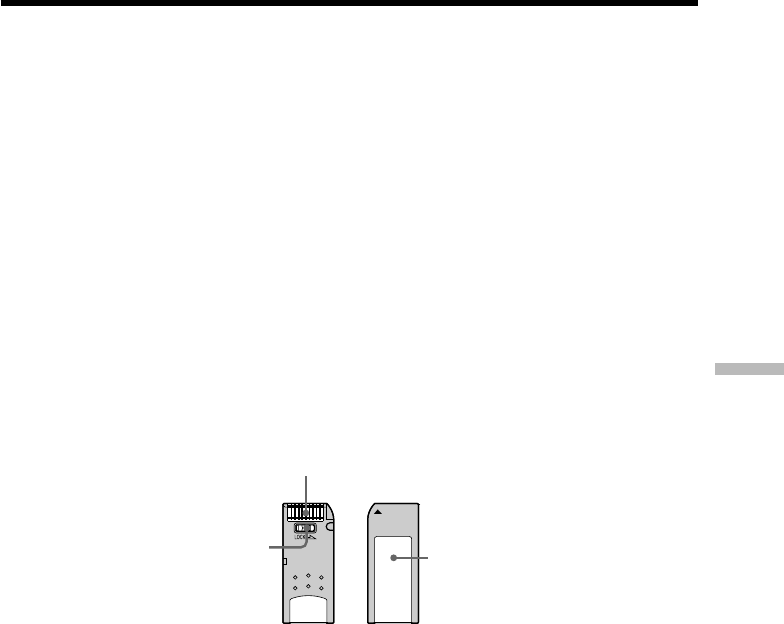
103
“Memory Stick” Operations
You can record and play back images on a “Memory Stick” supplied with your
camcorder. You can easily play back, record or delete images. You can exchange image
data with other equipment such as your computer etc., using the USB cable for
“Memory Stick” supplied with your camcorder.
On file format
Still image (JPEG)
Your camcorder compresses image data in JPEG format (extension .jpg).
Moving picture (MPEG)
Your camcorder compresses picture data in MPEG format (extension .mpg).
Typical image data file name
Still image
100-0001: This file name appears on the screen of your camcorder.
Dsc00001.jpg: This file name appears on the display of your computer.
Moving picture
MOV00001: This file name appears on the screen of your camcorder.
Mov00001.mpg: This file name appears on the display of your computer.
Using a “Memory Stick”
•You cannot record or erase images when the write-protect tab on the “Memory Stick”
is set to LOCK.
•The position and shape of the write-protect tab may be different depending on the
model.
•We recommend backing up important data on the hard desk of your personal
computor.
•Image data may be damaged in the following cases:
–If you remove the “Memory Stick” or turn the power off during reading or writing.
–If you use “Memory Stick”s near static electricity or magnetic fields.
•Prevent metallic objects or your finger from coming into contact with the metal parts
of the connecting section.
•Stick its label on the labeling position.
•Do not bend, drop or apply strong shock to “Memory Stick”s.
•Do not disassemble or modify “Memory Stick”s.
•Do not let “Memory Stick”s get wet.
•Do not use or keep “Memory Stick”s in locations that are:
–Extremely hot such as in a car parked in the sun or under the scorching sun.
–Under direct sunlight.
–Very humid or subject to corrosive gases.
•When you carry or store a “Memory Stick,” put it in its case.
— “Memory Stick” Operations —
Using a “Memory Stick” – introduction
Write-protect tab Labeling position
Terminal

104
“Memory Stick”s formatted by a computer
“Memory Stick”s formatted by Windows OS or Macintosh computers do not have a
guaranteed compatibility with this camcorder.
Notes on image data compatibility
•Image data files recorded on “Memory Stick”s by your camcorder conform with the
Design Rules for Camera File Systems universal standard established by the JEITA
(Japan Electronics and Information Technology Industries Association). You cannot
play back on your camcorder still images recorded on other equipment (DCR-
TRV890E/TRV900/TRV900E or DSC-D700/D770) that does not conform with this
universal standard. (These models are not sold in some areas.)
•If you cannot use the “Memory Stick” that is used with other equipment, format it
with this camcorder (p. xx). However, formatting erases all information on the
“Memory Stick.”
•“Memory Stick” and are trademarks of Sony Corporation.
•Windows and Windows Media are either registered trademarks or trademarks of
Microsoft Corporation in the United States and/or other countries.
•Macintosh and Mac OS, QuickTime are trademarks of Apple Computer, Inc.
•Real Player is either a registered trademark or treademark of RealNet works, Inc. in
the United States and/or other countries.
•All other product names mentioned herein may be the trademarks or registered
trademarks of their respective companies.
Furthermore, “™” and “®” are not mentioned in each case in this manual.
Using a “Memory Stick” – introduction
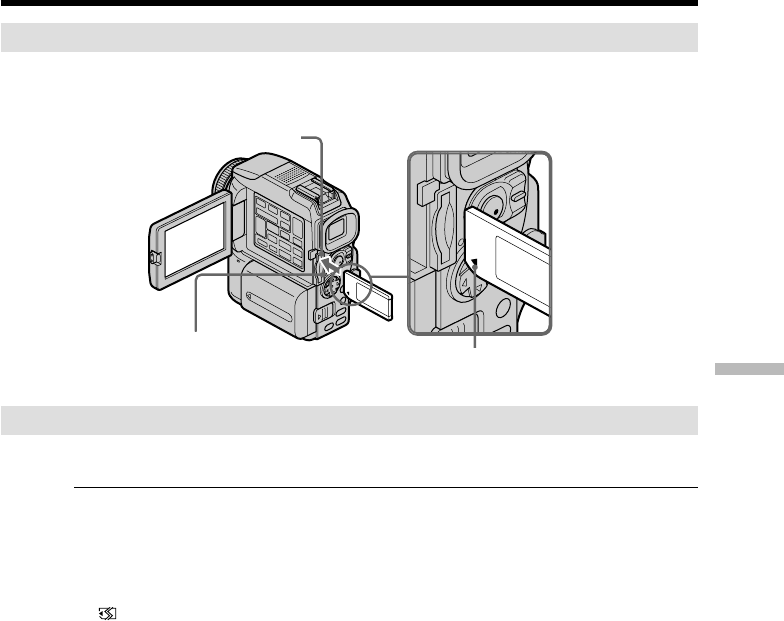
105
“Memory Stick” Operations
Inserting a “Memory Stick”
Insert a “Memory Stick” in the “Memory Stick” slot as far as it can go with the b mark
facing up as illustrated.
Ejecting a “Memory Stick”
Press the “Memory Stick” once lightly.
While the access lamp is lit or flashing
Do not shake or strike your camcorder because your camcorder is reading the data from
the “Memory Stick” or recording the data on the “Memory Stick.” Do not turn the
power off, eject a “Memory Stick” or remove the battery pack. Otherwise, the image
data breakdown may occur.
If “ MEMORYSTICK ERROR” is displayed
Reinsert “Memory Stick” a few times. The “Memory Stick” may be damaged if the
indicator is still displayed. If this occurs, use another “Memory Stick.”
“Memory Stick” slot
b mark
Access lamp
Using a “Memory Stick” – introduction
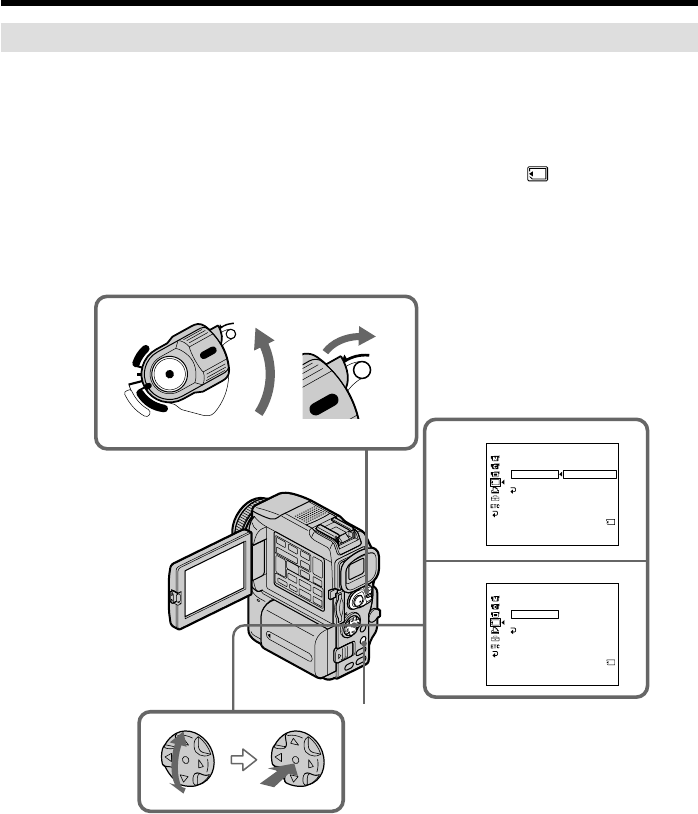
106
Selecting still image quality mode
You can select image quality mode in still image recording. The default setting is
SUPER FINE.
(1)Set the POWER switch to MEMORY or VCR. Make sure that the LOCK switch
is set to the right (unlock) position.
(2)Press MENU, then select and decide upon STILL SET in with the control
button (p. xx).
(3)Select and decide upon QUALITY with the control button.
(4)Select and decide upon the desired image quality with the control button.
Using a “Memory Stick” – introduction
1
3
4
LOCK
LOCK
POWER
V
C
R
M
E
M
O
R
Y
C
A
M
E
R
A
OFF
(CHG)
PIC MODE
MEMORY SET SFN
12
ST I LL SET
RETURN STANDARD
[
MENU
] :
END
QUAL I TY SUPER F I NE
REMA I N
IMAGESIZE FINE
MEMORY SET
STANDARD
[
MENU
] :
END
PIC MODE
36
ST I LL SET
RETURN
QUA L I TY
REMA I N
IMAGESIZE
MENU

107
“Memory Stick” Operations
Image quality settings
Setting Meaning
SUPER FINE (SFN) This is the highest image quality in your camcorder.
The number of still images you can record is less than
in FINE mode. The image is compressed to about 1/3.
FINE (FINE) Use this mode when you want to record high quality
images. The image is compressed to about 1/6.
STANDARD (STD) This is the standard image quality. The image is
compressed to about 1/10.
Note
In some cases, changing the image quality mode may not affect the image quality,
depending on the types of images you are shooting.
Differences in image quality mode
Recorded images are compressed in JPEG format before being stored in memory. The
memory capacity allotted to each image varies depending on the selected image quality
mode and image size. Details are shown in the table below. (You can select 1360 × 1020
or 640 × 480 image size in the menu settings.)
1360 × 1020 image size
Image quality mode Memory capacity
SUPER FINE About 900 KB
FINE About 450 KB
STANDARD About 300 KB
640 × 480 image size
Image quality mode Memory capacity
SUPER FINE About 190 KB
FINE About 100 KB
STANDARD About 60 KB
Image quality mode indicator
The image quality mode indicator is not displayed during playback.
When you select image quality
The number of images you can shoot in the currently selected image quality appears on
the screen.
Using a “Memory Stick” – introduction
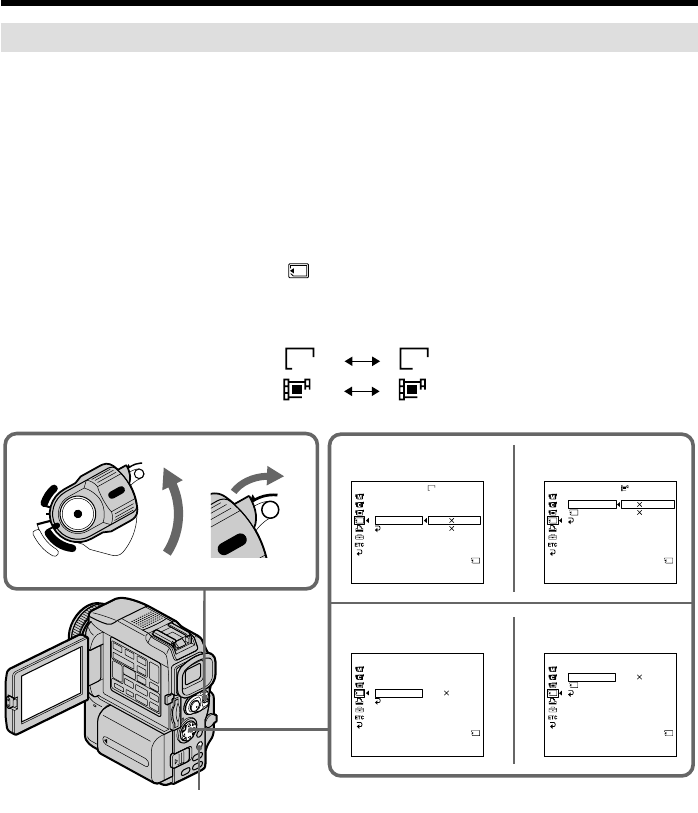
108
Selecting the image size
You can select either of two image sizes
Still images: 1360 × 1020 or 640 × 480. (When the POWER switch is set to VCR, the
image size is automatically set to 640 × 480.)
The default setting is 1360 × 1020.
Moving pictures: 320 × 240 or 160 × 112
The default setting is 320 × 240.
(1)Set the POWER switch to MEMORY. Make sure that the LOCK switch is set to
the right (unlock) position.
(2)Press MENU, then select and decide upon STILL SET (still image) or MOVIE
SET (moving picture) in with the control button (p. xx).
(3)Select and decide upon IMAGESIZE with the control button.
(4)Select and decide upon the desired image size with the control button.
The indicator changes as follows:
Still images:
1360 640
Moving pictures:
320 160
Using a “Memory Stick” – introduction
3
4
1
LOCK
LOCK
POWER
V
C
R
M
E
M
O
R
Y
C
A
M
E
R
A
OFF
(CHG)
MEMORY SET
MOVIE SET
RETURN
REMA I N
[
MENU
] :
END
IMAGESIZE
320 240
160 112
REMA I N
320
160 112
MEMORY SET
MOVIE SET
RETURN
REMA I N
[
MENU
] :
END
IMAGESIZE
REMA I N
2min
PIC MODE
MEMORY SET
ST I LL SET
RETURN
[
MENU
] :
END
QUA L I TY
IMAGESIZE
1360 1020
640 480
1360
2
REMA I N
PIC MODE
MEMORY SET
ST I LL SET
RETURN
[
MENU
] :
END
QUA L I TY
IMAGESIZE
640 480
60
REMA I N
40sec
1
STILL SET MOVIE SET
STILL SET MOVIE SET
MENU
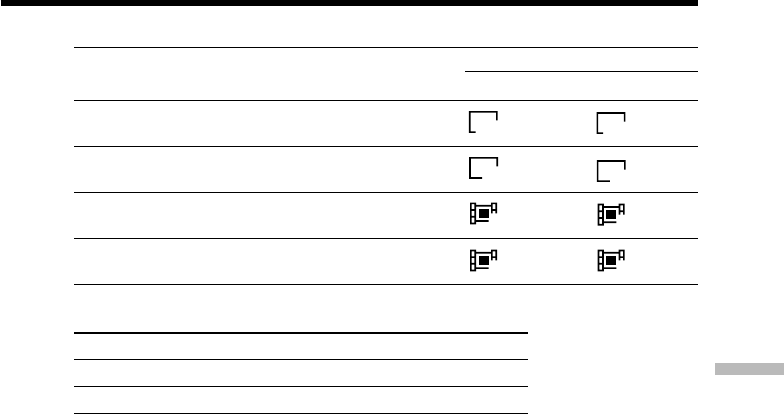
109
“Memory Stick” Operations
Using a “Memory Stick” – introduction
Image size settings
Setting Meaning Indicator
Recording Playback
1360 × 1020 Records 1360 × 1020 still images.
1360
SFN
1360
640 × 480 Records 640 × 480 still images.
640
SFN
640
320 × 240 Records 320 × 240 moving pictures.
320 320
160 × 112 Records 160 × 112 moving pictures.
160 160
Maximum recording time of moving pictures
Image size Maximum recording time
320 × 240 15 seconds
160 × 112 60 seconds

110
Using a “Memory Stick” – introduction
Approximate number of still images you can record on a
“Memory Stick”
The number of images you can record varies depending on which image quality and
image size you select and the complexity of the subject.
Type Image quality 640 × 480 1360 × 1020
4MB SUPER FINE (SFN) 19 images 4 images
(optional) FINE (FINE) 39 images 8 images
STANDARD (STD) 58 images 12 images
8MB SUPER FINE (SFN) 40 images 8 images
(supplied) FINE (FINE) 80 images 17 images
STANDARD (STD) 120 images 25 images
16MB SUPER FINE (SFN) 80 images 17 images
(optional) FINE (FINE) 160 images 34 images
STANDARD (STD) 240 images 50 images
32MB SUPER FINE (SFN) 160 images 35 images
(optional) FINE (FINE) 325 images 69 images
STANDARD (STD) 485 images 100 images
64MB SUPER FINE (SFN) 325 images 71 images
(optional) FINE (FINE) 650 images 140 images
STANDARD (STD) 980 images 205 images
128MB SUPER FINE (SFN) 650 images 140 images
(optional) FINE (FINE) 1310 images 280 images
STANDARD (STD) 1970 images 415 images
Approximate time of moving pictures you can record on a
“Memory Stick”
The time of moving pictures you can record varies depending on which image size you
select and the complexity of the subject.
Type 160 × 112 320 × 240
4MB (optional) 2 min. 40 sec. 40 sec.
8MB (supplied) 5 min. 20 sec. 1 min. 20 sec.
16MB (optional) 10 min. 40 sec. 2 min. 40 sec.
32MB (optional) 21 min. 20 sec. 5 min. 20 sec.
64MB (optional) 42 min. 40 sec. 10 min. 40 sec.
128MB (optional) 85 min. 20 sec. 21 min. 20 sec.
The table above shows approximate number and times of still images and moving
pictures you can record on a “Memory Stick” formatted by your camcorder.
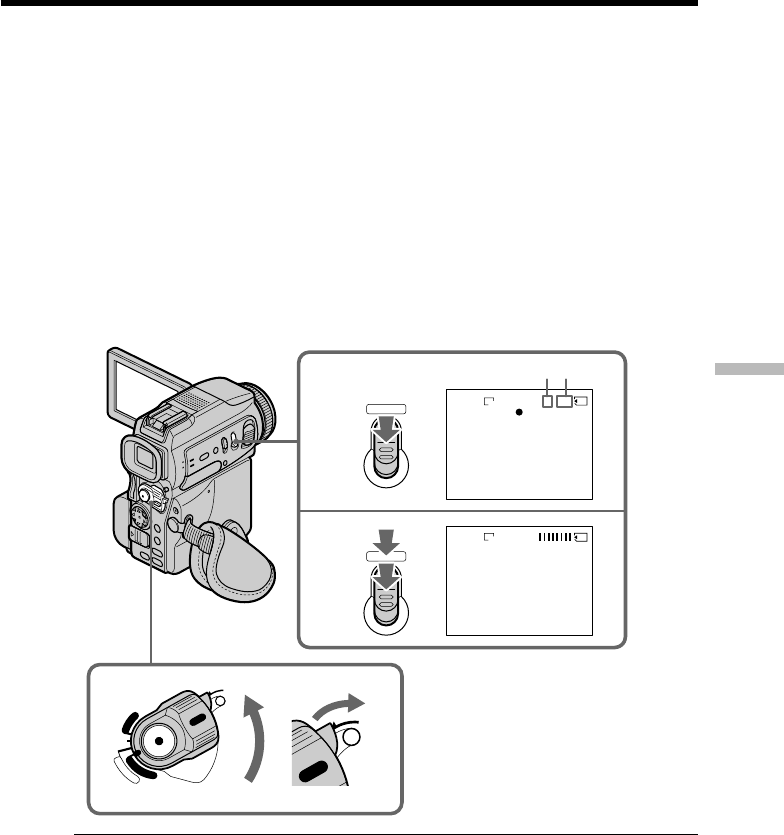
111
“Memory Stick” Operations
You can record still images on “Memory Stick”s.
Before operation
Insert a “Memory Stick” into your camcorder.
(1)Set the POWER switch to MEMORY. Make sure that the LOCK switch is set to
the right (unlock) position.
(2)Keep pressing PHOTO lightly until the desired still image appears. The green
z mark stops flashing, then lights up. The brightness of the image and focus
are adjusted, being targeted for the middle of the image and are fixed.
Recording does not start yet.
(3)Press PHOTO deeper.
The still image will be displayed after the shutter sounds.
Recording is complete when the bar scroll indicator disappears.
The image when you pressed PHOTO deeper will be recorded on the
“Memory Stick.”
When the POWER switch is set to MEMORY
The following functions do not work:
–Wide mode
–Digital zoom
–SteadyShot function
–SUPER NIGHTSHOT
–Fader
–Picture effect
–Digital effect
–Title
–Low lux of PROGRAM AE (The indicator flashes.)
–Sports lesson of PROGRAM AE (The indicator flashes.)
Recording still images on “Memory
Stick”s – Memory Photo recording
3
21 / 12
SFN
1360
SFN
1360
PHOTO
PHOTO
1
LOCK
LOCK
POWER
V
C
R
M
E
M
O
R
Y
C
A
M
E
R
A
OFF
(CHG)
[a][b]
[a]: Number of recorded images
[b]: Approximate number of
images can be recorded on
the “Memory Stick”
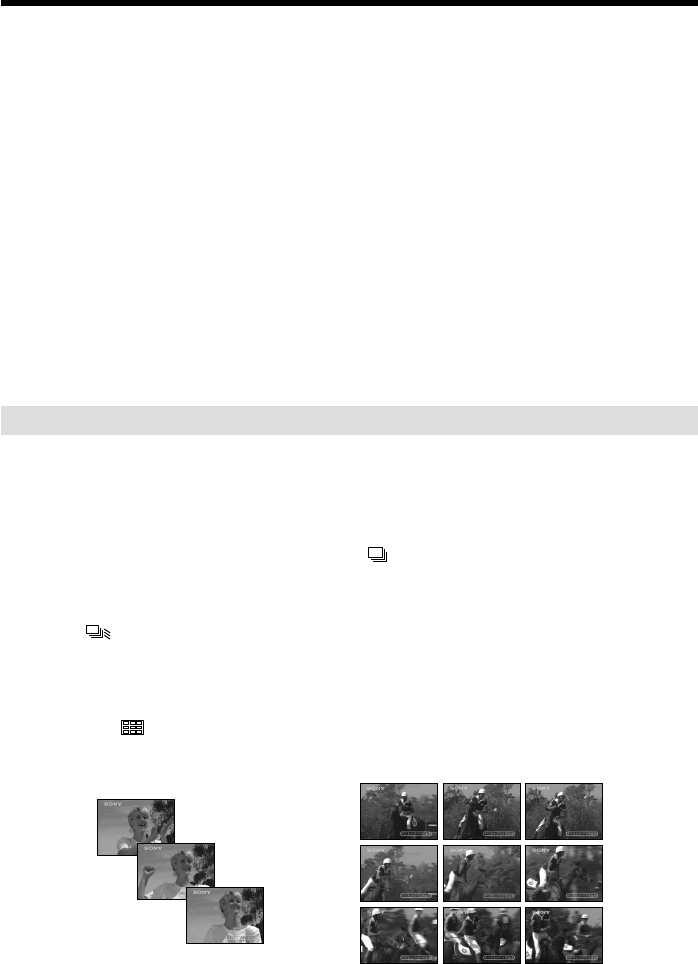
112
Recording still images on “Memory Stick”s
– Memory Photo recording
While you are recording a still image
You can neither turn off the power nor press PHOTO.
When you press PHOTO on the Remote Commander
Your camcorder immediately records the image that is on the screen when you press
the button.
When you press PHOTO lightly in step 2
The image momentarily flickers. This is not a malfunction.
Recording data
The recording data (date/time or various settings when recorded) are not displayed
while recording. However, they are recorded automatically onto the “Memory Stick.”
To display the recording data, press DATA CODE on the Remote Commander during
playback.
When POWER switch is set to MEMORY
The angle of view is slightly larger compared with the angle of view in CAMERA
mode.
Recording images continuously
You can record still images continuously. Select one of the three modes described below
before recording.
NORMAL [a]
Your camcorder shoots up to three still images in 1360 × 1020 size or nine still images in
640 × 480 size at about 0.5 sec intervals. ( )
HIGH SPEED (Recording image size is 640 × 480) [a]
Your camcorder shoots up to 16 still images in 640 × 480 size at about 0.07 sec intervals.
( )
MULTI SCRN (Recording image size is 640 × 480) [b]
Your camcorder shoots nine still images at about 0.4 sec intervals and displays the
images on a single page divided into nine boxes. Still images are recorded in 640 × 480
size. ( )
[a] [b]
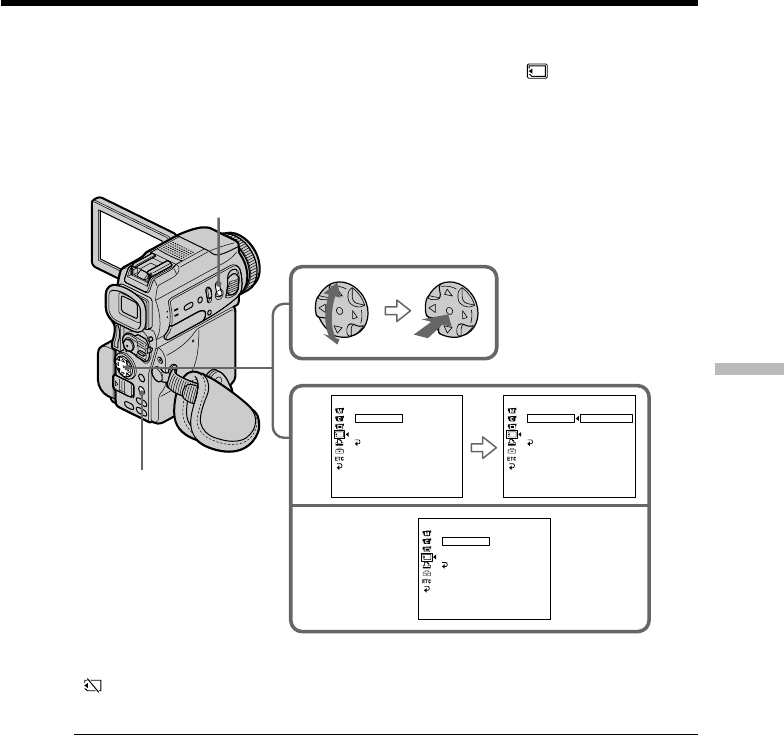
113
“Memory Stick” Operations
(1)Set the POWER switch to MEMORY. Make sure that the LOCK switch is set to
the right (unlock) position.
(2)Press MENU, then select and decide upon STILL SET in with the control
button (p. xx).
(3)Select and decide upon PIC MODE with the control button.
(4)Select and decide upon the desired setting with the control button.
(5)Press MENU to make the menu setting disappear.
(6)Press PHOTO deeper.
If the capacity of the “Memory Stick” becomes full
” FULL” appears on the screen, and you cannot record a still image on this “Memory
Stick.”
The number of images in continuous shooting
The number of images you can shoot continuously varies depending on the image size
and the capacity of the “Memory Stick.”
During recording images continuously
The flash does not work.
When shooting with the self-timer function or the Remote Commander
Your camcorder automatically records up to the maximum recordable number of still
images.
When selecting HIGH SPEED
Flickering or changes in color may occur. Also, your camcorder prevents focusing on
near objects.
When selecting NORMAL or HIGH SPEED
Recording continues up to the maximum number of still images during pressing
PHOTO deeper. Release PHOTO to stop recording.
Recording still images on “Memory Stick”s
– Memory Photo recording
PIC MODE
MEMORY SET
ST I LL SET
RETURN
[
MENU
] :
END
QUA L I TY H I GH SPEED
IMAGESIZE
PIC MODE
MEMORY SET
ST I LL SET
RETURN
[
MENU
] :
END
SINGLE
QUA L I TY
IMAGESIZE
PIC MODE
MEMORY SET
MUL T I SCRN
NORMAL
ST I LL SET
RETURN
[
MENU
] :
END
QUA L I TY SINGLE
IMAGESIZE H I GH SPEED
3
4
PHOTO
MENU
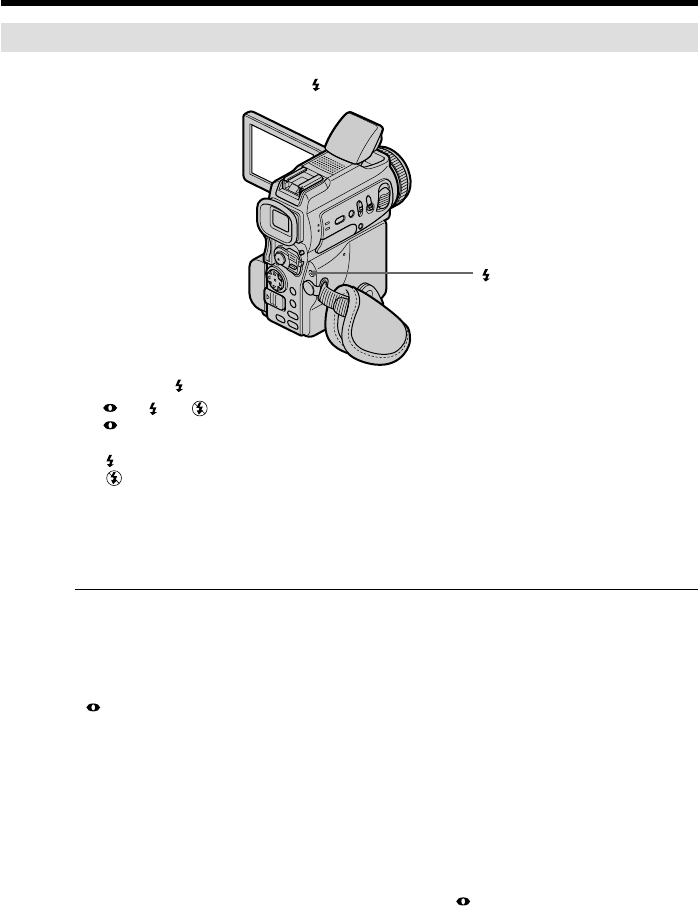
114
Recording images with the flash
The flash automatically pops up to strobe. The default setting is auto (no indicator). To
change the flash mode, press the (flash) repeatedly until the flash mode indicator
appears on the screen.
Each press of (flash) changes the indicator as follows:
t t t No indicator
Auto red-eye reduction: The flash fires before recording to reduce the red-eye
phenomenon.
Forced flash: The flash fires regardless of the surrounding brightness.
No flash: The flash does not fire.
The flash is adjusted to the appropriate brightness through the photocell window for
the flash. You can also change FLASH LVL to the desired brightness in the menu
settings (p. xx). Try recording various images to find the most appropriate setting for
FLASH LVL.
Notes
•The recommended shooting distance using the built-in flash is 0.3 m to 2.5 m (31/32
feet to 8 1/3 feet).
•Attaching the lens hood (supplied) or a conversion lens (optional) may block the light
from the flash or cause lens shadow to appear.
•You cannot use an external flash (optional) and the built-in flash at the same time.
• (auto red-eye reduction) may not produce the desired effect depending on
individual differences, the distance to the subject, the subject not looking at the pre-
recording flash or other conditions.
•The flash effect cannot be obtained easily when you use forced flash in a bright
location.
•If it is not easy to focus on a subject automatically, for example, when recording in the
dark, use the focal distance information (p. xx) for focusing manually.
If you leave your camcorder for five or more minutes after disconnecting the
power source
Your camcorder returns to the default setting (auto).
The flash does not fire even if you select auto and (auto red-eye reduction)
during the following operations:
–NightShot
–Exposure
–Spotlight of PROGRAM AE
–Sunset & moon of PROGRAM AE
–Landscape of PROGRAM AE
When you use an external flash (optional) which does not have the auto red-eye
reduction function
You cannot select the auto red-eye reduction.
Recording still images on “Memory Stick”s
– Memory Photo recording
(flash)
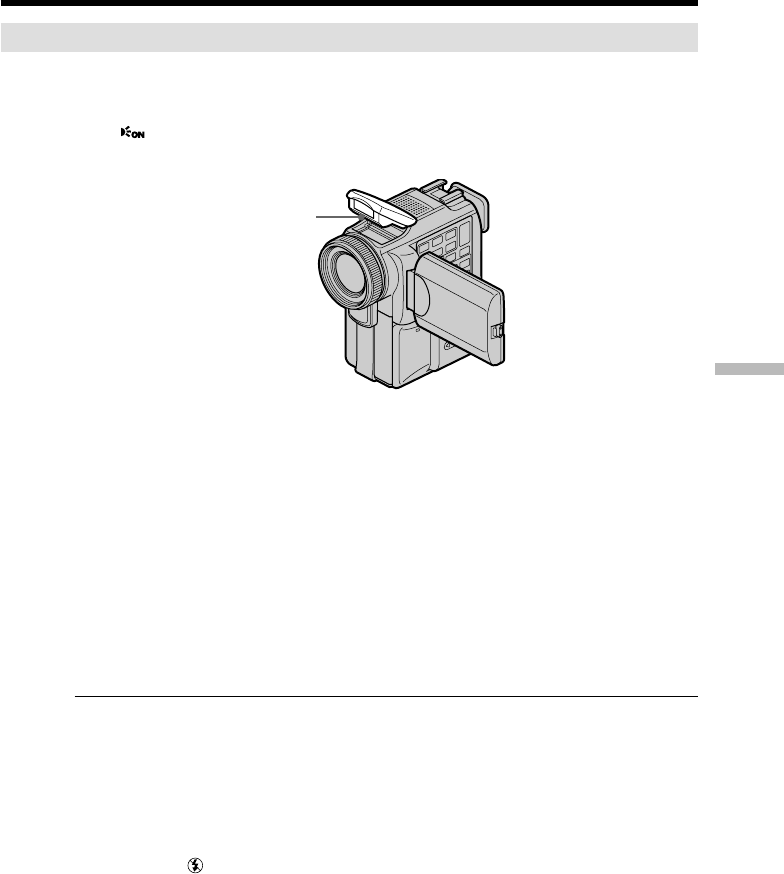
115
“Memory Stick” Operations
Shooting using the HOLOGRAM AF
The HOLOGRAM AF is an auxiliary light source used for focusing on subjects in dark
places.
Set HOLOGR F to AUTO in the menu settings. (The default setting is AUTO.)
When appears on the screen in a dark place, press PHOTO lightly. Then the flash
will pop up and the auxiliary light will automatically emit until the subject is focused.
About HOLOGRAM AF
“HOLOGRAM AF” is a new AF auxiliary optical system that uses laser holograms to
enable photography of still pictures in dark places. This system satisfies Laser Class 1
(*). A feature of this system is that it is gentler on the eyes than conventional high-
brightness LEDs or high-brightness lamps while it maintains high safety.
Directly looking into the HOLOGRAM AF emitter at close range presents no safety
problems. However, this is not recommended as you will see a residual image for
several images and your eyes will be dazzled just like when you look into a flashlight.
* HOLOGRAM AF satisfies time criteria 30,000 seconds Class 1 of all JIS (Japan), IEC
(EU), and FDA (US) standards. Compliance with these standards means that this is a
safe laser product even if a person looks directly into the laser light or into the light
condensed by a lens for 30,000 seconds.
Note
•If enough light does not reach the subject even if the HOLOGRAM AF emitter is
emitted (recommended shooting distance is 2.5 m (8 1/3 feet)), the subject will not be
focused.
•Light emitted by HOLOGRAM AF sometimes deviates from the center of the image.
However, the image is in focus when the light reaches the subject.
The HOLOGRAM AF does not emit when:
•Flash is set to No flash
•NightShot is set to ON
•focusing manually
•Sunset & moon of PROGRAM AE
•Landscape of PROGRAM AE
When you use the external flash (optional)
The built-in flash pops up and HOLOGRAM AF emit.
Recording still images on “Memory Stick”s
– Memory Photo recording
HOLOGRAM AF
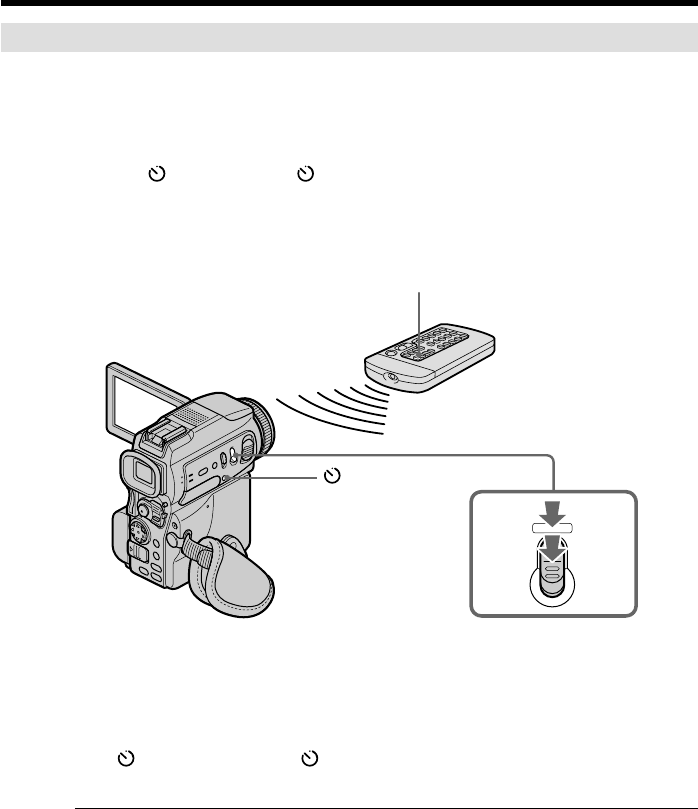
116
Self-timer memory photo recording
You can record images on “Memory Stick”s with the self-timer. You can also use the
Remote Commander for this operation.
(1)Set the POWER switch to MEMORY. Make sure that the LOCK switch is set to
the right (unlock) position.
(2)Press (self-timer). The (self-timer) indicator appears on the screen.
(3)Press PHOTO deeper.
Self-timer starts counting down from 10 with a beep sound. In the last
two seconds of the countdown, the beep sound gets faster, then recording
starts automatically.
To record moving pictures on “Memory Stick”s with the self-
timer
Press START/STOP in step 3. To cancel recording, press START/STOP again.
To cancel self-timer recording
Press (self-timer) so that the (self-timer) indicator disappears on the screen. You
cannot cancel the self-timer recording using the Remote Commander.
Note
The self-timer recording mode is automatically canceled when:
–Self-timer recording is finished.
–The POWER switch is set to OFF (CHG) or VCR.
To check the image to be recorded
You can check the image with pressing the PHOTO button lightly, then press it deeper
to start the self-timer recording.
Recording still images on “Memory Stick”s
– Memory Photo recording
PHOTO
2
PHOTO
(self-time)
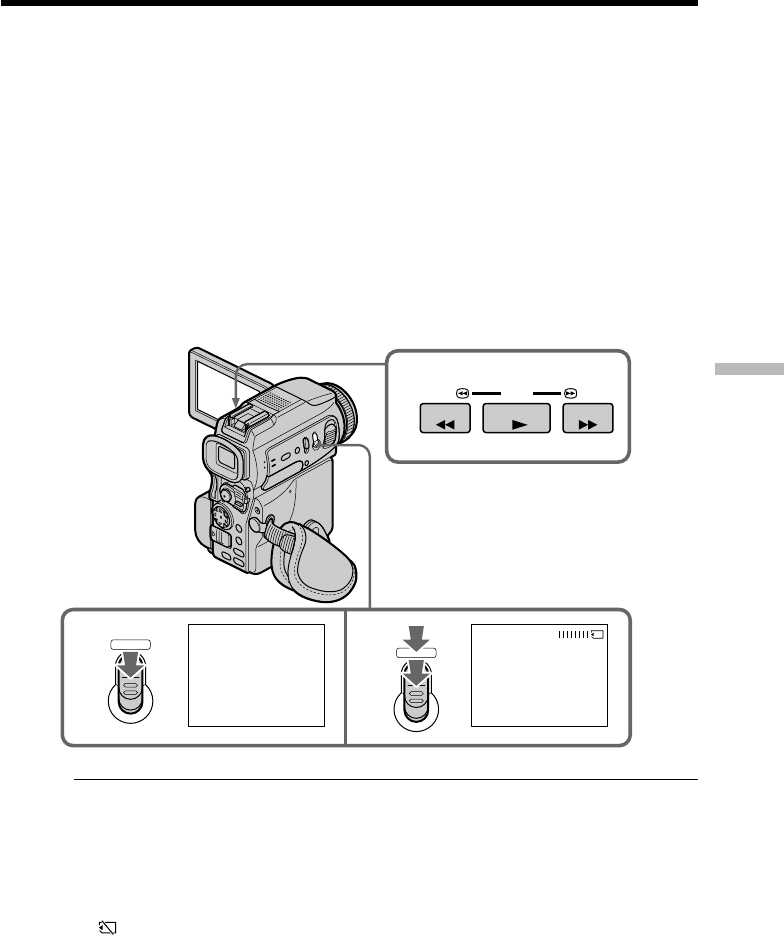
117
“Memory Stick” Operations
Your camcorder can read moving picture data recorded on a tape and record it as a still
image on a “Memory Stick.” Your camcorder can also take in moving picture data
through the input connector and record it as a still image on a “Memory Stick.”
Before operation
•Insert a recorded tape into your camcorder.
•Insert a “Memory Stick” into your camcorder.
(1)Set the POWER switch to VCR.
(2)Press N. The picture recorded on the tape is played back.
(3)Keep pressing PHOTO lightly until the picture from the tape freezes.
CAPTURE appears on the screen. Recording does not start yet.
(4)Press PHOTO deeper. The image displayed on the screen will be recorded on a
“Memory Stick.” Recording is complete when the bar scroll indicator
disappears.
Image size of still images
Image size is automatically set to 640 × 480.
When the access lamp is lit or flashing
Do not shake or strike the unit. As well do not turn the power off , eject a “Memory
Stick.” Otherwise, the image data breakdown may occur.
If “ ” appears on the screen
The inserted “Memory Stick” is incompatible with your camcorder because its format
does not conform with your camcorder. Check the format of the “Memory Stick.”
If you press PHOTO lightly in the playback mode
Your camcorder stops momentarily.
2
34
CAPTURE
FFPLAYREW
PHOTO
PHOTO
Recording an image from a tape as a still
image
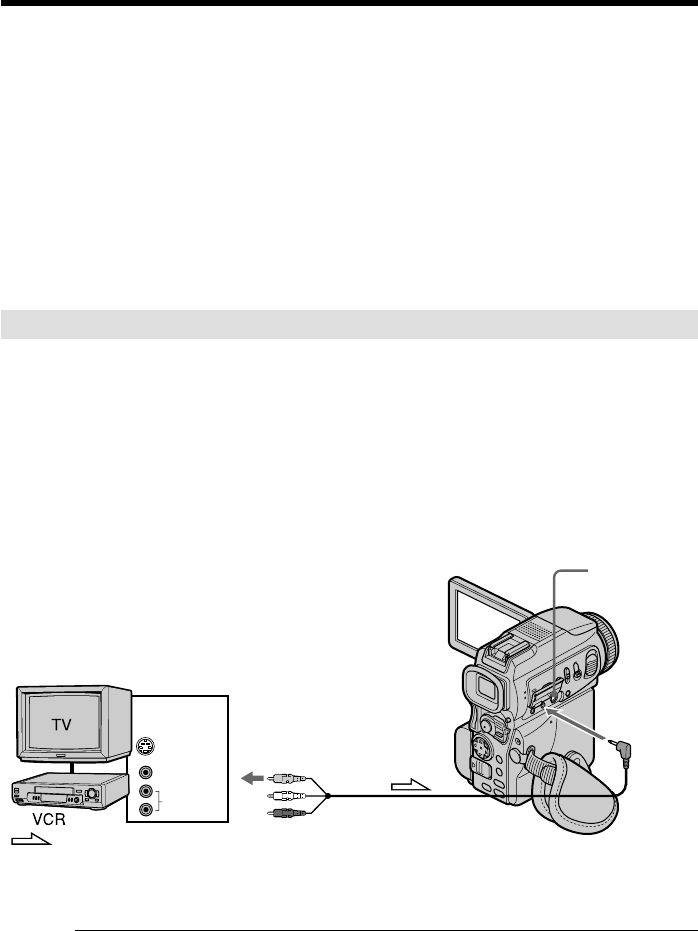
118
Sound recorded on a tape
You cannot record the audio from a tape.
Titles have already recorded on tapes
You cannot record the titles on “Memory Stick”s. The title does not appear while you
are recording a still image with PHOTO.
Recording date/time
The recording data (date/time) when it is recorded on “Memory Stick” is recorded.
Various settings are not recorded.
When you press PHOTO on the Remote Commander
Your camcorder immediately records the image that is on the screen when you press
the button.
Recording a still image from other equipment
Before operation
Set DISPLAY to LCD in the menu settings. (The default setting is LCD.)
(1)Set the POWER switch to VCR.
(2)Play back the recorded tape, or turn the TV on to see the desired program.
The image of the other equipment is displayed on the LCD screen or
viewfinder.
(3)Follow steps 3 and 4 on page xx.
Using the A/V connecting cable
Connect the yellow plug of the A/V connecting cable to the video jack on the VCR or
the TV.
If your TV or VCR has an S video jack
Pictures can be reprodeced more faithfully by using an S video cable (optional).
With this connection, you do not need to connect the yellow (video) plug of the A/V
connecting cable.
Connect an S video cable (optional) to the S video jacks of both your camcorder and the
TV or VCR.
This connection produces higher quality DV format pictures.
AUDIO
AUDIO/
VIDEO
S VIDEO
VIDEO
OUT
S VIDEO
: Signal flow
Recording an image from a tape as a still image
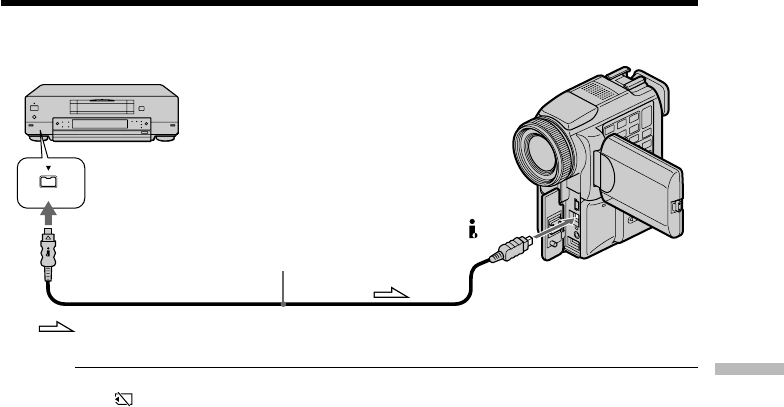
119
“Memory Stick” Operations
Using the i.LINK cable (DV connecting cable)
Note
The “ ” may flash in the following instances. If this happens, eject and insert
“Memory Stick“ again, and record distortion-free images.
–When recording on a tape in a poor recording state, for example, on a tape that has
been repeatedly used for dubbing
–When attempting to input images that are distorted due to poor radio wave reception
when a TV tuner unit is in use
Recording an image from a tape as a still image
DV
DV OUT DV
: Signal flow
(optional)
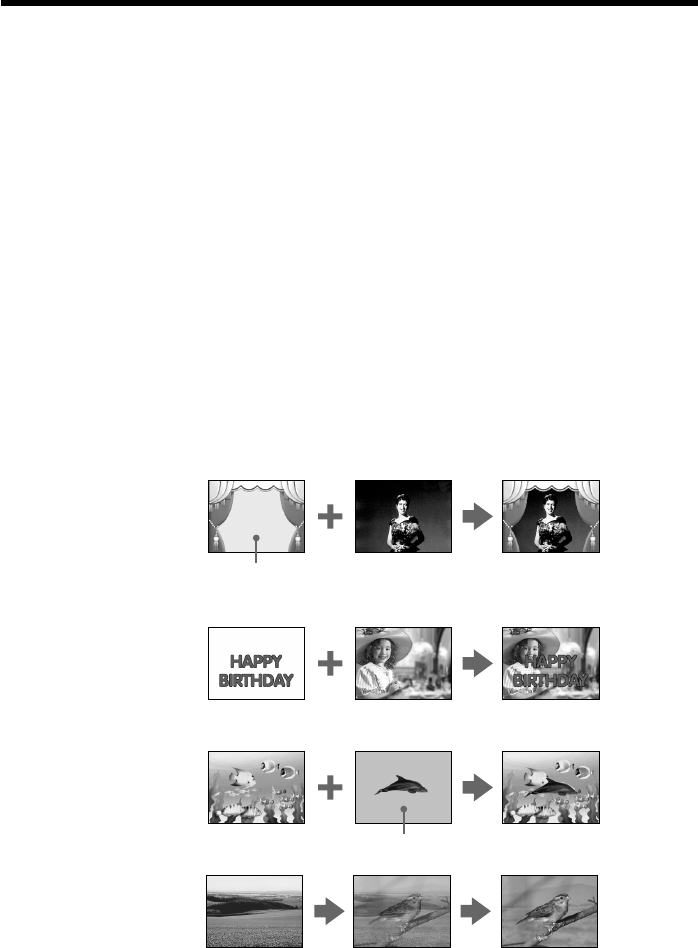
120
You can superimpose a still image you have recorded on the “Memory Stick” on top of
the moving image you are recording. You can record the superimposed images on a
tape or a “Memory Stick.” (However, you can record only superimposed still images on
the “Memory Stick.”)
M. CHROM (Memory chromakey)
You can swap a blue area of a still image such as an illustration or a frame with a
moving image.
M. LUMI (Memory luminancekey)
You can swap a brighter area of a still image such as a handwritten illustlation or title
with a moving image. Record a title on the “Memory Stick” before a trip or event for
convenience.
C. CHROM (Camera chromakey)
You can superimpose a moving image on top of a still image such as an image can be
used as background. Shoot the subject against a blue background. The blue area of the
moving image will be swapped with a still image.
M. OVERLAP* (Memory overlap)
You can make a moving image fade in on top of a still image recorded on the “Memory
Stick” as the overlap function.
*The superimposed image using Memory overlap function can be recorded on tapes
only.
Superimposing a still image in the
“Memory Stick” on an image
– MEMORY MIX
M. OVERLAP
Still image Moving image
C. CHROM
Still image Moving image
Blue
M. LUMI
Still image Moving image
M. CHROM
Still image Moving image
Blue

121
“Memory Stick” Operations
Superimposing a still image in the “Memory Stick” on an image
– MEMORY MIX
Recording superimposed images on a tape
Before operation
•Insert a tape for recording into your camcorder.
•Insert a “Memory Stick” recorded still images into your camcorder.
(1)Set the POWER switch to CAMERA.
(2)Press MEMORY MIX in the standby mode.
The last recorded or last composed image appears on the lower part of the
screen as a thumbnail image.
(3)Press MEMORY+/– to select the still image you want to superimpose.
To see the previous image, press MEMORY –. To see the next image, press
MEMORY+.
(4)Select the desired mode with the control button.
The mode changes as follows:
M. CHROM y M. LUMI y C. CHROM y M. OVERLAP
(5)Press z on the control button.
The still image is superimposed on the moving image.
(6)Press b/B on the control button to adjust the effect.
M. CHROM –The color (blue) scheme of the area in the still image which is
to be swapped with a moving image
M. LUMI –The color (bright) scheme of the area in the still image which
is to be swapped with a moving image
C. CHROM –The color (blue) scheme of the area in the moving image
which is to be swapped with a still image
M. OVERLAP –No adjustment necessary
The fewer bars there are on the screen, the stronger the effect.
(7)Press START/STOP to start recording.
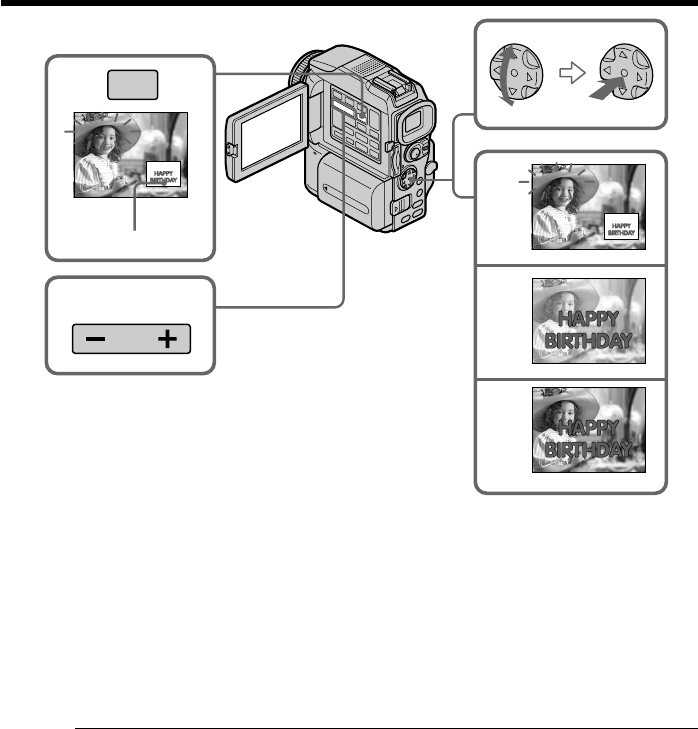
122
Superimposing a still image in the “Memory Stick” on an image
– MEMORY MIX
To change the still image to superimpose
Do either of the following:
–Press MEMORY+/– before step 7.
–Press z on the control button before step 7, and repeat the procedure from step 4.
To change the mode setting
Press z on the control button before step 7, and repeat the procedure from step 4.
To cancel MEMORY MIX
Press MEMORY MIX.
Notes
•You cannot use MEMORY MIX function for moving pictures recorded on “Memory
Stick”s.
•When the overlapping still image has a large amount of white, the thumbnail image of
the picture may not be clear.
Image data modified with your computers or shot with other equipment
You may not be able to play them back with your camcorder.
When you select M. OVERLAP
You cannot change the still image or the mode setting.
During recording
You cannot change the mode setting.
To record the superimposed image as a still image
Press PHOTO deeper in step 7.
4
5
6
M. LUMI
M. LUMI
M. LUMI
III••••
I••••••
100–0021
100–0021
100–0021
2
M. CHROM
100–0021
MEMORY
MIX
3
Still image

123
“Memory Stick” Operations
Recording superimposed images on a “Memory Stick” as a still
image
Before operation
Insert a “Memory Stick” recorded still images into your camcorder.
(1)Set the POWER switch to MEMORY. Make sure that the LOCK switch is set to
the right (unlock) position.
(2)Press MEMORY MIX.
The last recorded or last composed image appears on the lower part of the
screen as a thumbnail image.
(3)Press MEMORY+/– to select the image you want to superimpose.
To see the previous image, press MEMORY –. To see the next image, press
MEMORY+.
(4)Select the desired mode with the control button.
The mode changes as follows:
M. CHROM y M. LUMI y C. CHROM
(5)Press z on the control button.
The still image is superimposed on the moving image.
(6)Press b/B on the control button to adjust the effect.
M. CHROM –The color (blue) scheme of the area in the still image which is
to be swapped with a moving image
M. LUMI –The color (bright) scheme of the area in the still image which
is to be swapped with a moving image
C. CHROM –The color (blue) scheme of the area in the moving image
which is to be swapped with a still image
The fewer bars there are on the screen, the stronger the effect.
(7)Press PHOTO deeper to start recording.
The image displayed on the screen will be recorded on a “Memory Stick.”
Recording is complete when the bar scroll indicator disappears.
Superimposing a still image in the “Memory Stick” on an image
– MEMORY MIX
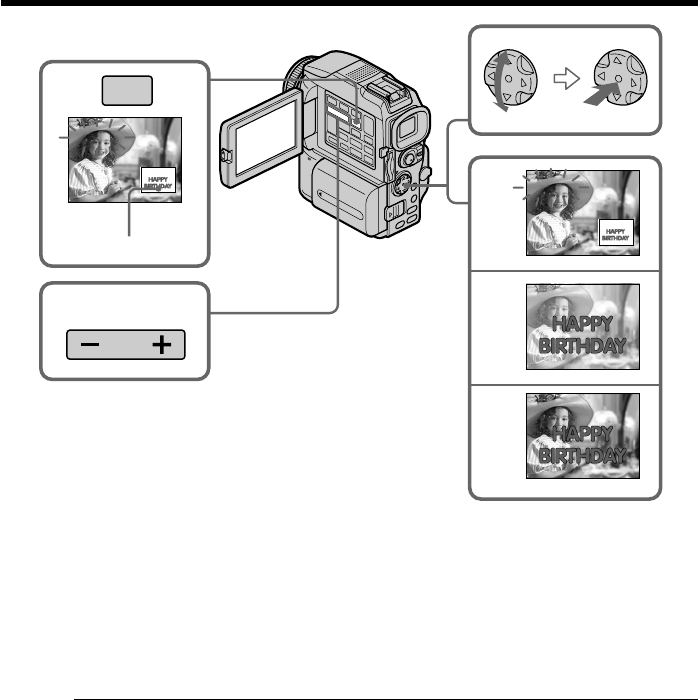
124
Superimposing a still image in the “Memory Stick” on an image
– MEMORY MIX
To change the still image to superimpose
Do either of the following:
–Press MEMORY+/– before step 7.
–Press z on the control button before step 7, and repeat the procedure from step 4.
To change the mode setting
Press z on the control button before step 7, and repeat the procedure from step 4.
To cancel MEMORY MIX
Press MEMORY MIX.
Notes
•You cannot use MEMORY MIX function for moving pictures recorded on “Memory
Stick”s.
•When the overlapping still image has a large amount of white, the thumbnail image of
the picture may not be clear.
Image data modified with your computers or shot with other equipment
You may not be able to play them back with your camcorder.
During recording
You cannot change the mode setting.
When recording images on a “Memory Stick” using the MEMORY MIX function
The PROGRAM AE function does not work. (The indicator flashes.)
The “Memory Stick” supplied with your camcorder stores 20 images
–For M. CHROM: 18 images (such as a frame) 100-0001~100-0018
–For C. CHROM: two images (such as a background) 100-0019~100-0020
Sample images
Sample images stored in the “Memory Stick” supplied with your camcorder are
protected (p. xx).
4
5
6
M. LUMI
M. LUMI
M. LUMI
III••••
I••••••
100–0021
100–0021
100–0021
2
M. CHROM
100–0021
MEMORY
MIX
3
Still image
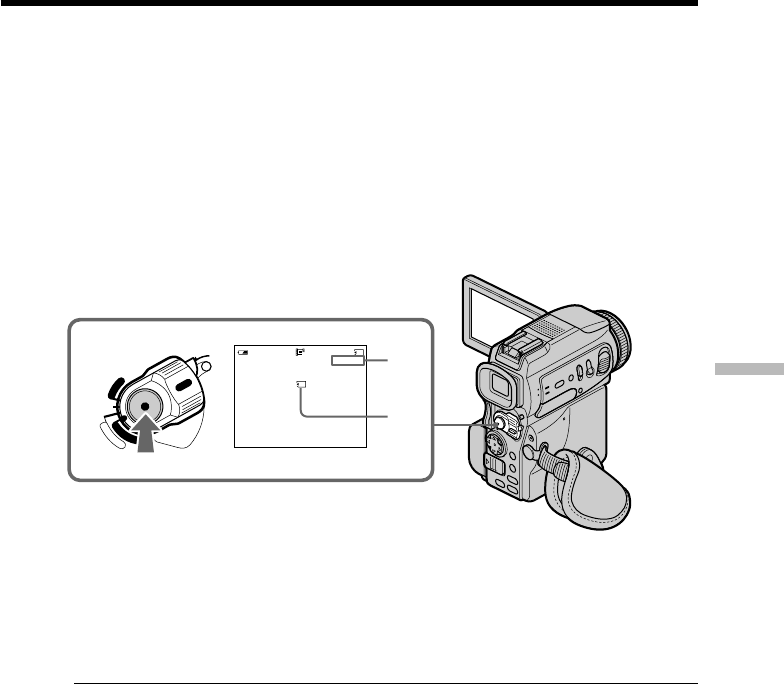
125
“Memory Stick” Operations
You can record moving pictures with sound on “Memory Stick”s.
Before operation
Insert a “Memory Stick” into your camcorder.
(1)Set the POWER switch to MEMORY. Make sure that the LOCK switch is set to
the right (unlock) position.
(2)Press START/STOP. Your camcorder starts recording. The camera recording
lamp located on the front of your camcorder lights up. When IMAGESIZE in
the menu settings is set to 320 × 240, the maximum recording time is 15
seconds. However, when IMAGESIZE in the menu settings is set to 160 × 112,
the maximum recording time is 60 seconds.
To stop recording
Press START/STOP.
Note
Sound is recorded in monaural.
When the POWER switch is set to MEMORY
The following functions do not work:
– Wide mode
– Digital zoom
– SteadyShot function
– SUPER NIGHTSHOT
– Fader
– Picture effect
– Digital effect
– Title
– Low lux of PROGRAM AE (The indicator flashes.)
– Sports lesson of PROGRAM AE (The indicator flashes.)
Recording moving pictures on “Memory
Stick”s – MPEG movie recording
[a]: Recording time can be recorded on the
“Memory Stick”
[b]: This indicator is displayed for five seconds
after pressing START/STOP. This indicator
is not recorded.
2
320
40
REC
0:03
[15 ]
min
SEC
BBB
LOCK
POWER
V
C
R
M
E
M
O
R
Y
C
A
M
E
R
A
OFF
(CHG)
[a]
[b]

126
When using an external flash (optional)
Turn the power of the external flash off when recording moving pictures on “Memory
Stick”s.
Otherwise, the charging sound for the flash may be recorded.
Recording date/time
The date/time are not displayed while recording. However, they are automatically
recorded onto the “Memory Stick.”
To display the recording date/time, press DATA CODE on the Remote Commander
during playback. Various settings cannot be recorded.
During recording on “Memory Stick”
Do not eject the cassette tape from your camcorder. During ejecting the tape, sound is
not recorded on the “Memory Stick.”
When the POWER switch is set to MEMORY
The angle of view is slightly larger compared with the angle of view in CAMERA
mode.
Recording moving pictures on “Memory Stick”s
– MPEG movie recording
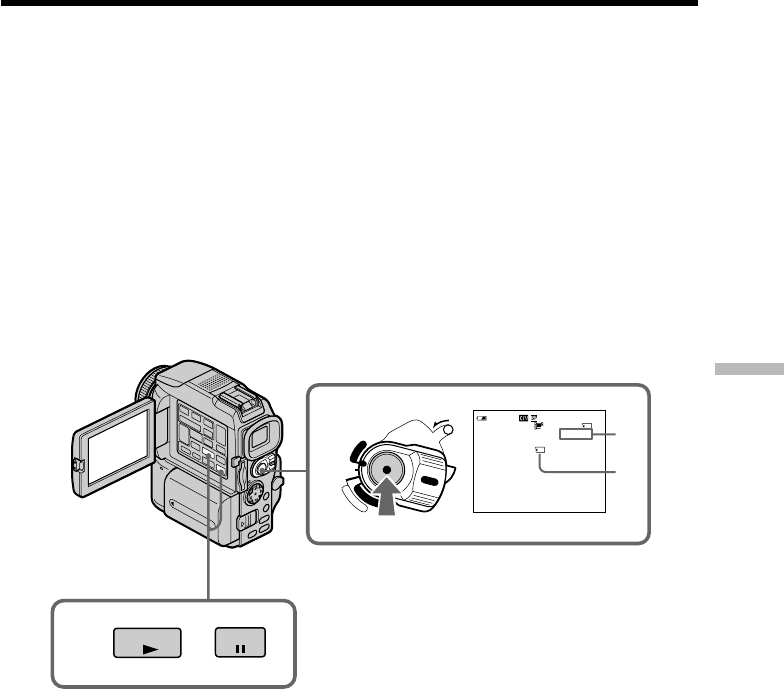
127
“Memory Stick” Operations
Your camcorder can read moving picture data recorded on a tape and record it as a
moving picture on a “Memory Stick.” Your camcorder can also take in moving picture
data through the input connector and record it as a moving picture on a “Memory
Stick.”
Before operation
•Insert a recorded tape into your camcorder.
•Insert a “Memory Stick” into your camcorder.
(1)Set the POWER switch to VCR.
(2)Press N. The picture recorded on the tape is played back.
And press X at the scene where you want to start recording from.
(3)Press START/STOP on your camcorder. When IMAGESIZE in the menu
settings is set to 320 × 240, the maximum recording time is 15 seconds.
However, when IMAGESIZE in the menu settings is set to 160 × 112, the
maximum recording time is 60 seconds.
To stop recording
Press START/STOP.
Recording a picture from a tape as a
moving picture
3
2
320
40
REC
[15 ]
0:03
0:15:42:43
min
SEC
BBB
N
PLAY
PAUSE
LOCK
POWER
V
C
R
M
E
M
O
R
Y
C
A
M
E
R
A
OFF
(CHG)
[a]: Recording time can be recorded on the
“Memory Stick.”
[b]: This indicator is displayed for
five seconds after pressing START/STOP.
This indicator is not recorded.
[a]
[b]

128
Notes
•Sound recorded in 48 kHz is converted to one in 32 kHz when recording images from
a tape to “Memory Stick”s.
•Sound recorded in stereo is converted to monaural sound when recording from tapes.
When the access lamp is lit or flashing
Do not shake or strike the unit. As well do not turn the power off , eject a “Memory
Stick” or remove the battery pack. Otherwise, the image data breakdown may occur.
Titles have already recorded on tapes
You cannot record the titles on “Memory Stick”s. The title does not appear while you
are recording a moving image with START/STOP.
If “ AUDIO ERROR” is displayed
Sound that cannot be recorded by your camcorder has been recorded. Connect the A/V
connecting cable to input images from an external unit used to play back the image
(p. xx).
Recording date/time
The recording data (date/time) when it is recorded on “Memory Stick” is recorded.
Various settings are not recorded.
Recording a picture from a tape as a moving picture
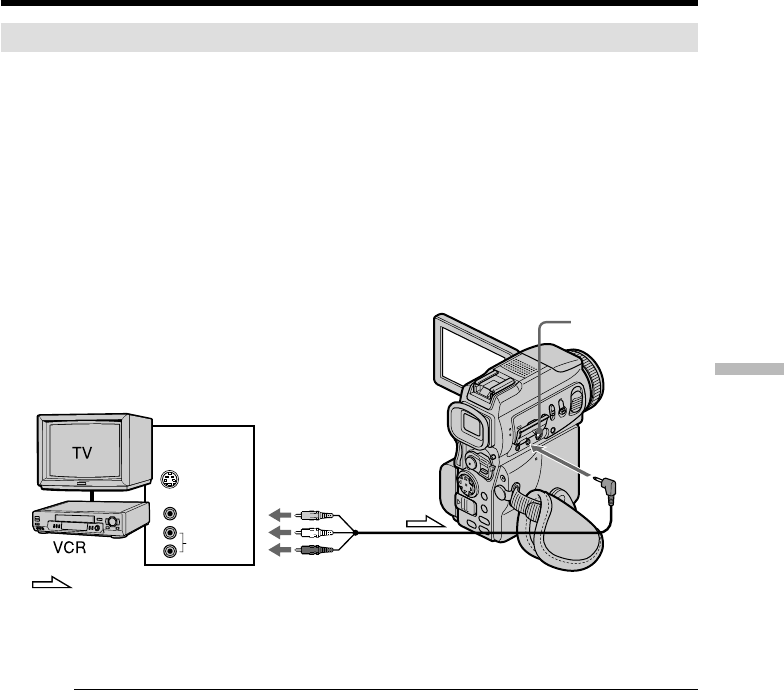
129
“Memory Stick” Operations
Recording a moving picture from other equipment
Before operation
Set DISPLAY to LCD in the menu settings. (The default setting is LCD.)
(1)Set the POWER switch to VCR.
(2)Play back the recorded tape, or turn the TV on to see the desired program.
The image of the other equipment is displayed on the LCD screen or
viewfinder.
(3)Follow the procedure on page xxx from the step 3 onwards at the point where
you want to start recording from.
Using the A/V connecting cable
Connect the yellow plug of the A/V connecting cable to the video jack on the VCR or
the TV.
If your TV or VCR has an S video jack
Pictures can be reprodeced more faithfully by using an S video cable (optional).
With this connection, you do not need to connect the yellow (video) plug of the A/V
connecting cable.
Connect an S video cable (optional) to the S video jacks of both your camcorder and the
TV or VCR.
This connection produces higher quality DV format pictures.
Recording a picture from a tape as a moving picture
S VIDEO
VIDEO
OUT
AUDIO/
VIDEO
S VIDEO
AUDIO
: Signal flow
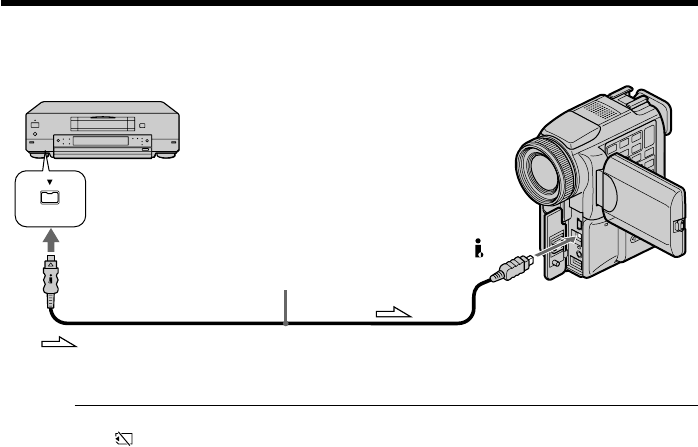
130
Using the i.LINK cable (DV connecting cable)
Note
The “ ” may flash in the following instances. If this happens, eject and insert
“Memory Stick” again, and record distortion-free images.
–When recording on a tape in a poor recording state, for example, on a tape that has
been repeatedly used for dubbing
–When attempting to input images that are distorted due to poor radio wave reception
when a TV tuner unit is in use
During recording on “Memory Stick”
Do not eject the cassette tape from your camcorder. During ejecting the tape, sound is
not recorded on the “Memory Stick.”
Recording a picture from a tape as a moving picture
DV OUT DV
DV
: Signal flow
(optional)
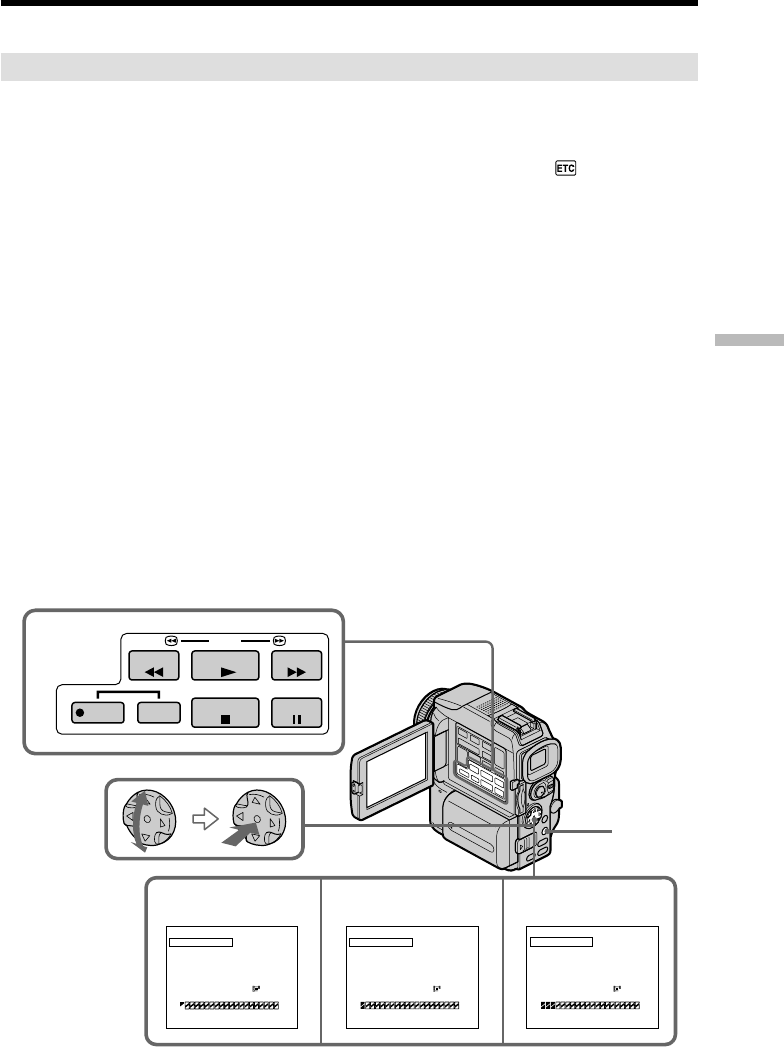
131
“Memory Stick” Operations
You can duplicate selected scenes (programs) for editing onto a “Memory Stick.”
Making the program
(1)Set the POWER switch to VCR on your camcorder.
(2)Insert the tape for playback, and a “Memory Stick” for recording into your
camcorder.
(3)Press MENU, then select and decide upon VIDEO EDIT in with the
control button (p. xx).
(4)Select and decide upon MEMORY with the control button.
(5)Select and decide upon IMAGESIZE with the control button.
When IMAGESIZE is set to 320 × 240, the maximum recording time is 15
seconds. However, when IMAGESIZE is set to 160 × 112, the maximum
recording time is 60 seconds.
(6)Search for the beginning of the first scene you want to insert using the video
operation buttons, then pause playback.
You can fine-adjust one frame at a time with EDITSEARCH.
(7)Press MARK on the Remote Commander, or z on the control button.
The IN point of the first program is set, and the top part of the program mark
changes to light blue.
(8)Search for the end of the first scene you want to insert using the video
operation buttons, then pause playback.
(9)Press MARK on the Remote Commander, or z on the control button.
The OUT point of the first program is set, then the bottom part of the program
mark changes to light blue.
(10) Repeat steps 6 to 9, then set the program.
When one program is set, the program mark changes to light blue.
You can set 20 programs in maximum.
Recording edited pictures as a moving
picture – Digital program editing (to a
“Memory Stick”)
6,8
7910
STOP
FF
PAUSE
PLAYREW
REC
MARK
UNDO
ERASE AL L
START
TOTAL
1
OUT
0:08:55:06
0
SEC
[15
SEC
]
MOV I E ED I T
[
MENU
] :
END
MARK
UNDO
ERASE ALL
START
TOTAL
2
IN
0:09:07:06
0
SEC
[15
SEC
]
MOV I E ED I T
[
MENU
] :
END
MARK
UNDO
ERASE ALL
START
TOTAL
4
IN
0:10:01:23
0
SEC
[15
SEC
]
MOV I E ED I T
[
MENU
] :
END
TESTIDE TESTIDE TESTIDE
320 320 320
MENU

132
Erasing the program you have set
Erase OUT first and then IN from of the last program.
(1)Select and decide upon UNDO with the control button.
(2)Select and decide upon EXECUTE with the control button.
The last set program mark flashes, then the setting is canceled.
To cancel erasing
Select and decide upon RETURN with the control button in step 2.
Erasing all programs
(1)Select and decide upon VIDEO EDIT, then select and decide upon MEMORY
with the control button.
(2)Select and decide upon ERASE ALL in the menu settings, then select and
decide upon EXECUTE with the control button.
All the program marks flash, then the settings are canceled.
To cancel erasing all programs
Select and decide upon RETURN with the control button in step 2.
To cancel a program you have set
Press MENU.
The program is stored in memory until the tape is ejected.
Notes
•You cannot dub the titles, display indicators, or the contents of cassette memory.
•You cannot operate recording during the digital program dediting to a “Memory
Stick”.
•You cannot set IN or OUT on a blank portion of the tape.
•If there is a blank portion between IN and OUT on the tape, the total time code may
not be displayed correctly.
During making a program
If you eject the cassette, NOT READY appears on the screen. The program will be
erased.
If you set over the maximum recording time
The program mark changes to yellow, and OVER 15 SEC LIMIT appears when
IMAGESIZE is set to 320 × 240, or OVER 60 SEC LIMIT appears when IMAGESIZE is
set to 160 × 112. However, you can record up to the maximum recording time.
Performing a Digital progaram editing (Dubbing a “Memory
Stick”)
(1)Select and decide upon VIDEO EDIT in the menu settings, then select and
decide upon MEMORY with the control button.
(2)Select and decide upon START in the menu settings, then select and decide
upon EXECUTE with the control button.
Search for the beginning of the first program, then start dubbing.
The program mark flashes.
The SEARCH indicator appears during search, the EDIT indicator appears
during writing of data on your camcorder, and EDITING appears during
dubbing on the screen.
The PROGRAM indicator changes to light blue after dubbing is complete.
When the dubbing ends, your camcorder automatically stop.
To stop dubbing during editing
Press x using the video operation buttons.
The program you made is recorded until you eject the tape from your camcorder.
Recording edited pictures as a moving picture
– Digital program editing (to a “Memory Stick”)

133
“Memory Stick” Operations
Recording edited pictures as a moving picture
– Digital program editing (to a “Memory Stick”)
To end the Digital progra editing function
Your camcorder stops when the dubbing ends. Then the display returns to VIDEO
EDIT in the menu settings.
Press MENU to end the program editing function.
NOT READY appears on the LCD screen when:
–The program to operate the Digital program editing has not been made.
–The “Memory Stick” is not inserted.
–The write-protect tab on the “Memory Stick” is set to LOCK.
–“Memory Stick” does not have enough space to record
When “Memory Stick” does not have enough space to record
LOW MEMORY appears on the screen. However, you can record pictures up to the
time indicated.
If you set over the maximum recording time
OVER MEMORY LIMIT appears on the screen. However, you can record moving
pictures up to the maximum recording time.
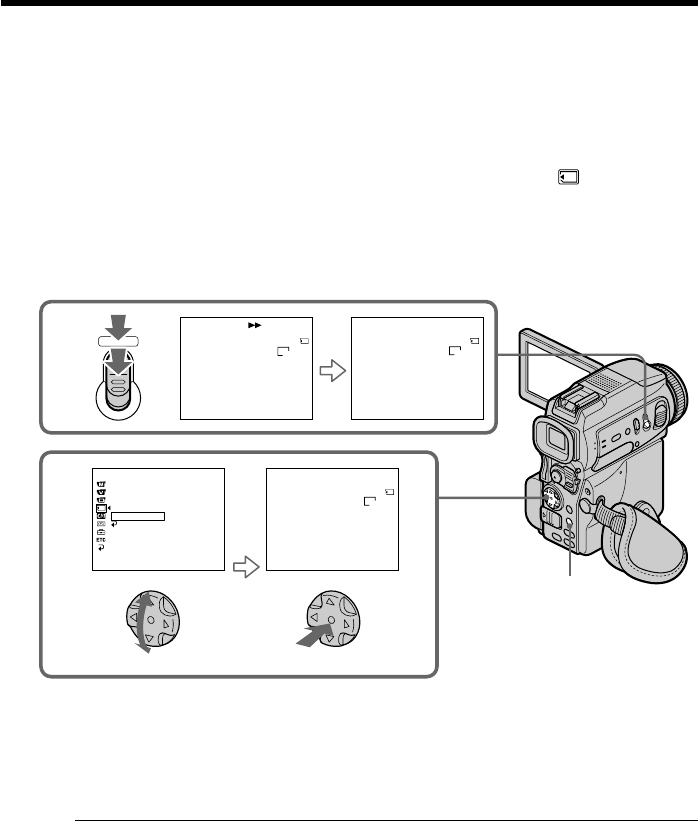
134
Using the search function, you can automatically take in only still images from tapes
and record them on a “Memory Stick” in sequence.
Before operation
•Insert a recorded tape into your camcorder and rewind the tape.
•Insert a “Memory Stick” into your camcorder.
(1)Set the POWER switch to VCR.
(2)Press MENU, then select and decide upon PHOTO SAVE in with the
control button (p. xx).
PHOTO BUTTON appears on the screen.
(3)Press PHOTO deeper. The still image from the tape is recorded on a “Memory
Stick.” The number of still images copied is displayed. END is displayed when
copying is completed.
To stop copying
Press MENU.
When the memory of the “Memory Stick” is full
MEMORY FULL appears on the screen, and the copying stops. Insert another “Memory
Stick” and repeat the procedure from step 2.
Image size of still images
Image size is automatically set to 640 × 480.
When the access lamp is lit or flashing
Do not shake or strike your camcorder. As well do not turn the power off, eject a
“Memory Stick” or remove the battery pack. Otherwise, the image data breakdown may
occur.
If the write-protect tab on the “Memory Stick” is set to LOCK
NOT READY appears when you select the item in the menu settings.
When you change “Memory Stick”s in the middle of copying
Your camcorder resumes copying from the last image recorded on the previous
“Memory Stick.”
Copying still images from a tape
– Photo save
3
2
PHOTO
SAV
I
NG
0
[
MENU
] :
END
PHOTO SAVE
4/15
0:00:00:00
END
4
[
MENU
] :
END
PHOTO SAVE
8/15
0:30:00:00
PHOTO BUTTON
[
PHOTO
] :
START
[
MENU
] :
END
PHOTO SAVE
4/15
0:00:00:00
MEMORY SET
ST I LL SET
MOV I E S E T
PR I NT MARK
PROTECT READYPHOTO SAVE
RETURN
[
MENU
] :
END
640
STD
640
STD
640
STD
MENU
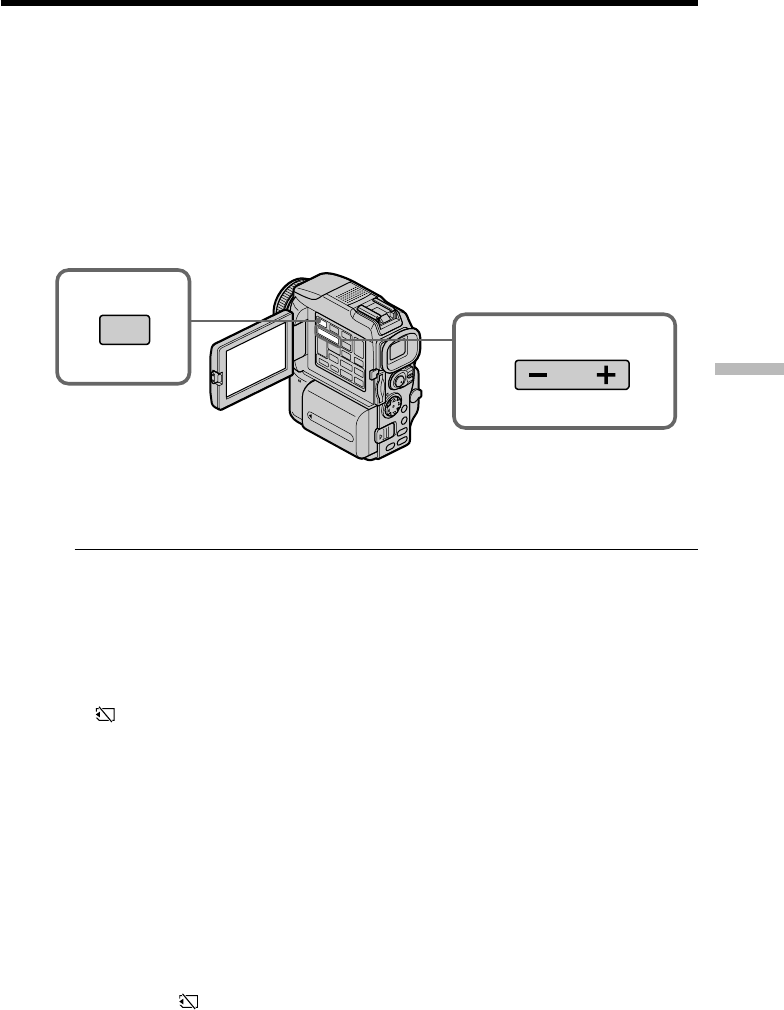
135
“Memory Stick” Operations
You can play back still images recorded on a “Memory Stick.” You can also play back
six images including moving pictures in order at a time by selecting the index screen.
Before operation
Insert a “Memory Stick” into your camcorder.
(1)Set the POWER switch to MEMORY or VCR. Make sure that the LOCK switch
is set to the right (unlock) position.
(2)Press MEMORY PLAY. The last recorded image is displayed.
(3)Press MEMORY +/– to select the desired still image. To see the previous
image, press MEMORY –. To see the next image, press MEMORY +.
To stop memory photo playback
Press MEMORY PLAY.
Note
You may not be able to play back images with your camcorder:
– when playing back image data modified on personal computers.
– when playing back image data shot with other equipment.
Notes on the file name
•The directory number may not be displayed and only the file name may be displayed
if the structure of the directory does not conform to the DCF standard.
•“ - DIRECTORY ERROR” may appear on the screen if the structure of the
directory does not conform to the DCF standard. While this message appears, you can
play back images but cannot record them on the “Memory Stick.”
•The file name flashes on the screen if the file is corrupted or the file is unreadable.
To play back recorded images on a TV screen
•Connect your camcorder to the TV with the A/V connecting cable supplied with your
camcorder before operation.
•When operating memory photo playback on a TV or on the LCD screen, the image
quality may appear to have deteriorated. This is not a malfunction. The image data is
as good as ever.
•Turn the audio volume of the TV down before operation, or noise (howling) may be
output from the TV speakers.
When no image is recorded on the “Memory Stick”
The message “ NO FILE” appears.
Viewing a still image
– Memory photo playback
2
PLAY
3
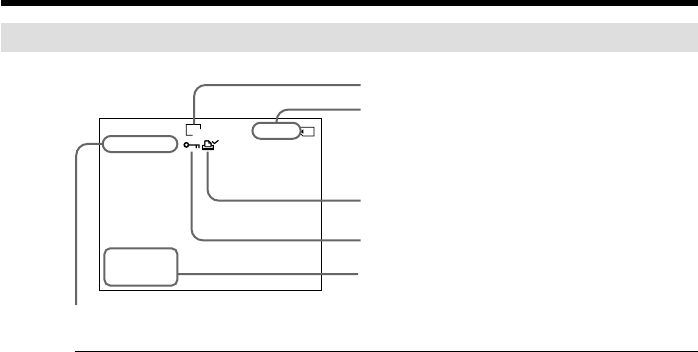
136
Screen indicators during still image playback
Recording data
When you press DATA CODE on the Remote Commander, you can see the recording
data (date/time or various settings when recorded).
Viewing a still image – Memory photo playback
Image number/Total number of recorded
images
Image size
Data Directory Number, File Number
Protect
Print mark
6 / 100
MEMORY PLAY
100-0006
640
JUL 4 2001
12:05:56 AM
Recording data/time/various settings
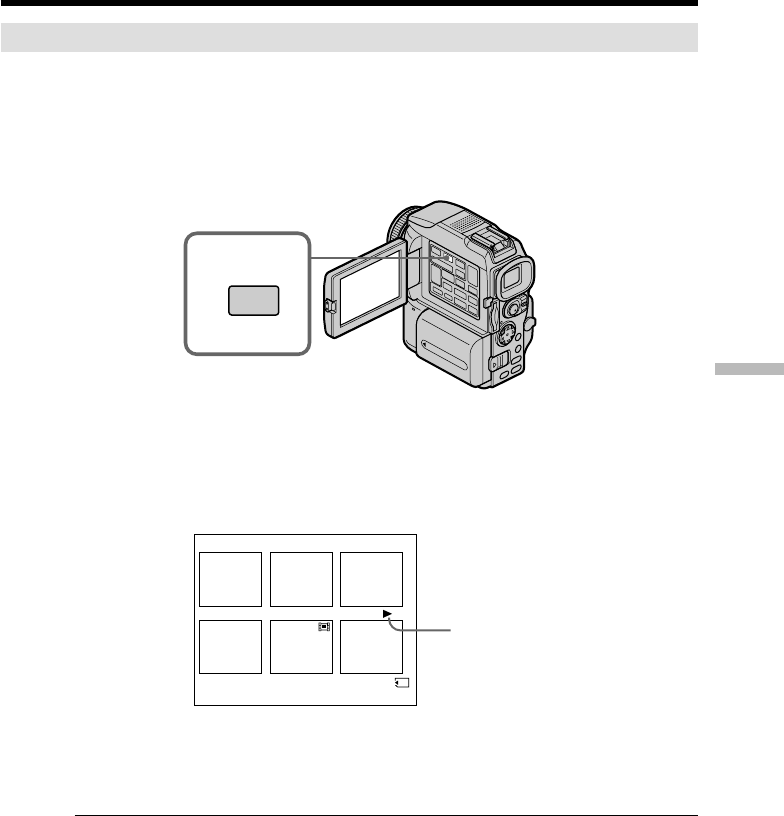
137
“Memory Stick” Operations
Playing back six recorded images at a time (index screen)
You can play back six recorded images at a time. This function is especially useful when
searching for a particular image.
(1)Set the POWER switch to MEMORY or VCR. Make sure that the LOCK switch
is set to the right (unlock) position.
(2)Press MEMORY INDEX to display the index screen.
A red B mark appears above the image that is displayed before changing to the index
screen mode.
MEMORY –: to display the previous six images
MEMORY + : to display the following six images
To return to the normal playback screen (single screen)
Press MEMORY +/– to move the B mark to the image you want to display on full
screen, then press MEMORY PLAY.
Note
When displaying the index screen, the number appears above each image. This
indicates the order in which images are recorded on the “Memory Stick.” These
numbers are different from the data file names (p. xx).
Image data modified with your computers or shot with other equipment
These files may not be displayed on the index screen.
Viewing a still image – Memory photo playback
2
INDEX
B mark
6 / 100
100-0006
1 2 3
4 5 6
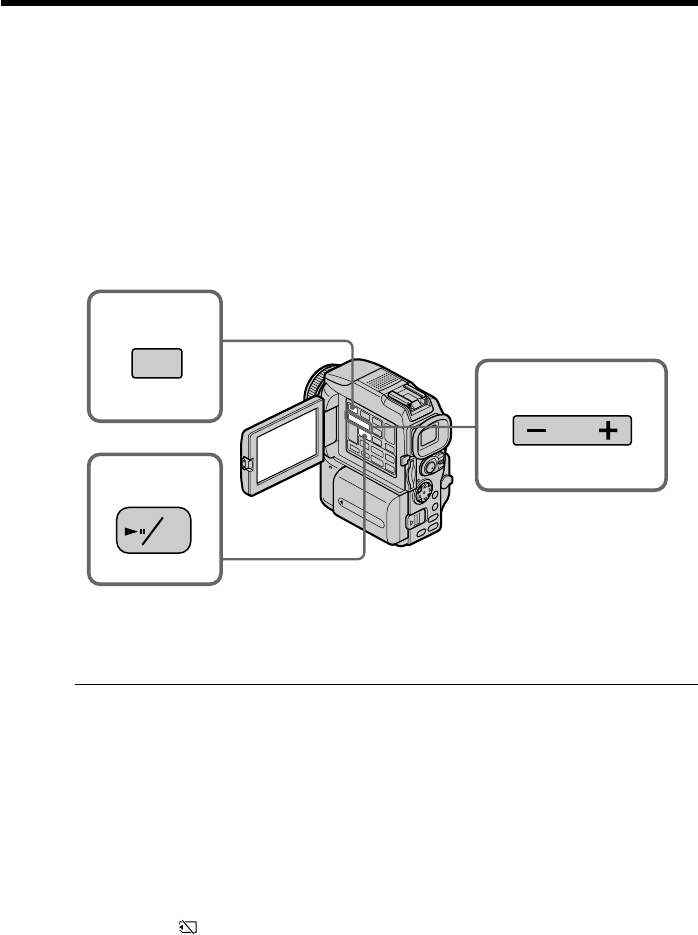
138
You can play back moving pictures recorded on a “Memory Stick.” You can also play
back six images including still images in order at a time by selecting the index screen.
Before operation
Insert a “Memory Stick” into your camcorder.
(1)Set the POWER switch to MEMORY or VCR. Make sure that the LOCK switch
is set to the right (unlock) position.
(2)Press MEMORY PLAY. The last recorded image is displayed.
(3)Press MEMORY +/– to select the desired moving pictures. To see the previous
picture, press MEMORY –. To see the next picture, press MEMORY +.
(4)Press MPEG N X to start playback.
To stop MPEG movie playback
Press MEMORY PLAY.
Note
You may not be able to play back images with your camcorder:
– when playing back image data modified on your computers.
– when playing back image data shot with other equipment.
To play back recorded images on a TV screen
•Connect your camcorder to the TV with the A/V connecting cable supplied with your
camcorder before operation.
•Turn the audio volume of the TV down before operation, or noise (howling) may be
output from the TV speakers.
When no image is recorded on the “Memory Stick”
The message “ NO FILE” appears.
Viewing a moving picture
– MPEG movie playback
3
2
4
PLAY
MPEG PB
ZOOM
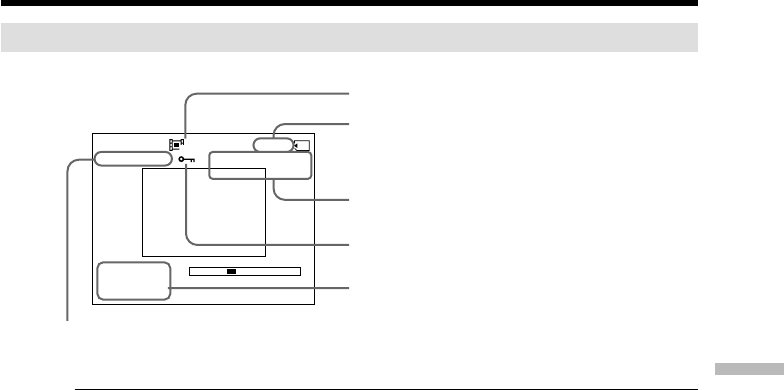
139
“Memory Stick” Operations
Screen indicators during moving picture playback
Recording date/time
To display the recording date/time, press DATA CODE on the Remote Commander
during playback.
Viewing a moving picture – MPEG movie playback
Picture number/Total number of recorded
pictures
Image size
Data directory number/File number
Protect
JUL 4 2001
12:05:56 AM
320
MOV
00001
MEMORY PL AY
2/20
0:12
–––
–––
Memory playback
Recording date/time.
(Various settings are displayed as “– – –.”)

140
You can view data recorded on the “Memory Stick” using your computer.
Notes
•Data recorded on the “Memory Stick” is stored in the following formats. Make sure
that applications that support these file formats are installed on your computer.
–Still images: JPEG format
–Moving images/audio: MPEG format
Recommended computer environment
Recommended Windows environment
OS: Microsoft Windows 98, Windows 98SE, Windows Me or Windows 2000
Professional standard installation is required.
However, operation is not assured if the above environment is upgraded OS.
CPU:MMX Pentium 200 MHz or faster
The USB connector must be provided as standard.
An application such as Real Player or Windows Media Player capable of playing back
MPEG picture must be installed (to play back moving pictures).
Recommended Macintosh environment
Macintosh computer with the Mac OS 8.5.1/8.6/9.0/9.1 or Mac OS X standard
installation
However, note that the update to Mac OS 9.0/9.1 should be used for the following
models.
•iMac with the Mac OS 8.6 standard installation and a slot loading type CD-ROM drive
•iBook or Power Mac G4 with the Mac OS 8.6 standard installation
The USB connector must be provided as standard.
QuickTime 3.0 or newer must be installed (to play back moving pictures).
Notes
•Operations are not guaranteed for either the Windows or Macintosh environment if
you connect two or more USB equipment to a single computer at the same time, or
when using a hub.
•Depending on the type of USB equipment that is used simultaneously, some
equipment may not operate.
•Operations are not guaranteed for all the recommended computer environments
mentioned above.
•All other product names mentioned herein may be the trademarks or registered
trademarks of their respective companies. Furthermore, “™” and “®” are not
mentioned in each case in this manual.
Viewing images using computer
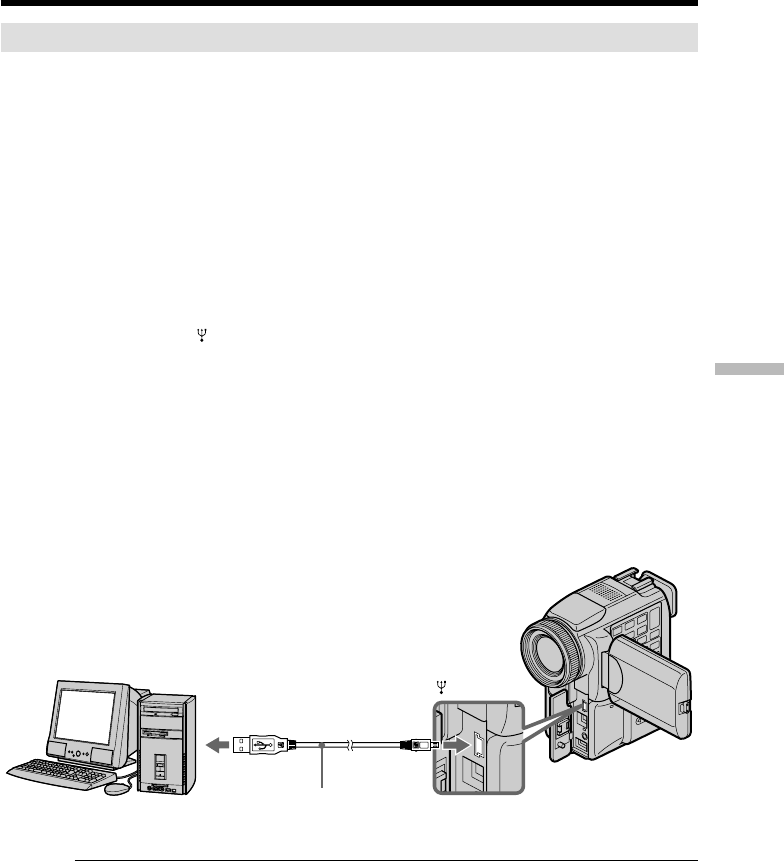
141
“Memory Stick” Operations
Installing the USB driver
Before connecting your camcorder to your computer, install the USB driver to the
computer. The USB driver is contained together with application software for viewing
images on a CD-ROM which is supplied with your camcorder.
Do not connect the USB cable to your computer before installation of the USB driver is
completed.
Example: For Windows 98/98SE/Me, Windows 2000 users
(1)Turn on the power of your computer and allow Windows to load.
(2)Insert the supplied CD-ROM in the CD-ROM drive of your computer. The
application software screen appears.
(3)Set the cursor on “USB Driver Installation for Windows 98/98SE/Me and
Windows 2000” and click. USB driver installation starts.
(4)Follow the on-screen messages to install the USB driver.
(5)Connect the (USB) jack on your camcorder with the USB connector on your
computer using the supplied USB cable.
(6)Insert a “Memory Stick” into your camcorder, connect the AC power adaptor
and set the POWER switch to MEMORY.
USB MODE appears on the LCD screen of your camcorder. Your computer
recognizes the camcorder, and the Windows Add Hardware Wizard starts.
(7)Follow the on-screen messages to have the Add Hardware Wizard recognize
the hardware. The Add Hardware Wizard starts twice because two different
USB drivers are installed. Be sure to allow the installation to complete without
interrupting it.
Notes
•You cannot install the USB driver if a “Memory Stick” is not in your camcorder.
Be sure to insert a “Memory Stick” into your camcorder before installing the USB
driver.
•The USB driver has been registered incorrectly as your computer was connected to
your camcorder before installation of the USB driver was completed. Re-install the
USB driver following the procedure on page xxx.
Viewing images using computer
USB connector
(USB) jack
USB cable Push into the end

142
Viewing images using computer
Image data cannot be transferred by the USB connection
The USB driver has been registered incorrectly as your computer was connected to your
camcorder before installation of the USB driver was completed. Perform the following
procedure to correctly install the USB driver.
Step 1 Uninstall the incorrect USB driver
1Turn on the power and allow Windows to load.
2Connect the USB jack on your computer to the (USB) jack on your camcorder
using the USB cable supplied with your camcorder.
3Insert a “Memory Stick” into your camcorder, connect the AC power adaptor,
and set the POWER switch to MEMORY.
4Open your computer’s “Device Manager”.
Windows 2000 Professional:
Open “My Computer” t “Control Panel” t “Hardware” tab, and click the
“Device Manager” button.
Other OS:
Select “My Computer” t “Control Panel” t “System”, and click “Device
Manager”.
5Select “Other devices”.
Select the device prefixed with the “?” mark and delete.
Ex: (?)Sony Handycam
6Turn the power OFF (CHG), and then disconnect the USB cable.
7Restart your computer.
Step 2 Install the USB driver on the CD-ROM
Perform the entire procedure listed in “Installing the USB Driver” on the page xxx.
Example: For Mac OS 8.5.1/8.6/9.0 users
(1)Turn on the power of your computer and allow the Mac OS to load.
(2)Insert the supplied CD-ROM in the CD-ROM drive of your computer.
(3)Double-click the CD-ROM drive icon to open the window.
(4)Double-click the icon of the hard disk containing the OS to open the window.
(5)Move the following two files from the window opened in step 3 to the System
Folder icon in the window opened in step 4 (drag and drop).
•Sony Camcorder USB Driver
•Sony Camcorder USB Shim
(6)When “Put these items into the Extensions folder?” appears, click OK.
(7)Restart your computer.
For Mac OS 9.1 and Mac OS X
The USB driver need not be installed. Your Mac is automatically recognized as a driver
just by connecting your Mac using the USB cable.
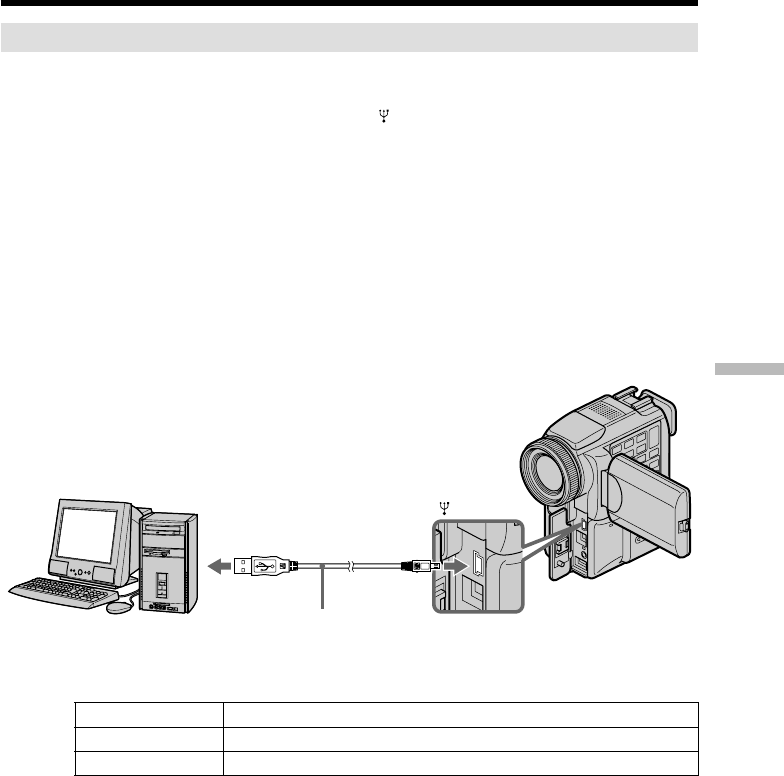
143
“Memory Stick” Operations
Viewing images
For Windows users
(1)Turn on the power of your computer and allow Windows to load.
(2)Connect one end of USB cable to the (USB) jack on the camcorder and the
other end to the USB connector on your computer.
(3)Insert a “Memory Stick” into your camcorder, and connect the AC power
adaptor to your camcorder and then to a wall outlet.
(4)Set the POWER switch to MEMORY.
USB MODE appears on the screen of the camcorder.
(5)Open “My Computer” on Windows and double click the newly recognized
drive (Example: “Removable Disk (E:)”).
The folders inside the “Memory Stick” are displayed.
(6)Select and double-click the desired image file from the folder.
For the detailed folder and file name, see ”Image file storage destinations and
image files” (p. xx).
Desired file type Double-click in this order
Still image “Dcim” folder t“100msdcf” folder tImage file
Moving picture* “Mssony” folder t“Moml0001” folder tImage file*
* Copying a file to the hard disk of your computer before viewing it is recommended. If
you play back the file directly from the “Memory Stick,” the image and sound may
break off.
Viewing images using computer
USB connector
USB cable Push into the end
(USB) jack

144
Viewing images using computer
For Windows 2000 Professional/Me users
To unplug the USB cable or eject the “Memory Stick”, follow the procedure below.
(1)Move the cursor to the “Unplug or Eject Hardware” icon on the Task Tray and
click to cancel the applicable drive.
(2)A message to remove the device from the system appears, then unplug the
USB cable or eject the “Memory Stick.”
For Macintosh users
To unplug the USB cable or eject the “Memory Stick”, follow the procedure below.
(1)Quit application programs opened.
Make sure that the access lamp of the hard disk is not lit.
(2)Drag and drop the “Memory Stick” icon to the Trash or select Eject under the
Special menu.
(3)Unplug the USB cable or eject the “Memory Stick.”
For Mac OS X users
Unplug the USB cable or eject the “Memory Stick” after shutting down your computer.
Notes on using your computer
“Memory Stick”
•“Memory Stick” operations on your camcorder cannot be assured if a “Memory Stick”
formatted on your computer is used on your camcorder, or if the “Memory Stick” in
your camcorder was formatted from your computer when the USB cable was
connected.
•Do not optimize the “Memory Stick” on a Windows machine. This will shorten the
“Memory Stick” life.
•Do not compress the data on the “Memory Stick.” Compressed files cannot be played
back on your camcorder.
Software
•Depending on your application software, the file size may increase when you open a
still image file.
•When you load an image modified using a retouch software from your computer to
the camcorder or when you directly modify the image on the camcorder, the image
format will differ so a file error indicator may appear and you may be unable to open
the file.
Communications with your computer
Communications between your camcorder and your computer may not recover after
recovering from Suspend, Resume, or Sleep.
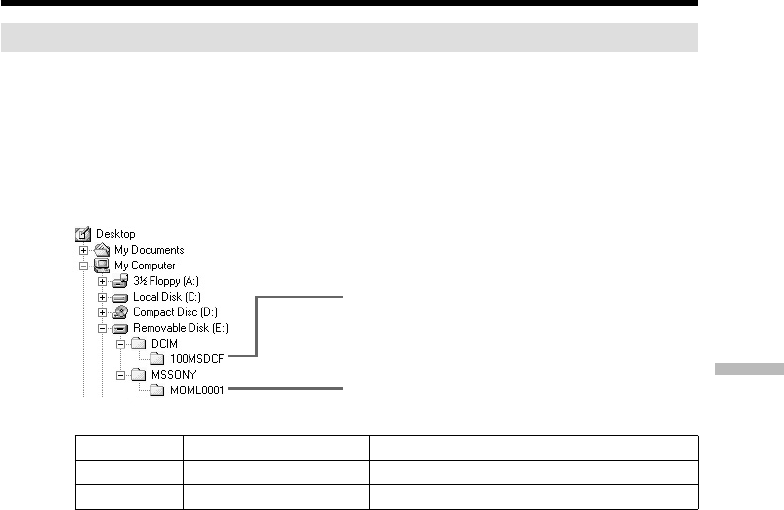
145
“Memory Stick” Operations
Image file storage destinations and image files
Image files recorded with your camcorder are grouped in folders by recording mode.
The meanings of the file names are as follows. ssss stands for any number within
the range from 0001 to 9999.
For Windows Me users
(The drive recognizing the camera is [E:].)
Folder File Meaning
100msdcf DSC0ssss.JPG Still image file
Moml0001 MOV0ssss.MPG Moving picture file
Viewing images using computer
Folder containing moving picture data
Folder containing still image data
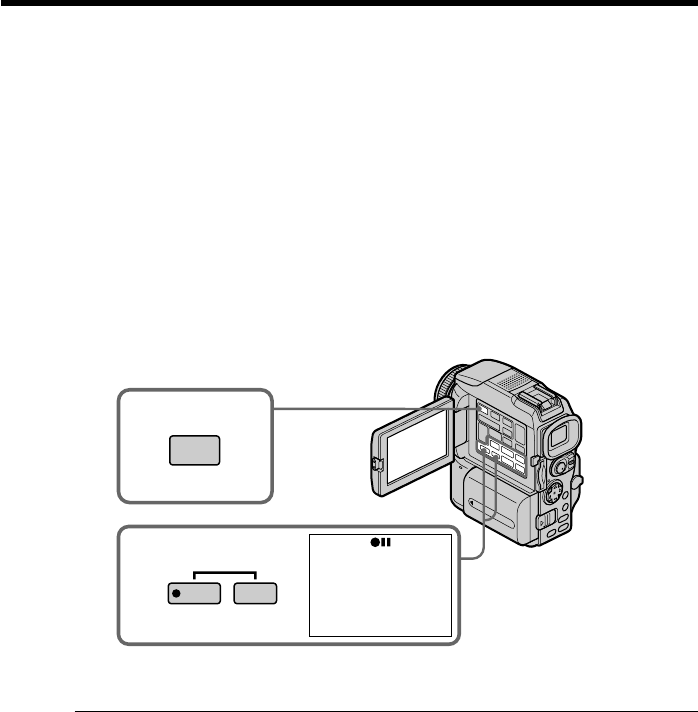
146
You can copy images recorded on “Memory Stick” and record them to a tape.
Before operation
•Insert a tape for recording into your camcorder.
•Insert a “Memory Stick” into your camcorder.
(1)Set the POWER switch to VCR.
(2)Using the video control buttons, search a point where you want to record the
desired images. Set the tape to playback pause.
(3)Press z REC and the button on its right simultaneously on your camcorder.
The tape is set to the recording pause mode.
(4)Press MEMORY PLAY. The last recorded image is displayed.
(5)Press MEMORY +/– to select the desired image. To see the previous image,
press MEMORY –. To see the next, press MEMORY +.
(6)Press X to start recording and press X again to stop.
z appears on the screen during recording.
(7)If you have more to copy, repeat steps 5 and 6.
To stop copying in the middle
Press x.
During copying
You cannot operate the following buttons:
–MEMORY PLAY
–MEMORY INDEX
–MEMORY DELETE
–MEMORY +/–
–MEMORY MIX
Note on the index screen
You cannot record the index screen.
If you press EDITSEARCH during pause mode
Memory playback stops.
Image data modified with your computers or shot with other equipment
You may not be able to copy them with your camcorder.
If you press DISPLAY in during recording or in recording standby mode
You can see memory playback and the file name indicators in addition to the indicators
pertinent to tapes, such as the time code indicator.
Copying the image recorded on “Memory
Stick”s to tapes
3
4PLAY
REC
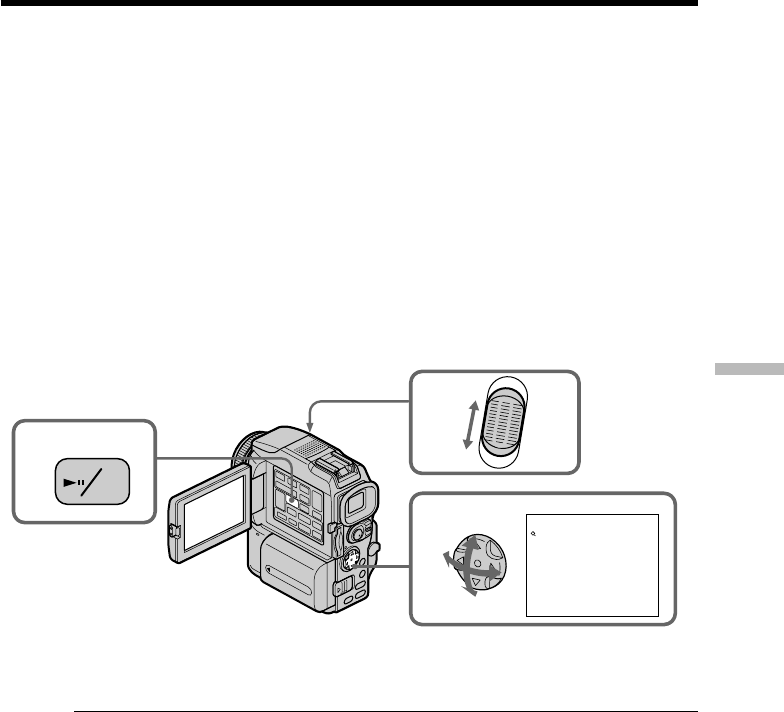
147
“Memory Stick” Operations
You can enlarge still images recorded on a “Memory Stick.” You can select and view the
desired part from the enlarged still image. Also you can copy the desired part of the
enlarged still image to tapes or “Memory Stick”s.
Before operation
Insert a “Memory Stick” into your camcorder.
(1)Set the POWER switch to MEMORY or VCR. Make sure that the LOCK switch
is set to the right (unlock) position.
(2)In the memory playback mode, press PB ZOOM on your camcorder.
The center of the image is enlarged to twice its size.
(3)Press the control button to move the image.
The image moves in the same direction as the control button.
(4)Adjust the zoom ratio by the power zoom lever.
You can enlarge the image from 1.1 times up to five times its size.
W : Decreases the zoom ratio.
T : Increases the zoom ratio.
To cancel the PB ZOOM function
Press PB ZOOM.
In the PB ZOOM mode
The digital effect function does not work.
The PB ZOOM function is canceled when the following buttons are pressed:
– MENU
– MEMORY PLAY
– MEMORY INDEX
– MEMORY +/–
Moving pictures recorded on “Memory Stick”s
The PB ZOOM function does not work.
To record an image processed by PB ZOOM on “Memory Stick”s
Press the PHOTO button to record the image processed by PB ZOOM. (The image size
becomes 640 × 480)
Enlarging still images recorded on
“Memory Stick”s – Memory PB ZOOM
24
3
W
T
PB ZOOM
× 5.0
MPEG PB
ZOOM
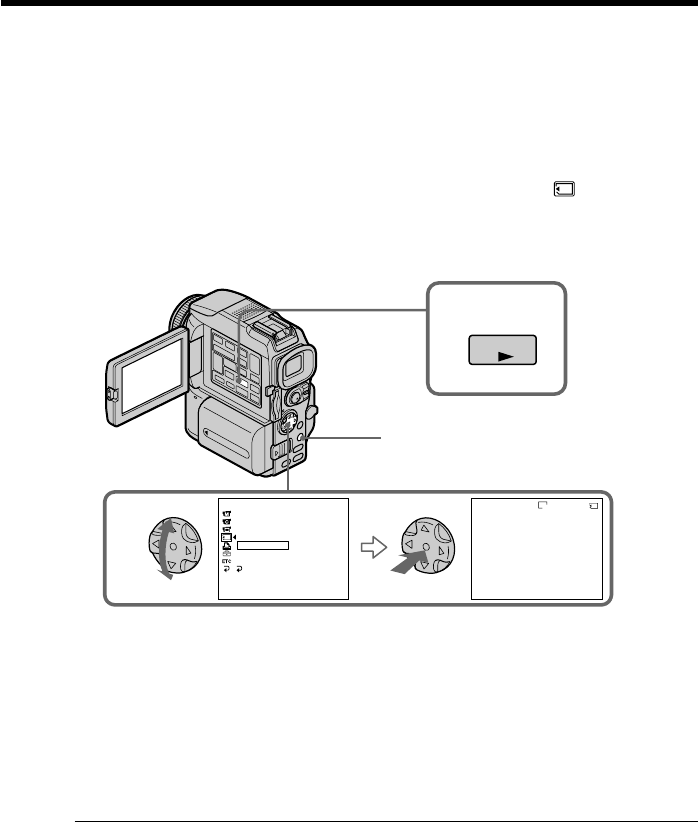
148
You can automatically play back images in sequence. This function is useful especially
when checking recorded images or during a presentation.
Before operation
Insert a “Memory Stick” into your camcorder.
(1)Set the POWER switch to MEMORY. Make sure that the LOCK switch is set to
the right (unlock) position.
(2)Press MENU, then select and decide upon SLIDE SHOW in with the
control button (p. xx).
(3)Press MEMORY PLAY. Your camcorder plays back the images recorded on a
“Memory Stick” in sequence.
To stop the slide show
Press MENU.
To pause during a slide show
Press MEMORY PLAY.
To start the slide show from a particular image
Select the desired image using MEMORY +/– buttons before step 2.
To view the recorded images on TV
Connect your camcorder to a TV with the A/V connecting cable supplied with your
camcorder before operation.
If you change the “Memory Stick” during operation
The slide show does not operate. If you change the “Memory Stick,” be sure to follow
the steps again from the beginning.
Playing back images in a continuous loop
– SLIDE SHOW
3
2
MEMORY SET
ST I LL SET
MOV I E SE T
PR I NT MARK
PROTECT
SL IDE SHO
W
READY
DELETE ALL
FORMAT
RETURN
[
MENU
] :
END
640
[
MPLAY
]:
START
[
MENU
]:
END
SL IDE SHO
W
100-0001 1/100
PLAY
MENU
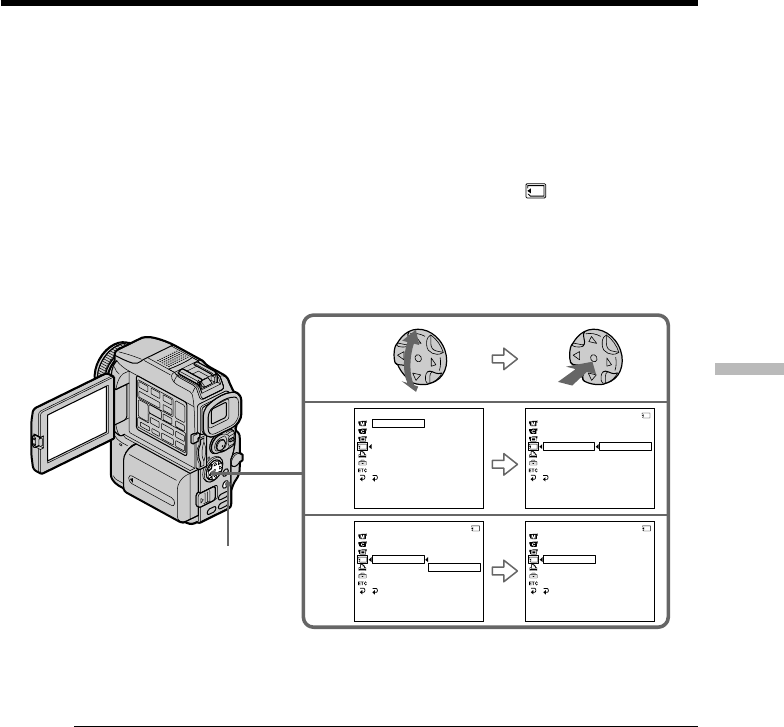
149
“Memory Stick” Operations
To prevent accidental erasure of important images, you can protect selected images.
Before operation
Insert a “Memory Stick” into your camcorder.
(1)Set the POWER switch to MEMORY or VCR. Make sure that the LOCK switch
is set to the right (unlock) position.
(2)Play back the image you want to protect.
(3)Press MENU, then select and decide upon PROTECT in with the control
button (p. xx).
(4)Select and decide upon ON with the control button.
(5)Press MENU to make the menu display disappear. The “-” mark is
displayed beside the data file name of the selected image.
To cancel image protection
Select and decide upon OFF with the control button in step 4.
Note
Formatting erases all information on the “Memory Stick,” including the protected
image data. Check the contents of the “Memory Stick” before formatting.
If the write-protect tab on the “Memory Stick” is set to LOCK
You cannot carry out image protection.
Preventing accidental erasure
– Image protection
3
4
MEMORY SET
ST I LL SET
MOV I E S E T
PR I NT MARK
PROTECT
SL IDE SHO
W
DELETE ALL
FORMAT
RETURN
[
MENU
] :
END
MEMORY SET
ST I LL SET
MOV I E S E T
PRINT MARK
PROTECT
SL IDE SHO
W
ON
OFF
DELETE ALL
FORMAT
RETURN
[
MENU
] :
END
10/ 12
MEMORY SET
ST I LL SET
MOV I E S E T
PR I NT MARK
PROTECT
SL IDE SHO
W
ON
DELETE ALL
FORMAT
RETURN
[
MENU
] :
END
10/12
MEMORY SET
ST I LL SET
MOV I E S E T
PR I NT MARK
PROTECT
SL IDE SHO
W
OFF
DELETE ALL
FORMAT
RETURN
[
MENU
] :
END
10/12
MENU
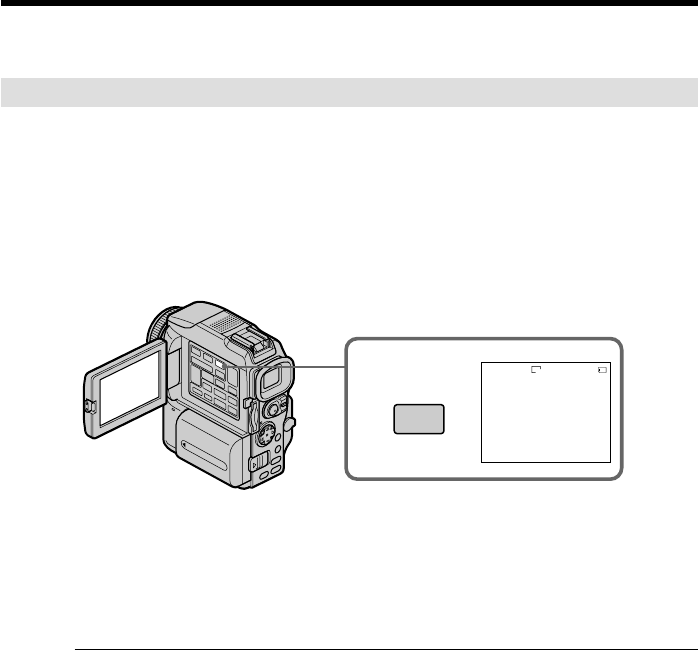
150
You can delete images stored in a “Memory Stick.” You can delete all images or selected
images.
Deleting selected images
Before operation
Insert a “Memory Stick” into your camcorder.
(1)Set the POWER switch to MEMORY or VCR. Make sure that the LOCK switch
is set to the right (unlock) position.
(2)Playback the image to delete.
(3)Press MEMORY DELETE. “DELETE?” appears on the screen.
(4)Press MEMORY DELETE again. The selected image is deleted.
To cancel deleting an image
Press MEMORY – in step 4.
To delete an image displayed on the index screen
Press MEMORY +/– to move the B indicator to the desired image you want to delete
and follow steps 3 and 4.
Notes
•To delete a protected image, first cancel image protection.
•Once you delete an image, you cannot restore it. Check the images to delete carefully
before deleting them.
If the write-protect tab on the “Memory Stick” is set to LOCK
You cannot delete images.
Deleting images
3
DELETE
DELETE?
640
[
DELETE
] :
DEL
[–] :
CANCEL
DELETE
100-0010 89 /100
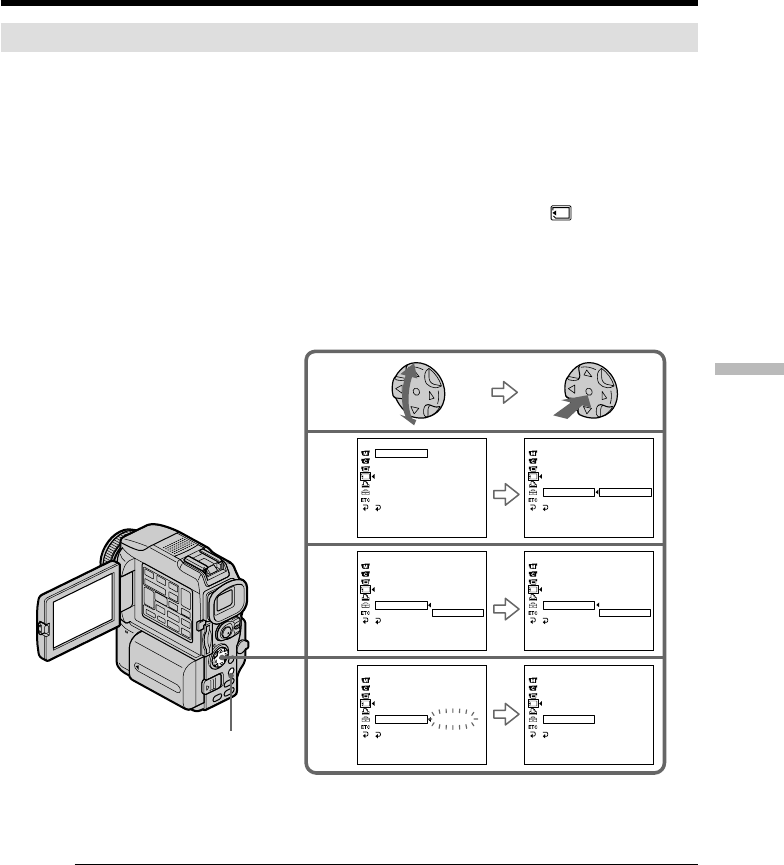
151
“Memory Stick” Operations
Deleting all the images
You can delete all the unprotected images in a “Memory Stick.”
Before operation
Insert a “Memory Stick” into your camcorder.
(1)Set the POWER switch to MEMORY. Make sure that the LOCK switch is set to
the right (unlock) position.
(2)Press MENU, then select and decide upon DELETE ALL in with the control
button (p. xx).
(3)Select and decide upon OK with the control button. OK changes to EXECUTE.
(4)Select and decide upon EXECUTE with the control button. DELETING flashes
on the screen. When all the unprotected images are deleted, COMPLETE is
displayed.
To cancel deleting all the images in the “Memory Stick”
Select and decide upon RETURN with the control button in step 3.
While DELETING appears
Do not turn the POWER switch or press any buttons.
Deleting images
2
4
3
MEMORY SET
ST I LL SET
MOV I E S E T
PR I NT MARK
PROTECT
SL IDE SHO
W
DELETE ALL RETURN
FORMAT OK
RETURN
[
MENU
] :
END
MEMORY SET
ST I LL SET
MOV I E S E T
PR I NT MARK
PROTECT
SL IDE SHO
W
DE LETE A L L RE TURN
FORMAT OK
RETURN
[
MENU
] :
END
MEMORY SET
ST I LL SET
MOV I E S E T
PRINT MARK
PROTECT
SL IDE SHO
W
DELETE ALL RETURN
FORMAT EXECUTE
RETURN
[
MENU
] :
END
MEMORY SET
ST I LL SET
MOV I E S E T
PR I NT MARK
PROTECT
SL IDE SHO
W
DELETE ALL DELET ING
FORMAT
RETURN
[
MENU
] :
END
MEMORY SET
ST I LL SET
MOV I E S E T
PRINT MARK
PROTECT
SL IDE SHO
W
DELETE ALL COMPLETE
FORMAT
RETURN
[
MENU
] :
END
MEMORY SET
ST I LL SET
MOV I E S E T
PR I NT MARK
PROTECT
SL IDE SHO
W
DELETE ALL
FORMAT
RETURN
[
MENU
] :
END
MENU
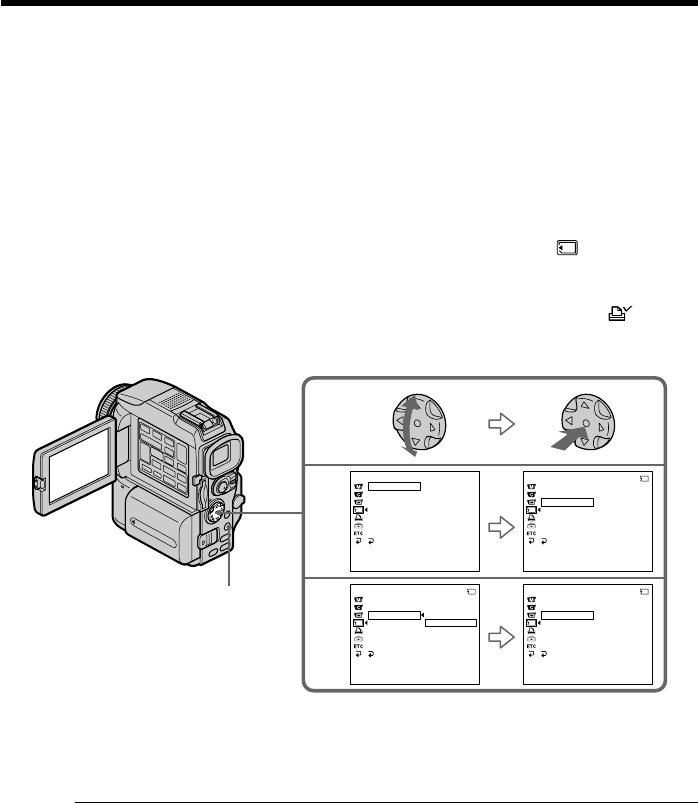
152
You can specify the recorded still image to print out by putting marks. This function is
useful for printing out still images later.
Your camcorder conforms with the DPOF (Digital Print Order Format) standard for
specifying the still images to print out.
Before operation
Insert a “Memory Stick” into your camcorder.
(1)Set the POWER switch to MEMORY or VCR. Make sure that the LOCK switch
is set to the right (unlock) position.
(2)Playback the still image you want to write a print mark on.
(3)Press MENU, then select and decide upon PRINT MARK in with the
control button (p. xx).
(4)Select and decide upon ON with the control button.
(5)Press MENU to make the menu display disappear. The print mark is
displayed beside the data file name of the image.
To cancel writing print marks
Select and decide upon OFF with the control button in step 4.
If the write-protect tab on the “Memory Stick” is set to LOCK
You cannot write print marks on still images.
Moving pictures
You cannot write print marks on moving pictures.
While the file name is flashing
You cannot write a print mark on the still image.
Writing a print mark – PRINT MARK
3
4
MEMORY SET
ST I LL SET
MOV I E S E T
PR I NT MARK
PROTECT
SL IDE SHO
W
DELETE ALL
FORMAT
RETURN
[
MENU
] :
END
MEMORY SET
ST I LL SET
MOV I E S E T
PR I NT MARK
PROTECT
SL IDE SHO
W
OFF
DELETE ALL
FORMAT
RETURN
[
MENU
] :
END
10/ 12
MEMORY SET
ST I LL SET
MOV I E S E T
PRINT MARK
PROTECT
SL IDE SHO
W
ON
OFF
DELETE ALL
FORMAT
RETURN
[
MENU
] :
END
10/ 12
MEMORY SET
ST I LL SET
MOV I E S E T
PR I NT MARK
PROTECT
SL IDE SHO
W
ON
DELETE ALL
FORMAT
RETURN
[
MENU
] :
END
10/12
MENU
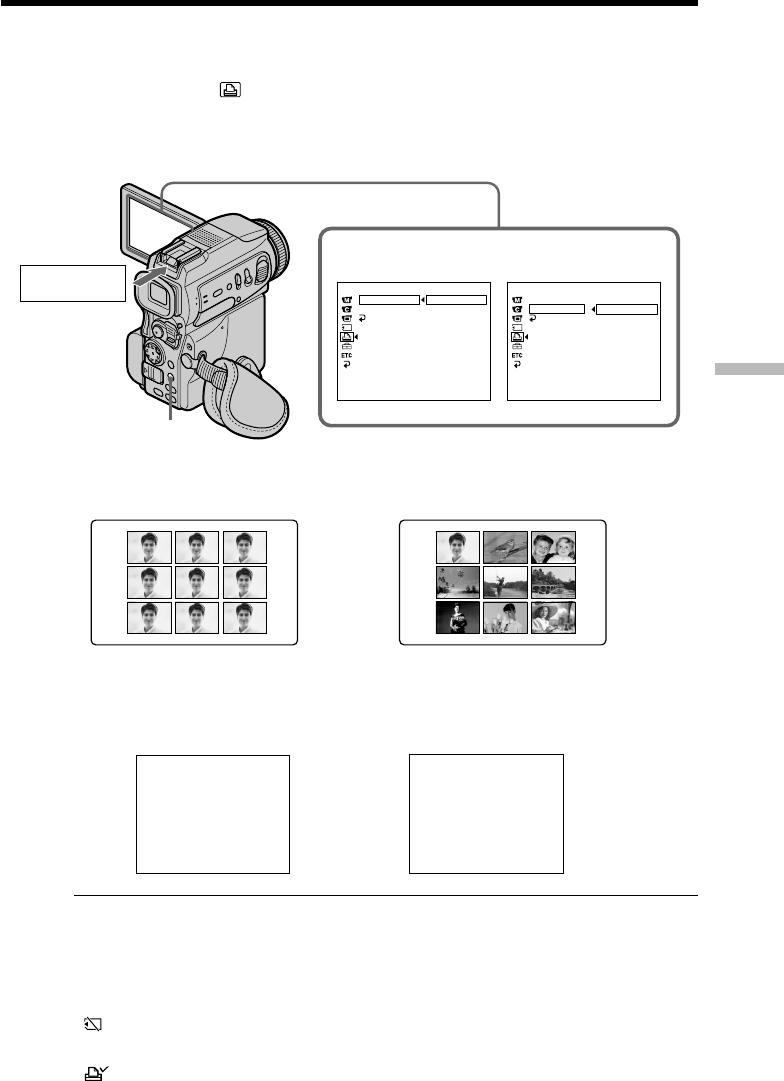
153
“Memory Stick” Operations
You can use the optional printer on your camcorder to print images on the print paper.
For details, refer to the operating instructions of the printer.
There are various ways of printing still images. The following, however, describes how
to print by selecting in the menu on your camcorder.
Before operation
•Insert a recorded “Memory Stick” into your camcorder.
•Connect the optional printer to your camcorder as illustrated.
You can print nine still images on the 9-split print paper. Select the desired mode in the
menu settings.
* Nine still images with print marks are printed together.
You can make prints with the recording date and/or recording time. Select the desired
mode in the menu settings.
Images recorded in multi screen mode
You cannot print images recorded in multi screen mode on sticker type print paper.
Moving pictures recorded on “Memory Stick”
You cannot print moving pictures.
When “Memory Stick” has no files
“ NO STILL IMAGE FILE” appears on the screen.
When there are no files with a PRINT MARK
“ NO PRINT MARK” appears on the screen.
Using the optional printer
SAME PICS MULTI PICS or *MARKED PICS
DATE
JUL 4 2001
DAY & TIME
412
:00
AM
Printer
PR I NT SET
[
MENU
] :
END
RETURN
9PIC PRINT
DATE
/
TIME RETURN
SAME
MUL T I
MARKED
PR I NT SET
[
MENU
] :
END
RETURN
9PIC PRINT
DATE
/
TIME OFF
DATE
DAY&T IME
DATE
MENU
9PIC PRINT DATE/TIME
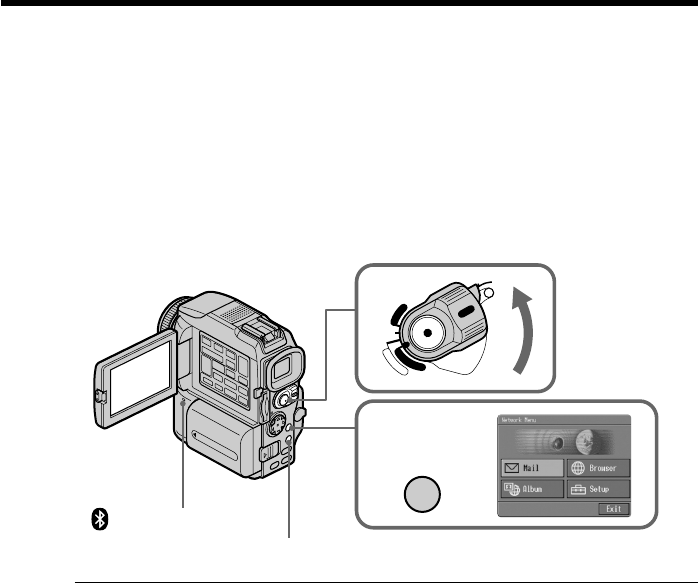
154
– DCR-PC120BT only
You can access to the Internet using a Bluetooth equipped device that is complied to the
camcorder. Once the access is made, you can view a Web page, send/receive your e-
mail, or make your album on Web, etc. This section described only how to open the
Network Menu.
(1)Set the POWER switch to MEMORY.
(2)Press NETWORK.
Bluetooth lamp flashes and Network Menu appears.
For the details, refer to the operating instructions supplied with your camcorder.
On trademarks
•The BLUETOOTH trademarks are owned by their proprietor and used by Sony
Corporation under license.
•All other product names mentioned herein may be the trademarks or registered
trademarks of their respective companies. Furthermore, TM and R are not mentioned
in each case in this manual.
Note
Make sure that your camcorder is in the standby mode with the POWER switch set to
MEMORY.
During using the network function
You cannot use the optional printer.
— Using the Network function —
Accessing to the network
LOCK
POWER
V
C
R
M
E
M
O
R
Y
C
A
M
E
R
A
OFF
(CHG)
1
2
NETWORK
BROWSER MENU
(Bluetooth) lamp

155
Troubleshooting
— Troubleshooting —
Types of trouble and their solutions
If you run into any problem using your camcorder, use the following table to
troubleshoot the problem. If the problem persists, disconnect the power source and
contact your Sony dealer or local authorized Sony service facility. If “C:ss:ss”
appears on the screen, the self-diagnosis display function has worked. See page xx.
In the recording mode
Symptom Cause and/or Corrective Actions
•The POWER switch is not set to CAMERA.
cSet it to CAMERA (p. xx).
•The tape has run out.
cRewind the tape or insert a new one (p. xx, xx).
•The write-protect tab is set to expose the red mark.
cUse a new tape or slide the tab (p. xx).
•The tape is stuck to the drum (moisture condensation).
cRemove the cassette and leave your camcorder for at
least one hour to acclimatize (p. xxx).
•While being operated in CAMERA mode, your camcorder
has been in the standby mode for more than five minutes.
cSet the POWER switch to OFF (CHG) and then to
CAMERA (p. xx).
•The battery pack is dead or nearly dead.
cInstall a charged battery pack (p. xx).
•Viewfinder is not extended to the end.
cPull out the viewfinder.
•The viewfinder lens is not adjusted.
cAdjust the viewfinder lens (p. xx).
•STEADYSHOT is set to OFF in the menu settings.
cSet it to ON (p. xx).
•The setting is the manual focus mode.
cSet FOCUS to the auto focus mode (p. xx).
•Shooting conditions are not suitable for autofocus.
cAdjust to focus manually (p. xx).
•The LCD panel is open.
cClose the LCD panel (p. xx).
•The contrast between the subject and background is too
high. Your camcorder is not a malfunction.
•Your camcorder is not a malfunction.
•Slow shutter, low lux of PROGRAM AE or Super
NightShot mode is activated. This is not a malfunction.
•If 10 minutes elapse after you set the POWER switch to
CAMERA or DEMO MODE is set to ON in the menu
settings without a cassette inserted, your camcorder
automatically starts the demonstration.
cInsert a cassette and the demonstration stops.
You can also cancel DEMO MODE (p. xx).
START/STOP does not operate.
The power goes off.
The image on the viewfinder screen
is not clear.
The SteadyShot function does not
work.
The autofocusing function does not
work.
The picture does not appear in the
viewfinder.
A vertical band appears when you
shoot a subject such as lights or a
candle flame against a dark
background.
A vertical band appears when you
shoot a very bright subject.
Some tiny white spots appear on the
screen.
An unknown picture is displayed on
the screen.
(continued on the following page)

156
Symptom Cause and/or Corrective Actions
•NIGHTSHOT is set to ON.
cSet it to OFF (p. xx).
•NIGHTSHOT is set to ON in a bright place.
cSet it to OFF (p. xx).
•The backlight function is active.
cSet it off (p. xx).
•BEEP is set to OFF in the menu settings.
cSet it to MELODY or NORMAL (p. xx).
cSet the STEADYSHOT in the menu settings to OFF
(p. xx).
•The power of the external flash is off or the power source
is not installed.
cTurn on the external flash or install the power source.
•Two or more external flashes (optional) are attached.
cOnly one external flash (optional) can be attached.
In the playback mode
Symptom Cause and/or Corrective Actions
•The POWER switch is not set to VCR.
cSet it to VCR (p. xx).
•The tape has run out.
cRewind the tape (p. xx).
•The video head may be dirty.
cClean the heads using the cleaning cassette (optional)
(p. xx).
•The stereo tape is played back with HiFi SOUND set to 2
in the menu settings.
cSet it to STEREO (p. xx).
•The volume is turned to minimum.
cTurn up the volume (p. xx).
•AUDIO MIX is set to ST2 in the menu settings.
cAdjust AUDIO MIX (p. xx).
•The tape has no cassette memory.
cUse a tape with cassette memory (p. xx).
•CM SEARCH is set to OFF in the menu settings.
cSet it to ON (p. xx).
•The tape has a blank portion in the recorded portion
(p. xx).
•The tape has no cassette memory.
cUse a tape with cassette memory (p. xx).
•CM SEARCH is set to OFF in the menu settings.
cSet it to ON (p. xx).
•There is no title in the tape.
cSuperimpose the titles (p. xx).
•The tape has a blank portion in the recorded portion
(p. xx).
•AUDIO MIX is set to ST1 side in the menu settings.
cAdjust AUDIO MIX (p. xx).
•TITLE DSPL is set to OFF in the menu settings.
cSet it to ON (p. xx).
Types of trouble and their solutions
The picture is recorded in incorrect or
unnatural colors.
The picture appears too bright, and
the subject does not appear on the
screen.
The click of the shutter does not
sound.
Black bands appear when you
record TV or computer screen.
An external flash (optional) does not
work.
The tape does not move when a
video control button is pressed.
The playback button does not work.
There are horizontal lines on the
picture or the playback picture is not
clear or does not appear.
No sound or only a low sound is
heard when playing back a tape.
Displaying the recorded date, date
search function does not work.
The title search function does not
work.
The new sound added to the
recorded tape is not heard.
The title is not displayed.

157
Troubleshooting
Types of trouble and their solutions
In the recording and playback modes
Symptom Cause and/or Corrective Actions
•The battery pack is not installed, or is dead or nearly dead.
cInstall a charged battery pack (p. xx, xx).
•The AC power adaptor is not connected to a wall outlet.
cConnect the AC power adaptor to a wall outlet (p. xx).
•The tape was ejected after recording when using a tape
without cassette memory (p. xx).
•You have not recorded on the new cassette yet (p. xx).
•The tape has a blank portion in the beginning or middle.
•The operating temperature is too low.
•The battery pack is not fully charged.
cCharge the battery pack fully again (p. xx).
•The battery pack is completely dead, and cannot be
recharged.
cReplace with a new battery pack (p. xx).
•You have used the battery pack in an extremely hot or
cold environment for a long time.
•The battery pack is completely dead, and cannot be
recharged.
cReplace with a new battery pack (p. xx).
•The battery is not fully charged.
cCharge the battery pack fully again (p. xx, xx).
•A deviation has occurred in the remaining battery time.
cCharge the battery pack fully again so that the indication
on the battery remaining indicator is correct (p. xx).
•A deviation has occurred in the remaining battery time.
c Charge the battery pack fully again so that the indication
on the battery remaining indicator is correct.
•The power source is disconnected.
cConnect it firmly (p. xx, xx).
•The battery is dead.
cUse a charged battery pack (p. xx, xx).
•Moisture condensation has occurred.
cRemove the cassette and leave your camcorder for at
least one hour to acclimatize (p. xx).
•The gold-plated connector of the tape is dirty or dusty.
cClean the gold-plated connector (p. xx).
•The q REMAIN is set to AUTO in the menu settings.
cSet it to ON to always display the remaining tape
indicator (p. xx).
The power does not turn on.
The end search function does not
work.
The end search function does not
work correctly.
The battery pack is quickly
discharged.
The battery remaining indicator does
not indicate the correct time.
The power goes off although the
battery remaining indicator indicates
that the battery pack has enough
power to operate.
The cassette cannot be removed from
the holder.
The % and Z indicators flash and no
functions except for cassette ejection
work.
indicator does not appear when
using a tape with cassette memory.
Remaining tape indicator is not
displayed.
(continued on the following page)

158
Types of trouble and their solutions
When operating using the “Memory Stick”
Symptom Cause and/or Corrective Actions
•The POWER switch is not set to MEMORY.
cSet it to MEMORY (p. xx).
•The “Memory Stick” is not inserted.
cInsert a “Memory Stick” (p. xx).
•The “Memory Stick” has already been recorded to its full
capacity.
cDelete unnecessary images and record again (p. xx).
•The “Memory Stick” formatted incorrectly is inserted.
cFormat the “Memory Stick” or use another “Memory
Stick” (p. xx).
•The write-protect tab on the “Memory Stick” is set to
LOCK.
cRelease the lock (p. xx).
•The image is protected.
cCancel image protection (p. xx).
•The write-protect tab on the “Memory Stick” is set to
LOCK.
cRelease the lock (p. xx).
•The write-protect tab on the “Memory Stick” is set to
LOCK.
cRelease the lock (p. xx).
•The write-protect tab on the “Memory Stick” is set to
LOCK.
cRelease the lock (p. xx).
•The write-protect tab on the “Memory Stick” is set to
LOCK.
cRelease the lock (p. xx).
•The image to protect is not be played back.
cPress MEMORY PLAY to play back the image (p. xx).
•The write-protect tab on the “Memory Stick” is set to
LOCK.
cRelease the lock (p. xx).
•The image to write a print mark is not be played back.
cPress MEMORY PLAY to play back the image (p. xx).
•You are trying to write a print mark on a moving picture.
cPrint marks cannot be written on a moving picture.
•The write-protect tab on the “Memory Stick” is set to
LOCK.
cRelease the lock (p. xx).
•You may not be able to playback images in actual size
when you try to play back images recorded by other
equipment. This is not a malfunction.
The “Memory Stick” does not
function.
Recording does not function.
The image cannot be deleted.
You cannot format the “Memory
Stick”.
Deleting all the images cannot be
carried out.
You cannot protect the image.
You cannot write a print mark on
the still image.
The photo save function does not
work.
You cannot playback images in
actual size.

159
Troubleshooting
Others
Symptom Cause and/or Corrective Actions
•The tape has no cassette memory.
cUse a tape with cassette memory (p. xx).
•The cassette memory is full.
cErase unnecessary titles (p. xx).
•The tape is set to prevent accidental erasure.
cSlide the write-protect tab so that red portion is not
visible (p. xx).
•The tape has a blank portion in the recorded portion.
cSuperimpose the title to the recorded position (p. xx).
•The tape has no cassette memory.
cUse a tape with cassette memory (p. xx).
•The cassette memory is full.
cErase unnecessary data (p. xx).
•The tape is set to prevent accidental erasure.
cSlide the write-protect tab so that red portion is not
visible (p. xx).
•The input selector on the VCR is not set correctly.
cCheck the connection and set the input selector on the
VCR again (p. xx)
•The camcorder is connected to DV equipment of other
than Sony using the i.LINK cable (DV connecting cable).
cSet it to IR (p. xx).
•Setting program on a blank portion of the tape is
attempted.
cSet the program again on a recorded portion (p. xx).
•The camcorder and the VCR are not synchronized.
cAdjust the synchronization (p. xx).
•The IR SETUP code is incorrect.
cSet the correct code (p. xx).
•Setting program on a blank portion of the tape is
attempted.
cSet the program again on a recorded portion (p. xx).
•COMMANDER is set to OFF in the menu settings.
cSet it to ON (p. xx).
•Something is blocking the infrared rays.
cRemove the obstacle.
•The batteries are inserted in the battery holder with the + –
polarities incorrectly matching the + – marks.
cInsert the batteries with the correct polarity (p. xx).
•The batteries are dead.
cInsert new ones (p. xx).
•Display is set to V-OUT/LCD in the menu settings.
cSet it to LCD (p. xx).
The title is not recorded.
The cassette label is not recorded.
Digital program editing to a tape
does not function.
Digital program editing to a
“Memory Stick” does not function.
The Remote Commander supplied
with your camcorder does not work.
The picture from a TV or VCR does
not appear even when your
camcorder is connected to output on
the TV or VCR.
Types of trouble and their solutions
(continued on the following page)
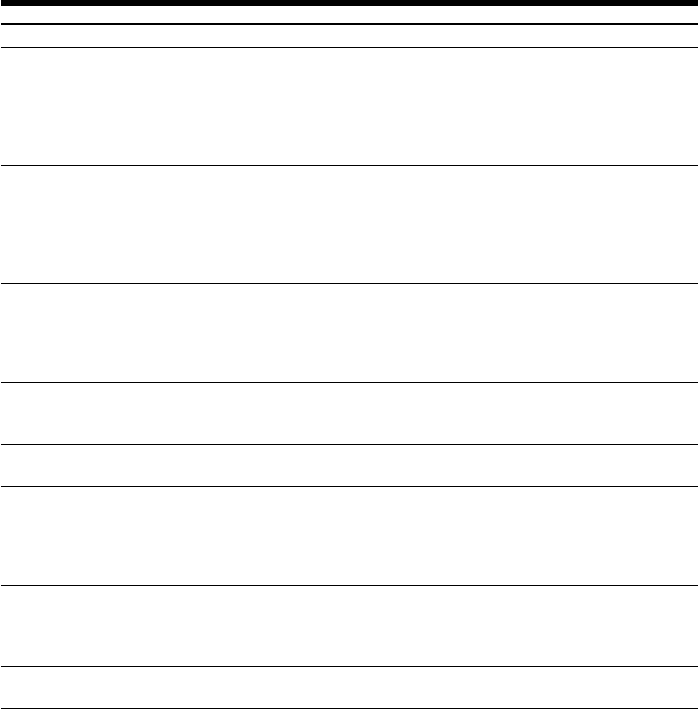
160
Symptom Cause and/or Corrective Actions
•Moisture condensation has occurred.
cRemove the cassette and leave your camcorder for at
least one hour to acclimatize (p. xx).
•Some troubles have occurred in your camcorder.
cRemove the cassette and insert it again, then operate
your camcorder.
•Disconnect the power cord of the AC power adaptor or
remove the battery, then reconnect it in about one minute.
Turn the power on. If the functions still do not work, press
the RESET button using a sharp-pointed object (If you
press the RESET button, all the settings including the date
and time return to the default.) (p. xx).
•This is because some functions use a linear mechanism.
Your camcorder is not a malfunction.
•Charge is completed.
•The battery pack is not properly installed.
cInstall it properly (p. xx).
•The POWER switch is not set to OFF (CHG).
c Set it to OFF (CHG).
•The battery pack is not properly installed.
cInstall it properly (p. xx).
•Something is wrong with the battery pack.
cPlease contact your Sony dealer or local authorized Sony
service facility.
•The USB cable was connected before installation of the
USB driver was completed.
cUninstall the incorrect USB driver and re-install the USB
driver (p. xx).
•Moisture has started to condense in your camcorder.
The melody or beep sounds for
five seconds.
No function works though the
power is on.
When you set the POWER switch to
VCR or OFF (CHG), if you move
your camcorder, you may hear a
clatter sound from inside your
camcorder.
While charging the battery pack, the
CHG lamp does not light up.
You cannot charge the battery pack.
While charging the battery pack, the
CHG lamp flashes.
Image data cannot be transferred by
the USB connection.
The cassette cannot be removed
even if the cassette lid is open.
Types of trouble and their solutions

161
Troubleshooting
Self-diagnosis display
Five-digit display Cause and/or Corrective Actions
•You are using a battery pack that is not an
“InfoLITHIUM” battery pack.
cUse an “InfoLITHIUM” battery pack (p. xx, xx).
•Moisture condensation has occurred.
cRemove the cassette and leave your camcorder for at
least one hour to acclimatize (p. xx).
•The video heads are dirty.
cClean the heads using the cleaning cassette (optional)
(p. xx).
•A malfunction other than the above that you can service
has occurred.
cRemove the cassette and insert it again, then operate
your camcorder.
cDisconnect the power cord of the AC power adaptor or
remove the battery pack. After reconnecting the power
source, operate your camcorder.
•A malfunction that you cannot service has occurred.
cContact your Sony dealer or local authorized Sony
service facility and inform them of the 5-digit code
(example: E:61:10).
If you are unable to rectify the problem even if you try corrective actions a few times,
contact your Sony dealer or local authorized Sony service facility.
Your camcorder has a self-diagnosis display
function.
This function displays the current condition of
your camcorder as a 5-digit code (a combination of
a letter and figures) on the screen. If a 5-digit code
is displayed, check the following code chart. The
last two digits (indicated by ss) will differ
depending on the state of your camcorder.
C:21:ss
LCD screen or Viewfinder
E:61:ss
E:62:ss
E:91:ss
C:31:ss
C:32:ss
C:04:ss
C:22:ss
Self-diagnosis display
•C:ss:ss
You can service your camcorder
yourself.
•E:ss:ss
Contact your Sony dealer or local
authorized Sony service facility.
C:21:00
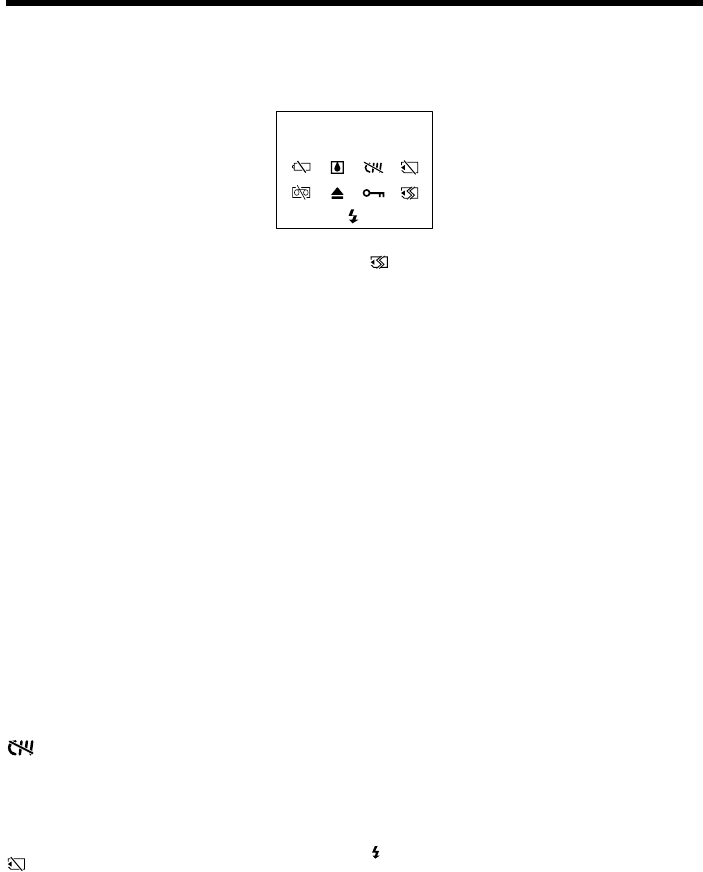
162
Warning indicators and messages
100-0001 Warning indicator as to file
Slow flashing:
•The file is corrupted.
•The file is unreadable.
•You are trying to carry out MEMORY MIX
function on moving picture.
C:21:00 Self-diagnosis display (p. xx).
EThe battery is dead or nearly dead
Slow flashing:
•The battery is nearly dead.
Depending on the operating conditions,
environment and battery condition, the E
indicator may flash, even if there are
approximately five to ten minutes remaining.
Fast flashing:
•The battery is dead (p. xx).
%Moisture condensation has occurred*
Fast flashing:
•Eject the cassette, turn off your camcorder,
and leave it for about one hour with the
cassette compartment open (p. xx).
Warning indicator as to cassette
memory*
Slow flashing:
•No tape with cassette memory is inserted
(p. xx).
Warning indicator as to “Memory
Stick”*
Slow flashing:
•No “Memory Stick” is inserted.
Fast flashing:
•The “Memory Stick” is not readable with
your camcorder (p. xx).
•The image cannot be recorded on “Memory
Stick” (p. xx).
If indicators and messages appear on the screen, check the following:
See the page in parentheses “()” for more information.
Warning indicators
C:21:00100–0001
Warning indicator as to “Memory Stick”
formatting*
Fast flashing:
•“Memory Stick” is not formatted correctly
(p. xx).
•The “Memory Stick” data is corrupted.
QWarning indicator as to tape
Slow flashing:
•The tape is near the end.
•No tape is inserted.*
•The write-protect tab on the cassette is out
(red) (p. xx).*
Fast flashing:
•The tape has run out.*
ZYou need to eject the cassette*
Slow flashing:
•The write-protect tab on the cassette is out
(red) (p. xx).
Fast flashing:
•Moisture condensation has occurred (p. xx).
•The tape has run out.
•The self-diagnosis display function is
activated (p. xx).
-The image is protected*
Slow flashing:
•The image is protected (p. xx).
Warning indicator as to the flash
Slow flashing:
•During charging
Fast flashing:
•The self-diagnosis display function is
activated (p. xx).*
•There is something wrong with the built-in
flash or the external flash (optional).
* You hear the melody or beep sound.
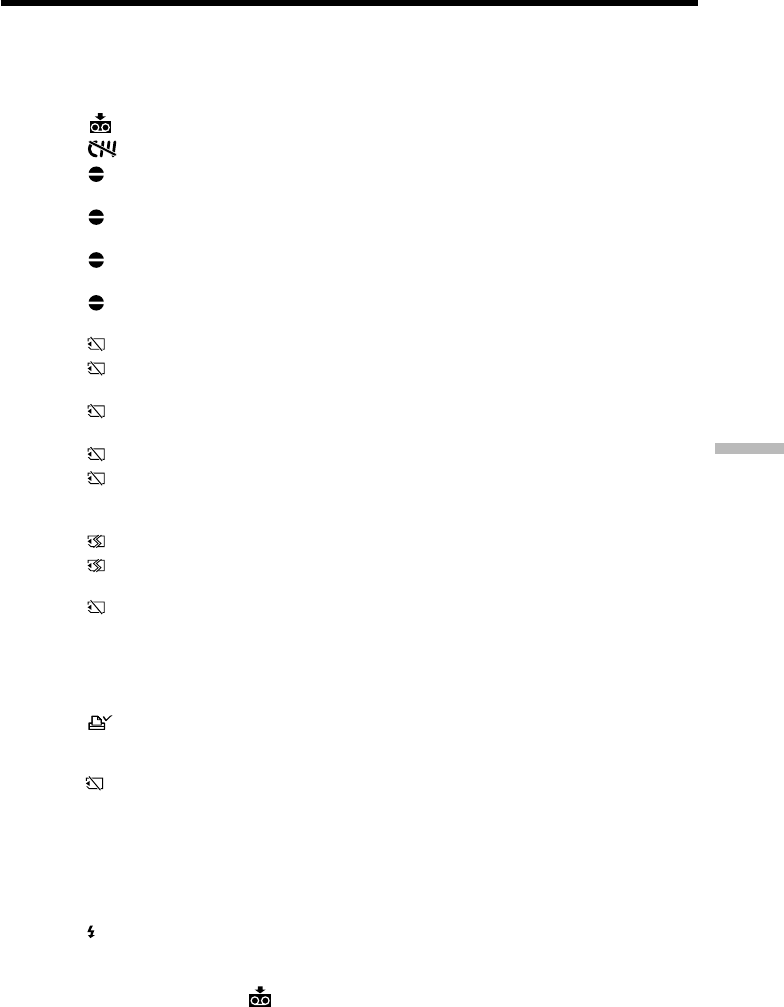
163
Troubleshooting
Warning messages
•CLOCK SET Set the date and time (p. xx).
•FOR “InfoLITHIUM”Use an “InfoLITHIUM” battery pack (p. xx).
BATTERY ONLY
• CLEANING CASSETTE** The video heads are dirty (p. xx).
• FULL The tape cassette memory is full.*
• 16BIT AUDIO MODE is set to 16BIT (p. xx).* You cannot
dub new sound.
• REC MODE REC MODE is set to LP (p. xx).* You cannot dub new
sound.
• TAPE There is no recorded portion on the tape.* You cannot
dub new sound.
• “i.LINK” CABLE i.LINK cable is connected (p. xx).* You cannot dub
new sound.
• FULL The “Memory Stick” is full (p. xx).*
• -The write-protect tab on the “Memory Stick” is set to
LOCK (p. xx).*
• NO FILE No still image is recorded on the “Memory Stick”
(p. xx).*
• NO MEMORY STICK No “Memory Stick” is inserted.*
• AUDIO ERROR You are trying to record an image with sound that
cannot be recorded by your camcorder on “Memory
Stick” (p. xx).*
• MEMORY STICK ERROR The “Memory Stick” data is corrupted (p. xx).*
• FORMAT ERROR The “Memory Stick” is not recognized. Check the
format (p. xx).*
• - DIRECTORY ERROR There are more than two same directories (p. xx).*
•COPY INHIBIT The tape contains copyright control signals for
copyright protection of software (p. xx).*
•Q Z TAPE END The tape has reached the end of the tape.*
•Q NO TAPE Insert a cassette tape.*
• NO PRINT MARK You selected MARKED in 9PIC PRINT in the menu
settings using a “Memory Stick” contains no image
with a print mark.* (p. xx)
• NO STILL IMAGE FILE You selected MULTI in 9PIC PRINT in the menu
settings using a “Memory Stick” contains no still
image.* (p. xx)
•DELETING You have pressed PHOTO during deleting all images
on “Memory Stick.”*
•FORMATTING You have pressed photo during formatting a
“Memory Stick.”*
• NOW CHARGING Charging an external flash (optional) does not work
correctly.*
* You hear the melody or beep sound.
**The x indicator and “ CLEANING CASSETTE” message appear one after
another on the screen.
Warning indicators and messages
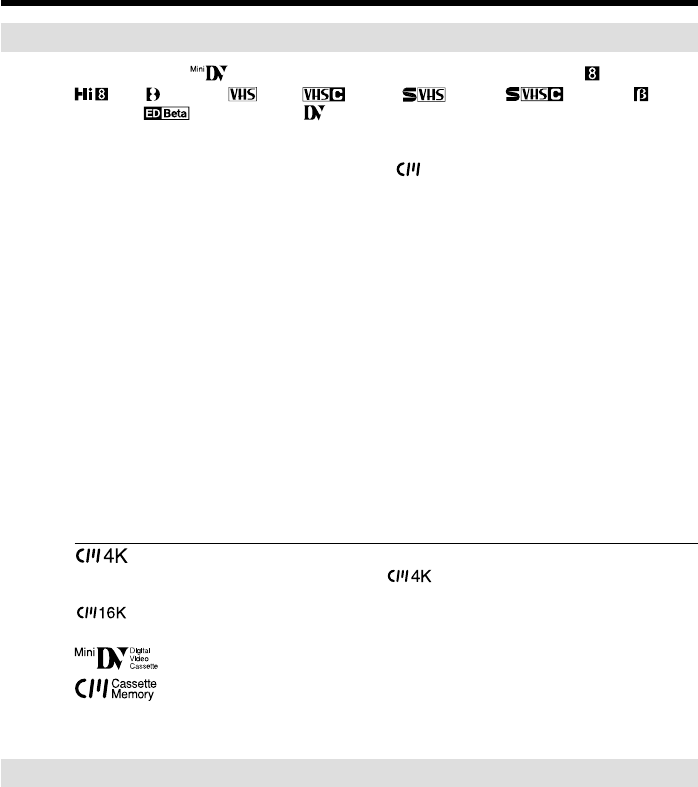
164
— Additional Information —
Usable cassettes
Selecting cassette types
You can use the mini DV cassette only*. You cannot use any other 8 mm,
Hi8, Digital8, VHS, VHSC, S-VHS, S-VHSC,
Betamax, ED Betamax or DV cassette.
* There are two types of mini DV cassettes: with cassette memory and without cassette
memory. Tapes with cassette memory have (Cassette Memory) mark.
We recommend that you use the tape with cassette memory.
The IC memory is mounted on this type of cassette. Your camcorder can read and
write data such as dates of recording or titles, etc. to this memory.
The functions using the cassette memory require successive signals recorded on the
tape. If the tape has a blank portion in the beginning or between the recorded
portions, a title may not be displayed properly or the search functions may not work
properly. Not to make any blank portion on the tape, operate the followings.
Press END SEARCH to go to the end of the recorded portion before you begin the
next recording if you operate the followings:
–you have ejected the cassette while recording.
–you have played back the tape in the VCR.
–you have used the edit search function.
If there is a blank portion or discontinuous signal on your tape, re-record from the
beginning to the end of the tape concerning above.
The same result may occur when you record using a digital video camera recorder
without a cassette memory function on a tape recorded by one with the cassette
memory function.
mark on the cassette
The memory capacity of tapes marked with is 4KB. Your camcorder can
accommodate tapes having a memory capacity of up to 16KB. 16KB tape is marked with
.
This is the mini DV mark.
This is the Cassette Memory mark.
These are trademarks.
Copyright signal
When you play back
Using any other video camera recorder, you cannot record on tape that has recorded a
copyright control signals for copyright protection of software which is played back on
your camcorder.
When you record
You cannot record software on your camcorder that contains copyright control signals
for copyright protection of software.
“COPY INHIBIT” appears on the screen, in the viewfinder or on the TV screen if you
try to record such software.
Your camcorder does not record copyright control signals on the tape when it records.
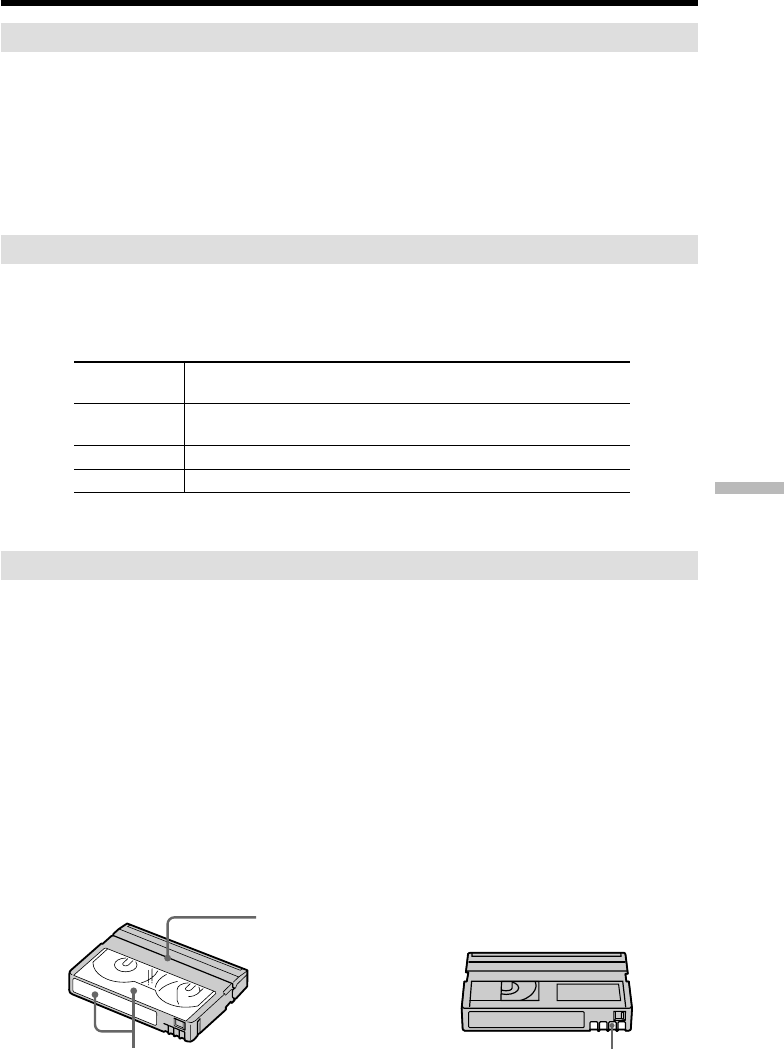
165
Additional Information
Audio mode
12-bit mode: The original sound can be recorded in stereo 1, and the new sound in
stereo 2 in 32 kHz. The balance between stereo 1 and stereo 2 can be adjusted by
selecting AUDIO MIX in the menu settings during playback. Both sounds can be played
back.
16-bit mode: A new sound cannot be recorded but the original sound can be recorded in
high quality. Moreover, it can also play back sound recorded in 32 kHz, 44.1 kHz or
48 kHz. When playing back a tape recorded in the 16-bit mode, 16BIT indicator appears
on the screen.
When you play back a dual sound track tape
When you play back a dual sound track tape recorded in a stereo system, set HiFi
SOUND to the desired mode in the menu settings (p. xx).
Sound from speaker
HiFi SOUND Playing back Playing back a dual
mode a stereo tape sound track tape
STEREO Stereo Main sound and
sub sound
1 Left sound Main sound
2 Right sound Sub sound
You cannot record dual sound programs on your camcorder.
Notes on the cassette
When affixing a label on the cassette
Be sure to affix a label only on the locations as illustrated below [a] so as not to cause
malfunction of your camcorder.
After using the cassette
Rewind the tape to the beginning, put the cassette in its case, and store it in an upright
position.
When the cassette memory function does not work
Reinsert a cassette. The gold-plated connector of cassettes may be dirty or dusty.
Cleaning gold-plated connector
If the gold-plated connector on the cassette is dirty or dusty, the remaining tape
indicator is sometimes not displayed correctly, and you may not be able to operate
functions using cassette memory. Clean up the gold-plated connector with cotton-wool
swab, about every 10 times ejection of a cassette. [b]
Usable cassettes
[b]
[a]
Do not affix a label
around this border.

166
About the “InfoLITHIUM” battery pack
What is the “InfoLITHIUM” battery pack?
The “InfoLITHIUM” battery pack is a lithium-ion battery pack that has functions for
communicating information related to operating conditions between the battery pack
and an optional AC adaptor/charger.
The “InfoLITHIUM” battery pack calculates the power consumption according to the
operating conditions of your camcorder, and displays the remaining battery time in
minutes.
Charging the battery pack
•Be sure to charge the battery pack before you start using your camcorder.
•We recommend charging the battery pack in an ambient temperature of between
10°C to 30°C (50°F to 86°F) until the CHG lamp goes off, indicating that the battery
pack is fully charged. If you charge the battery outside of this temperature range, you
may not be able to efficiently charge the battery pack.
•After charging is completed, either disconnect the cable from the DC IN jack on your
camcorder or remove the battery pack.
Effective use of the battery pack
•Battery pack performance decreases in low-temperature surroundings. So, the time
that the battery pack can be used becomes shorter. We recommend the following to
use the battery pack longer:
–Put the battery pack in a pocket to warm it up, and insert it in your camcorder
immediately before you start taking shots.
–Use the large capacity battery pack (NP-FM70/FM90/FM91, optional).
•Frequently using the LCD panel or frequently operating playback, fast forward or
rewind wears out the battery pack faster. We recommend using the large capacity
battery pack (NP-FM70/FM90/FM91, optional).
•Be certain to turn off the power switch when not taking shots or playing back on your
camcorder. The battery pack is also consumed when your camcorder is in the standby
mode or playback is paused.
•Have spare battery packs handy for two or three times the expected recording time,
and make trial recordings before taking the actual recording.
•Do not expose the battery pack to water. The battery pack is not water resistant.
Remaining battery time indicator
•If the power may go off although the remaining battery time indicator indicates that
the battery pack has enough power to operate, charge the battery pack fully again so
that the indication on the remaining battery time indicator is correct. Note, however,
that the correct battery indication sometimes will not be restored if it is used in high
temperatures for a long time or left in a fully charged state, or the battery pack is
frequently used. Regard the remaining battery time indication as the approximate
recording time.
•The E mark indicating there is little remaining battery time sometimes flashes
depending on the operating conditions or ambient temperature and environment even
if the remaining battery time is about five to ten minutes.

167
Additional Information
How to store the battery pack
•If the battery pack is not used for a long time, do the following procedure once per
year to maintain proper function.
1. Fully charge the battery.
2. Discharge on your electronic equipment.
3. Remove the battery from the equipment and store it in a dry, cool place.
•To use the battery pack up on your camcorder, leave your camcorder in the recording
mode until the power goes off without a cassette inserted.
Battery life
•The battery life is limited. Battery capacity drops little by little as you use it more and
more, and as time passes. When the available battery time is shortened considerably, a
probable cause is that the battery pack has reached the end of its life. Please buy a new
battery pack.
•The battery life varies according to how it is stored and operating conditions and
environment for each battery pack.
About the “InfoLITHIUM” battery pack

168
The DV jack on this unit is an i.LINK-compliant DV input/output jack. This section
describes the i.LINK standard and its features.
What is i.LINK?
i.LINK is a digital serial interface for handling digital video, digital audio and other
data in two directions between equipment having the i.LINK jack, and for controlling
other equipment.
i.LINK-compatible equipment can be connected by a single i.LINK cable. Possible
applications are operations and data transactions with various digital AV equipment.
When two or more i.LINK-compatible equipment are connected to this unit in a daisy
chain, operations and data transactions are possible with not only the equipment that
this unit is connected to but also with other devices via the directly connected
equipment.
Note, however, that the method of operation sometimes varies according to the
characteristics and specifications of the equipment to be connected, and that operations
and data transactions are sometimes not possible on some connected equipment.
Note
Normally, only one piece of equipment can be connected to this unit by the i.LINK
cable (DV cable). When connecting this unit to i.LINK-compatible equipment having
two or more i.LINK jacks (DV jacks), refer to the instruction manual of the equipment
to be connected.
About the Name “i.LINK”
i.LINK is a more familiar term for IEEE 1394 data transport bus proposed by SONY,
and is a trademark approved by many corporations.
IEEE 1394 is an international standard standardized by the Institute of Electrical and
Electronic Engineers.
i.LINK Baud rate
i.LINK’s maximum baud rate varies according to the equipment. Three maximum
baud rates are defined:
S100 (approx. 100Mbps*)
S200 (approx. 200Mbps)
S400 (approx. 400Mbps)
The baud rate is listed under “Specifications” in the instruction manual of each
equipment. It is also indicated near the i.LINK jack on some equipment.
The maximum baud rate of equipment on which it is not indicated such as this unit is
“S100”.
When units are connected to equipment having a different maximum baud rate, the
baud rate sometimes differs from the indicated baud rate.
*What is Mbps?
Mbps stands for megabits per second, or the amount of data that can be sent or
received in one second. For example, a baud rate of 100Mbps means that 100 megabits
of data can be sent in one second.
About i.LINK

169
Additional Information
i.LINK functions on this unit
For details on how to dub when this unit is connected to other video equipment having
DV jacks, see page xx and xx.
This unit can also be connected to other i.LINK (DV) compatible equipment made by
SONY (e.g. VAIO series personal computer) other than video equipment.
Before connecting this unit to a personal computer, make sure that application software
supported by this unit is already installed on the personal computer.
For details on precautions when connecting this unit, also refer to the instruction
manuals for the equipment to be connected.
Required i.LINK Cable
Use the Sony i.LINK 4-pin-to-4-pin cable (during DV dubbing).
i.LINK and are trademarks.
About i.LINK
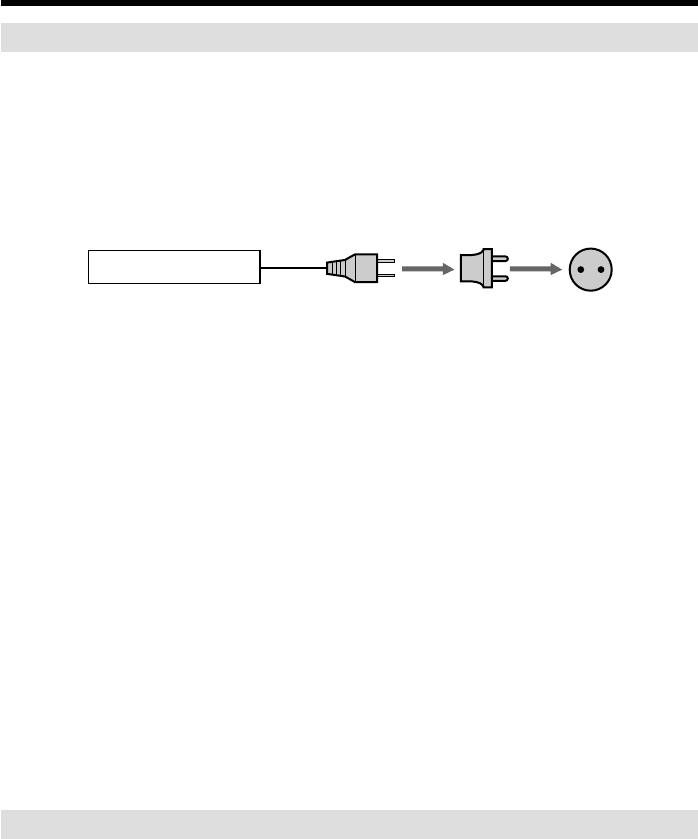
170
Using your camcorder abroad
Countries and areas where you can use network functions are restricted. For details,
refer to the separate Network Operating Instructions. (DCR-PC120BT only)
You can use your camcorder in any country or area with the AC power adaptor
supplied with your camcorder within 100 V to 240 V AC, 50/60 Hz.
When charging the battery pack, use a commercially available AC plug adaptor [a], if
necessary, depending on the design of the wall outlet [b].
Your camcorder is an NTSC system based camcorder. If you want to view the playback
picture on a TV, it must be an NTSC system based TV with the AUDIO/VIDEO input
jack.
The following shows TV color systems used overseas.
NTSC system
Bahama Islands, Bolivia, Canada, Central America, Chile, Colombia, Ecuador, Jamaica,
Japan, Korea, Mexico, Peru, Surinam, Taiwan, the Philippines, the U.S.A., Venezuela,
etc.
PAL system
Australia, Austria, Belgium, China, Czech Republic, Denmark, Finland, Germany, Great
Britain, Holland, Hong Kong, Italy, Kuwait, Malaysia, New Zealand, Norway, Portugal,
Singapore, Slovak Republic, Spain, Sweden, Switzerland, Thailand, etc.
PAL-M system
Brazil
PAL-N system
Argentina, Paraguay, Uruguay
SECAM system
Bulgaria, France, Guyana, Hungary, Iran, Iraq, Monaco, Poland, Russia, Ukraine, etc.
Simple setting of clock by time difference
You can easily set the clock to the local time by setting a time difference. Select AREA
SET, SUMMERTIME in the menu settings. See page xxx for more information.
Using your camcorder abroad
[b][a]
AC-L10A/L10B/L10C

171
Additional Information
Maintenance information and
precautions
Moisture condensation
If your camcorder is brought directly from a cold place to a warm place, moisture may
condense inside your camcorder, on the surface of the tape, or on the lens. In this
condition, the tape may stick to the head drum and be damaged or your camcorder may
not operate correctly. If there is moisture inside your camcorder, the beep sounds and
the % indicator flashes. When the Z indicator flashes at the same time, the cassette is
inserted in your camcorder. If moisture condenses on the lens, the indicator will not
appear.
If moisture condensation occurred
None of the functions except cassette ejection will work. Eject the cassette, turn off your
camcorder, and leave it for about one hour with the cassette lid open. Your camcorder
can be used again if the % indicator does not appear when the power is turned on
again.
If moisture starts to condense, your camcorder sometimes cannot detect condensation.
If this happens, the cassette sometimes is not ejected for ten seconds after the cassette lid
is opened. This is not a malfunction. Do not close the cassette lid until the cassette is
ejected.
Note on moisture condensation
Moisture may condense when you bring your camcorder from a cold place into a warm
place (or vice versa) or when you use your camcorder in a hot place as follows:
•You bring your camcorder from a ski slope into a place warmed up by a heating
device.
•You bring your camcorder from an air-conditioned car or room into a hot place
outside.
•You use your camcorder after a squall or a shower.
•You use your camcorder in a high temperature and humidity place.
How to prevent moisture condensation
When you bring your camcorder from a cold place into a warm place, put your
camcorder in a plastic bag and tightly seal it. Remove the bag when the air temperature
inside the plastic bag has reached the surrounding temperature (after about one hour).
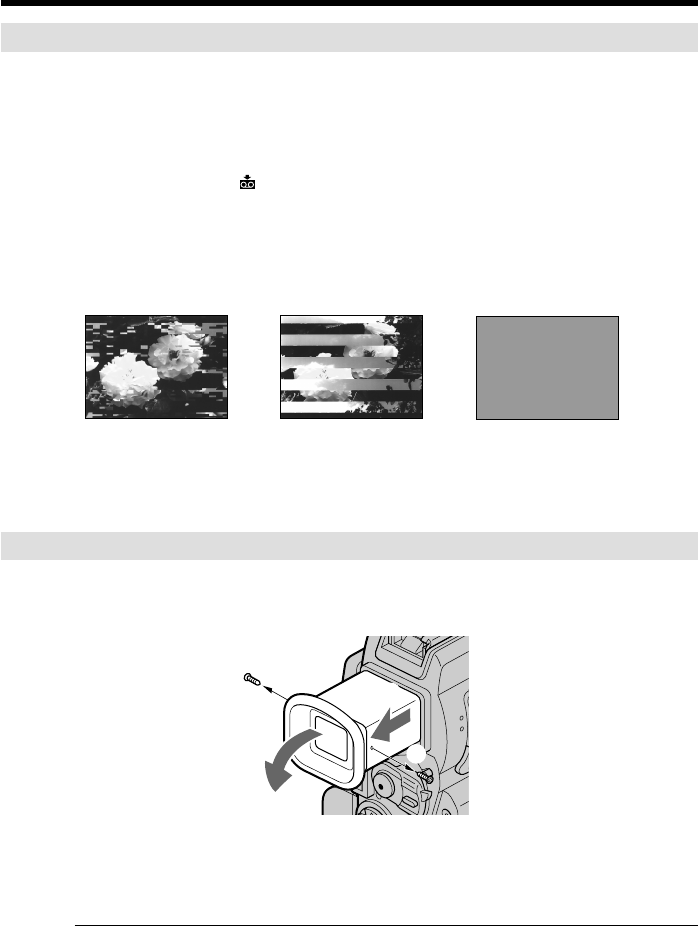
172
Maintenance information
Cleaning the video head
To ensure normal recording and clear pictures, clean the video heads. The video head
may be dirty when:
•mosaic-pattern noise appears on the playback picture.
•playback pictures do not move.
•playback pictures do not appear.
•the x indicator and “ CLEANING CASSETTE” message appear one after another
or the x indicator flashes on the screen during recording.
If the above problem, [a], [b] or [c] occurs, clean the video heads for 10 seconds with
the Sony DVM-12CLD cleaning cassette (optional). Check the picture and if the above
problem persists, repeat cleaning.
If the video heads get dirtier, the entire screen becomes blue [c].
Cleaning the LCD screen
If fingerprints or dust make the LCD screen dirty, we recommend using a LCD
Cleaning Kit (optional) to clean the LCD screen.
Removing dust from inside the viewfinder
(1)Pull out the viewfinder in the direction of the arrow 1.
Remove the two screws in the direction of the arrow 2 with a screwdriver
(optional). Remove the eyecup in the direction of the arrow 3.
(2)Remove dust from inside the eyecup and viewfinder with a commercially
available blower.
(3)In the reverse way of (1), attach the eyecup. Then replace the screws in the
direction of the arrow 2.
Caution
Do not remove any other screws. You may remove only the screw to remove the
eyecup.
Notes
•Do not drop or bend the eyecup shaft.
•Be careful when handling the eyecup.
Maintenance information and precautions
[a] [b] [c]
2
2
1
3

173
Additional Information
Maintenance information and precautions
Charging the built-in rechargeable battery
Your camcorder is supplied with a built-in rechargeable battery installed so as to retain
the date and time, etc., regardless of the setting of the POWER switch. The built-in
rechargeable battery is always charged as long as you are using your camcorder. The
battery, however, will get discharged gradually if you do not use your camcorder. It
will be completely discharged in about three months if you do not use your camcorder
at all. Even if the built-in rechargeable battery is not charged, it will not affect the
camcorder operation. To retain the date and time, etc., charge the battery if the battery
is discharged.
Charging the built-in rechargeable battery:
•Connect your camcorder to house current using the AC power adaptor supplied with
your camcorder, and leave your camcorder with the POWER switch turned off for
more than 24 hours.
•Or install the fully charged battery pack in your camcorder, and leave your camcorder
with the POWER switch set to OFF for more than 24 hours.
Precautions
Camcorder operation
•Operate your camcorder on 7.2 V (battery pack) or 8.4 V (AC power adaptor).
•For DC or AC operation, use the accessories recommended in this operating
instructions.
•If any solid object or liquid get inside the casing, unplug your camcorder and have it
checked by a Sony dealer before operating it any further.
•Avoid rough handling or mechanical shock. Be particularly careful of the lens.
•Keep the POWER switch set to OFF (CHG) when you are not using your camcorder.
•Do not wrap your camcorder with a towel, for example, and operate it. Doing so
might cause heat to build up inside.
•Keep your camcorder away from strong magnetic fields or mechanical vibration.
•Do not touch the LCD screen with your fingers or a sharp-pointed object.
•If your camcorder is used in a cold place, a residual image may appear on the LCD
screen. This is not a malfunction.
•While using your camcorder, the back of the LCD screen may heat up. This is not a
malfunction.
On handling tapes
•Do not insert anything into the small holes on the rear of the cassette. These holes are
used to sense the type and thickness of the tape and if the recording tab is in or out.
•Do not open the tape protect cover or touch the tape.
•Avoid touching or damaging the terminals. To remove dust, clean the terminals with
a soft cloth.

174
Maintenance information and precautions
Camcorder care
•Remove the tape, and periodically turn on the power, operate the CAMERA and VCR
sections and play back a tape for about three minutes when your camcorder is not to
be used for a long time.
•Clean the lens with a soft brush to remove dust. If there are fingerprints on the lens,
remove them with a soft cloth.
•Clean the camcorder body with a dry soft cloth, or a soft cloth lightly moistened with
a mild detergent solution. Do not use any type of solvent which may damage the
finish.
•Do not let sand get into your camcorder. When you use your camcorder on a sandy
beach or in a dusty place, protect it from the sand or dust. Sand or dust may cause
your camcorder to malfunction, and sometimes this malfunction cannot be repaired.
AC power adaptor
•Unplug the unit from the wall outlet when you are not using the unit for a long time.
To disconnect the power cord, pull it out by the plug. Never pull the power cord itself.
•Do not operate the unit with a damaged cord or if the unit has been dropped or
damaged.
•Do not bend the power cord forcibly, or place a heavy object on it. This will damage
the cord and may cause fire or electrical shock.
•Prevent metallic objects from coming into contact with the metal parts of the
connecting section. If this happens, a short may occur and the unit may be damaged.
•Always keep metal contacts clean.
•Do not disassemble the unit.
•Do not apply mechanical shock or drop the unit.
•While the unit is in use, particularly during charging, keep it away from AM receivers
and video equipment. AM receivers and video equipment disturb AM reception and
video operation.
•The unit becomes warm during use. This is not a malfunction.
•Do not place the unit in locations that are:
– Extremely hot or cold
– Dusty or dirty
– Very humid
– Vibrating
About care and storage of the lens
•Wipe the surface of the lens clean with a soft cloth in the following instance:
–When there are fingerprints on the lens surface
–In hot or humid locations
–When the lens is used in environments such as the seaside
•Store the lens in a well-ventilated location subject to little dirt or dust.
To prevent mold from occurring, periodically perform the above.
We recommend turning on and operating the video camera recorder about once per
month to keep the video camera recorder in an optimum state for a long time.

175
Additional Information
Maintenance information and precautions
Battery pack
•Use only the specified charger or video equipment with the charging function.
•To prevent accident from a short circuit, do not allow metal objects to come into
contact with the battery terminals.
•Keep the battery pack away from fire.
•Never expose the battery pack to temperatures above 60°C (140°F), such as in a car
parked in the sun or under direct sunlight.
•Keep the battery pack dry.
•Do not expose the battery pack to any mechanical shock.
•Do not disassemble nor modify the battery pack.
•Attach the battery pack to the video equipment securely.
Notes on dry batteries
To avoid possible damage from battery leakage or corrosion, observe the following:
–Be sure to insert the batteries with the + – polarities matched to the + – marks.
–Dry batteries are not rechargeable.
–Do not use a combination of new and old batteries.
–Do not use different types of batteries.
–Current flows from batteries when you are not using them for a long time.
–Do not use leaking batteries.
If batteries are leaking
•Wipe off the liquid in the battery compartment carefully before replacing the batteries.
•If you touch the liquid, wash it off with water.
•If the liquid get into your eyes, wash your eyes with a lot of water and then consult a
doctor.
If any problem occurs, unplug your camcorder and contact your nearest Sony dealer.

176
Specifications
Video camera
recorder
System
Video recording system
2 rotary heads
Helical scanning system
Audio recording system
Rotary heads, PCM system
Quantization: 12 bits (Fs 32
kHz, stereo 1, stereo 2), 16 bits
(Fs 48 kHz, stereo)
Video signal
NTSC color, EIA standards
Usable cassette
Mini DV cassette with the
mark printed
Tape speed
SP: Approx. 18.81 mm/s
LP: Approx. 12.56 mm/s
Recording/playback time
(using cassette DVM60)
SP: 1 hour
LP: 1.5 hours
Fastforward/rewind time
(using cassette DVM60)
When using the battery pack:
Approx. 2 min. and 30 seconds
When using the AC power
adaptor:
Approx. 1 min. and 45 seconds
Viewfinder
Electric viewfinder (color)
Image device
4.5 mm (1/4 type) CCD
(Charge Coupled Device)
Approx. 1 550 000 pixels
(Effective (moving): 970 000
pixels)
(Effective (still): 1 390 000
pixels)
Lens
Carl Zeiss Vario-Sonnar T*
Combined power zoom lens
Filter diameter: 37 mm
(1 1/2 in)
10× (Optical), 120× (Digital)
Focal length
4.2 – 42 mm (3/16 – 1 11/16 in.)
When converted to a 35 mm
still camera
Camera mode:
48 – 480 mm (1 15/16 – 19 in.)
Memory mode:
40 – 400 mm (1 5/8 – 15 3/4 in.)
Color temperature
Auto, HOLD (Hold), nIndoor
(3 200 K), Outdoor (5 800 K)
Minimum illumination
7 lx (lux) (F 1.8)
0 lx (lux) (in the NightShot
mode)*
* Objects unable to be seen due
to the dark can be shot with
infrared lighting.
Input/Output connectors
S video input/output
4-pin mini DIN
Luminance signal: 1 Vp-p,
75 Ω (ohms), unbalanced
Chrominance signal: 0.286 Vp-p,
75 Ω (ohms), unbalanced
Audio/Video input/output
AV MINI JACK, 1 Vp-p,
75 Ω (ohms), unbalanced, sync
negative
327 mV, (at output impedance
more than 47 kΩ (kilohms)
Output impedance with less
than 2.2 kΩ (kilohms)/Stereo
minijack
(ø 3.5 mm)
Input impedance more than
47 kΩ (kilohms)
DV input/output
4-pin connector
Headphone jack
Stereo minijack (ø 3.5 mm)
LANC jack
Stereo mini-minijack (ø 2.5 mm)
USB jack
mini-B
MIC jack
Minijack, 0.388 mV low
impedance with 2.5 to 3.0 V DC,
output impedance 6.8 kΩ
(kilohms) (ø 3.5 mm)
Stereo type
LCD screen
Picture
6.2 cm (2.5 type)
50 × 37 mm (2 × 1 1/2 in.)
Total dot number
211 200 (960 × 220)
Wireless communications
(DCR-PC120BT only)
Communications system
Bluetooth standard Ver.1.1
Max. baud rate1) Approx. 723
kbps
Output Bluetooth standard
Power Class 2
Communications distance2)
Max. wireless distance
Approx. 10 m
Compatible Bluetooth profile3)
Generic Access Profile
Dial-up Networking Profile
Operating frequency band
2.4 GHz band (2 400 GHz –
24 835 GHz)
1) Max. baud rate of Bluetooth
standard Ver.1.1
2) Varies according to the
distance between
communicating devices,
presence of obstacles,
radiowave conditions, and
other factors.
3) This is a specification
matched to specific usage
requirements between
Bluetooth-compatible
devices. It is laid down in the
Bluetooth standards.

177
Additional Information
Specifications
General
Power requirements
7.2 V (battery pack)
8.4 V (AC power adaptor)
Average power consumption
(when using the battery pack)
During camera recording using
LCD
4.4 W
Viewfinder
3.8 W
Operating temperature
0°C to 40°C (32°F to 104°F)
Storage temperature
–20°C to +60°C
(–4°F to +140°F)
Dimensions (Approx.)
113 × 118 × 57 mm
(4 1/2 × 4 3/4 × 2 1/4 in.)
(w/h/d)
Mass (approx.)
580 g (x lb x oz)
main unit only
690 g (x lb xx oz)
including the battery pack,
NP-FM50, cassette DVM60, lens
cap and shoulder strap
Supplied accessories
See page x.
AC power adaptor
Power requirements
100 – 240 V AC, 50/60 Hz
Power consumption
23 W
Output voltage
DC OUT: 8.4 V, 1.5 A in the
operating mode
Operating temperature
0°C to 40°C (32°F to 104°F)
Storage temperature
–20°C to + 60°C
(–4°F to + 140°F)
Dimensions (approx.)
125 × 39 × 62 mm
(5 × 1 9/16 × 2 1/2 in.) (w/h/d)
excluding projecting parts
Mass (approx.)
280 g (9.8 oz)
excluding power cord
Cord length (approx.)
Power cord: 2 m (6.6 feet)
Connecting cord: 1.6 m
(5.2 feet)
Battery pack
Maximum output voltage
DC 8.4 V
Output voltage
DC 7.2 V
Capacity
8.5 Wh (1 180 mAh)
Dimensions (approx.)
38.2 × 20.5 × 55.6 mm
(1 9/16 × 13/16 × 2 1/4 in.)
(w/h/d)
Mass (approx.)
76 g (2.7 oz)
Type
Lithium ion
“Memory Stick”
Memory
Flash memory
8MB: MSA-8A
Operating voltage
2.7 – 3.6 V
Power consumption
Approx. 45 mA in the operating
mode
Approx. 130 µA in the standby
mode
Dimensions (approx.)
50 × 2.8 × 21.5 mm
(2 × 1/8 × 7/8 in.) (w/h/d)
Mass (approx.)
4 g (0.14 oz)
Design and specifications are
subject to change without
notice.
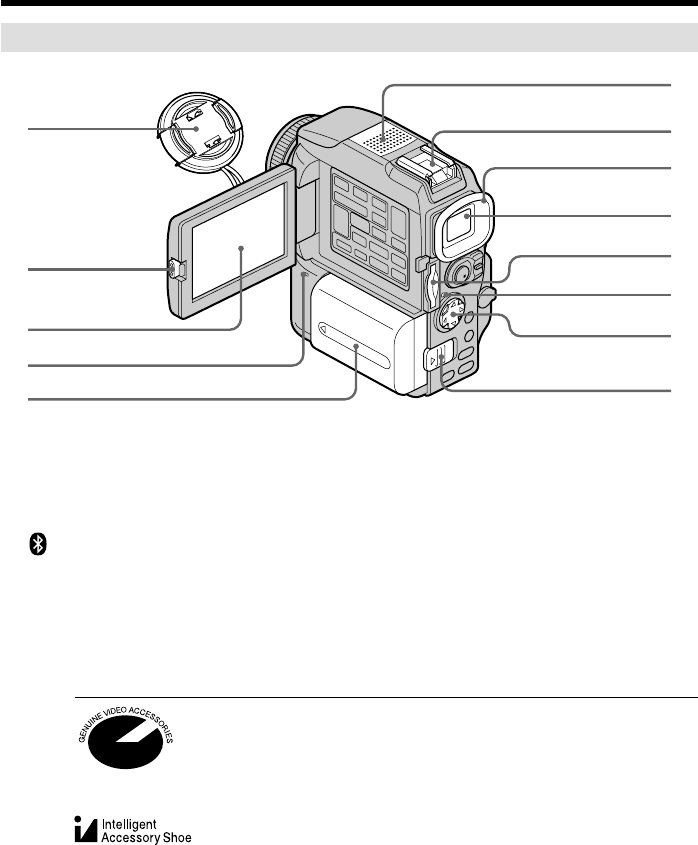
178
— Quick Reference —
Identifying the parts and controls
1Lens Cap (p. xx)
2OPEN button (p. xx)
3LCD screen (p. xx)
4 (Bluetooth) lamp (DCR-PC120 BT
only)
5Battery pack/Battery terminal cover
(p. xx)
Camcorder
6Microphone
7Intelligent accessory shoe (p. xx)
8Eyecup
9Viewfinder (p. xx)
q; “Memory Stick” slot (p. xx)
qa Access lamp (p. xx)
qs Control button (p. xx)
qd BATT RELEASE lever (p. xx)
1
2
3
4
5
6
7
8
9
0
qa
qd
qs
This mark indicates that this product is a genuine accessory for Sony
video products.
When purchasing Sony video products, Sony recommends that you
purchase accessories with this “GENUINE VIDEO ACCESSORIES”
mark.
Notes on the intelligent accessory shoe
•The intelligent accessory shoe supplies power to optional accessories such as a video
light or microphone.
•The intelligent accessory shoe is linked to the POWER switch, allowing you to turn the
power supplied by the shoe on and off. Refer to the operating instructions of the
accessory for further information.
•The intelligent accessory shoe has a safety device for fixing the installed accessory
securely. To connect an accessory, press down and push it to the end, and then tighten
the screw.
•To remove an accessory, loosen the screw, and then press down and pull out the
accessory.
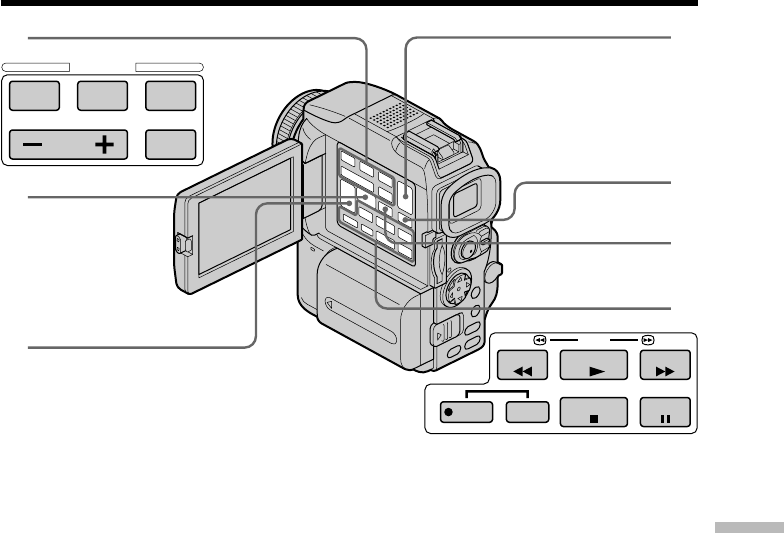
179
Quick Reference
Identifying the parts and controls
qf MEMORY operation buttons
MEMORY PLAY button (p. xx)
MEMORY INDEX button (p. xx)
MEMORY DELETE button (p. xx)
MEMORY +/– buttons (p. xx)
MEMORY MIX button (p. xx)
qg MPEG BX/PB ZOOM button
(p. xx, xx, xx)
qh VOLUME buttons (p. xx)
qj EDITSEARCH button (p. xx, xx)
qk DISPLAY button (p. xx)
ql END SEARCH button (p. xx)
w; Video control buttons (p. xx)
x STOP (stop)
m REW (rewind)
N PLAY (playback)
M FF (fastforward)
X PAUSE (pause)
z REC (record)
qg
qf qj
qh
qk
ql
w;
PLAY
INDEX
DELETE
MEMORY
MEMORY
MIX
STOP
FF
PAUSE
PLAYREW
REC
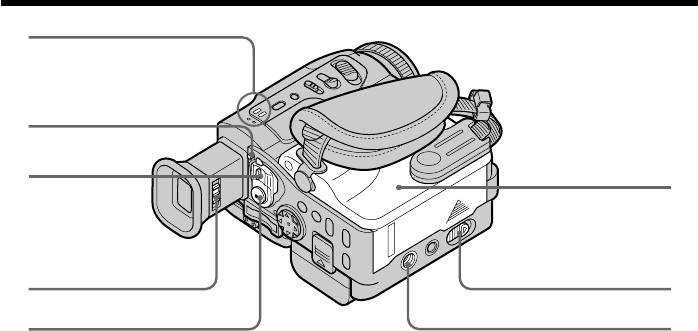
180
Identifying the parts and controls
wa Speaker (p. xx)
ws LOCK switch (p. xx)
wd POWER switch (p. xx)
wf Viewfinder lens adjustment lever
(p. xx)
wg START/STOP button (p. xx)
wh Cassette lid (p. xx)
wj OPEN/Z EJECT lever (p. xx)
wk Tripod receptacle
Make sure that the length of the tripod
screw is less than 5.5 mm (7/32 inch).
Otherwise, you cannot attach the tripod
securely and the screw may damage
your camcorder.
wj
wk
wh
wd
wf
wa
ws
wg
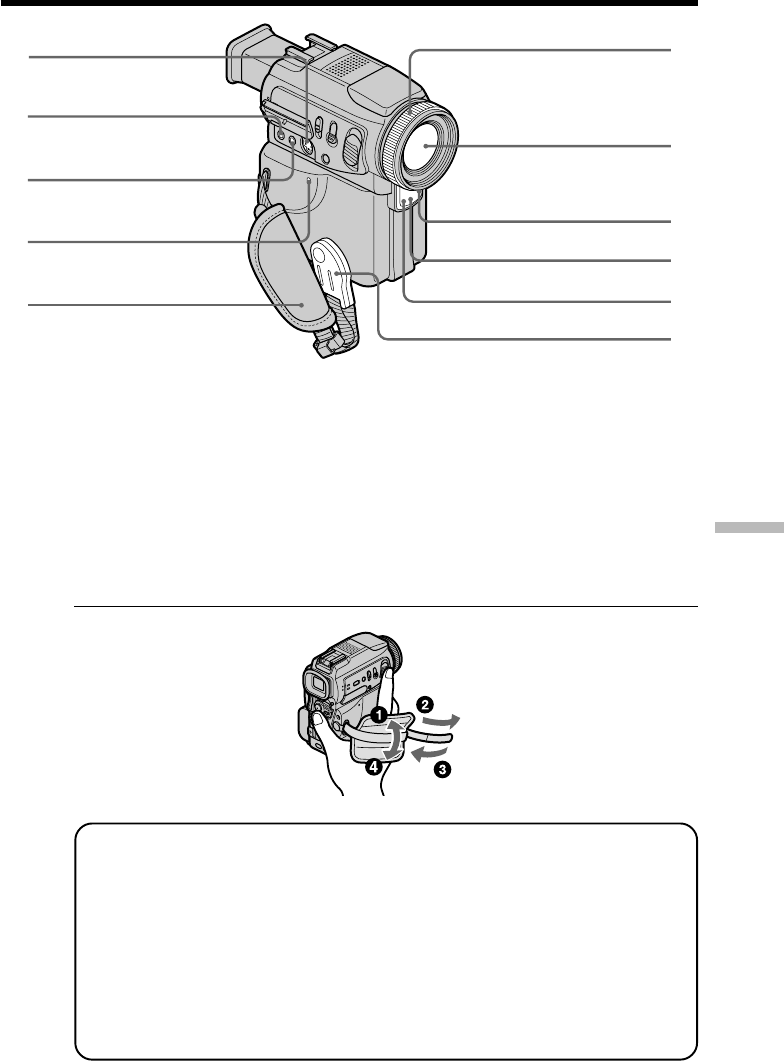
181
Quick Reference
Fastening the grip strap
Fasten the grip strap firmly.
wl S VIDEO ID-2 jack (p. xx, xx, xx, xx)
e; MIC (PLUG IN POWER) jack
Connect an external microphone
(optional). This jack also accepts
a “plug-in-power” microphone.
ea AUDIO/VIDEO ID-2 jack
(p. xx, xx, xx, xx)
es RESET button (p. xx)
ed Grip strap
Identifying the parts and controls
ef Focus ring (p. xx)
eg Lens
eh Camera recording lamp (p. xx)
ej Infrared rays emitter (p. xx, xx, xx)
ek Remote sensor
el Holdind Grip
Note on the Carl Zeiss lens
Your camcorder is equipped with a Carl Zeiss lens which can reproduce a fine
image.
The lens for your camcorder was developed jointly by Carl Zeiss, in Germany, and
Sony Corporation. It adopts the MTF# measurement system for video camera and
offers a quality as the Carl Zeiss lens.
The lenz for your camcorder is also T*-coated to suppress unwanted reflection and
faithfully reproduce colors.
#MTF is an abbreviation of Modulation Transfer Function.
The value number indicates the amount of light of a subject penetrating into the
lens.
ej
eh
eg
ef
e;
ea
es
ed
wl
el
ek
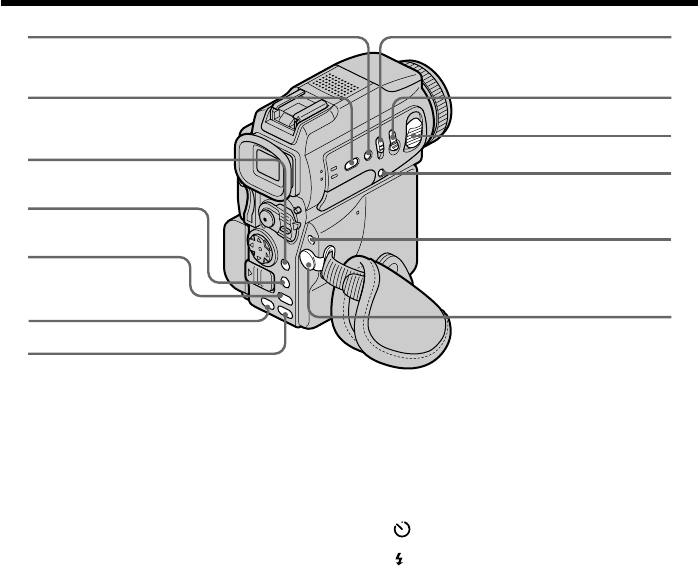
182
r; SUPER NIGHTSHOT button (p. xx)
ra FOCUS button (p. xx)
rs NETWORK button (p. xx)
rd BROWSER MENU/MENU button
(p. xx/xx) (DCR-PC120BT only)/
MENU button (p. xx) (DCR-PC115 only)
rf EXPOSURE button (p. xx)
rg BACK LIGHT button (p. xx)
rh FADER button (p. xx)
Identifying the parts and controls
rj NIGHTSHOT switch (p. xx)
rk PHOTO button (p. xx, xx)
rl Power zoom lever (p. xx, xx, xx)
t; (self-timer) button (p. xx, xx)
ta (flash) button (p. xx, xx)
ts i (headphones) jack
When you use headphones, the speaker
on your camcorder is silent.
r;
ra
rs
rd
rf
rh
rg
rj
rk
rl
t;
ts
ta
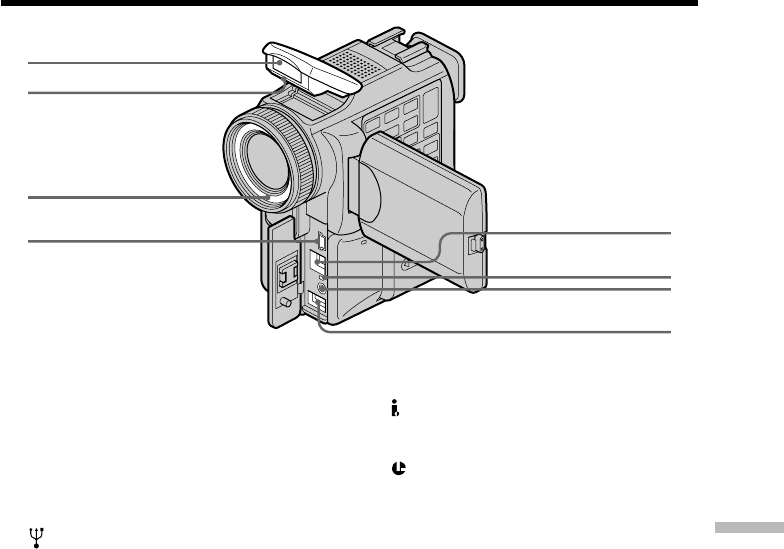
183
Quick Reference
td Flash (p. xx, xx)
tf HOLOGRAM AF emitter (p. xx)
tg Photocell window for flash
Do not block this window when
recording.
th (USB) jack (p. xx)
Identifying the parts and controls
td
tf
tg
th
tl
tk
tj
y;
tj DV jack (p. xx, xx, xx)
tk CHG (charge) lamp (p. xx)
tl LANC jack
y; DC IN jack (p. xx)
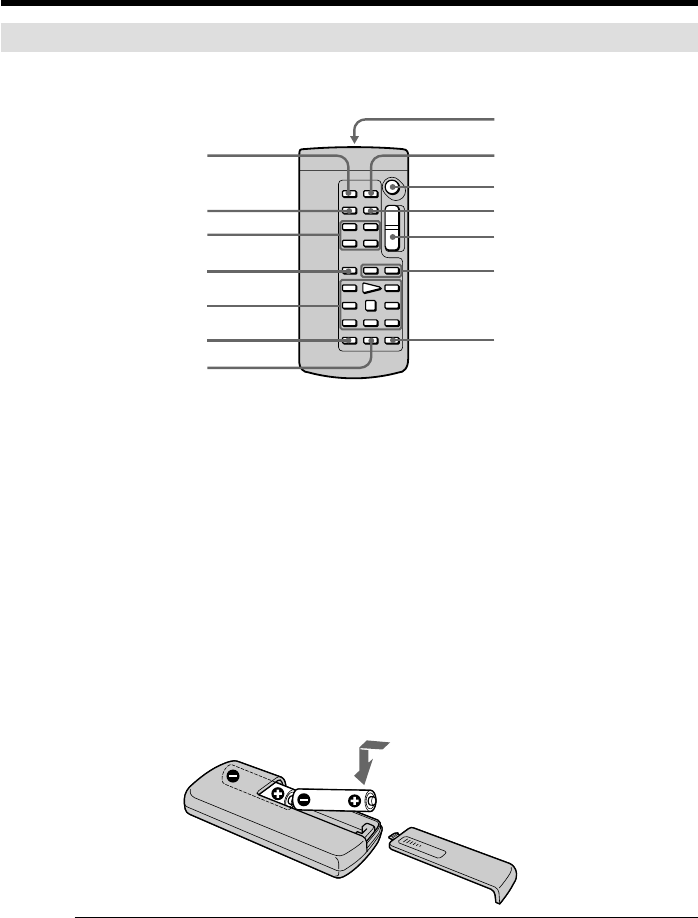
184
Identifying the parts and controls
Remote Commander
The buttons that have the same name on the Remote Commander as on your camcorder
function identically to the buttons on your camcorder.
To prepare the Remote Commander
Insert two size AA (R6) batteries by matching the + and – polarities on the batteries to
the + – marks inside the battery compartment.
Notes on the Remote Commander
•Point the remote sensor away from strong light sources such as direct sunlight or
overhead lighting. Otherwise, the Remote Commander may not function properly.
•Your camcorder works in the commander mode VTR 2. Commander modes 1, 2 and 3
are used to distinguish your camcorder from other Sony VCRs to avoid remote control
misoperation. If you use another Sony VCR in the commander mode VTR 2, we
recommend changing the commander mode or covering the sensor of the VCR with
black paper.
1PHOTO button (p. xx, xx)
2DISPLAY button (p. xx)
3Memory control buttons (p. xx)
4SEARCH MODE button (p. xx, xx, xx)
5Video control buttons (p. xx)
6REC button (p. xx, xx, xx)
7MARK button (p. xx, xx)
8Transmitter
Point toward the remote sensor to
control your camcorder after turning on
your camcorder.
9ZERO SET MEMORY button (p. xx, xx)
q; START/STOP button (p. xx)
qa DATA CODE button (p. xx)
qs Power zoom button (p. xx)
qd ./> buttons (p. xx)
qf AUDIO DUB button (p. xx)
7
qf
5
4
3
2
1
qs
qd
0
qa
9
8
6
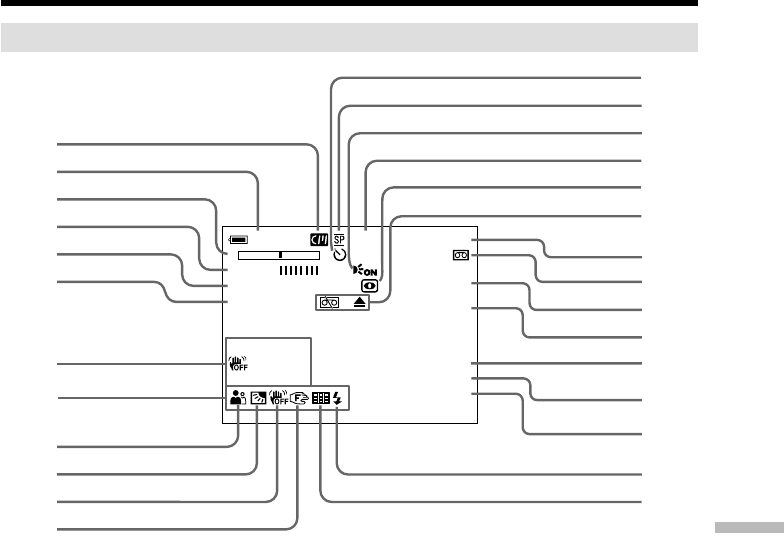
185
Quick Reference
Identifying the parts and controls
Operation indicators
1Cassette memory (p. xx, xx)
2Remaining battery time (p. xx)
3Zoom (p. xx)/Exposure (p. xx)/
Data file name (p. xx)
4Digital effect (p. xx, xx)/MEMORY MIX
(p. xx)/FADER (p. xx)
516:9WIDE (p. xx)
6Picture effect (p. xx, xx)
7Data code (p. xx)
8Volume (p. xx)/Date (p. xx)
9PROGRAM AE (p. xx)
0Backlight (p. xx)
qa SteadyShot off (p. xx)
qs Manual focus/Infinity (p. xx)
qd Self-timer (p. xx, xx)
qf Recording mode (p. xx, xx)
qg HOLOGRAM AF (p. xx)
qh STBY/REC (p. xx)/Video control mode
(p. xx)/Image size (p. xx)/Image
quality mode (p. xx)
qj NIGHTSHOT (p. xx)/SUPER NIGHTSHOT
(p. xx)
LCD screen and Viewfinder
qk Warning (p. xx)
ql Tape counter (p. xx)/Time code (p. xx)/
Self-diagnosis (p. xx)/Tape photo
(p. xx)/Memory photo (p. xx)/
Image number (p. xx, xx)
w; Remaining tape (p. xx)/Memory
playback (p. xx)
wa ZERO SET MEMORY (p. xx)
ws END SEARCH (p. xx)
wd A/V t DV (p. xx)/DV IN (p. xx)
wf Audio mode (p. xx)
wg Data file name (p. xx)/Time (p. xx)
wh Flash (p. xx, xx)
This indicator appears only when the
flash is in use.
wj Continuous mode (p. xx)
120min STBY 0:12:34
–+12min
ST I LL ZERO SET
16: 9WIDE MEMORY
NEG . ART END
SEARCH
AUTO
5 0 AWB DV I N
F11 9db 16BIT
100–0001
6
5
4
3
2
1
9
0
qa
qs
wa
w;
ql
qk
qj
wd
wg
wh
wf
ws
7
8
wj
qg
qh
qd
qf

186
Index
A, B
AC power adaptor.................. xx
Adjusting viewfinder ............. xx
Audio dubbing........................ xx
AUDIO MIX ............................ xx
Audio mode............................. xx
Auto red-eye reduction.... xx, xx
AUTO SHTR............................ xx
A/V connecting cable
..................xx, xx, xx, xx, xx, xx
BACK LIGHT .......................... xx
Battery pack ............................. xx
BEEP ......................................... xx
BOUNCE.................................. xx
C, D
Camera chromakey ................ xx
Cassette memory .............. xx, xx
Charging battery..................... xx
Charging built-in rechargeable
battery ................................... xx
Clock set ................................... xx
Continuous .............................. xx
Control button......................... xx
Cut recording .......................... xx
Data code ................................. xx
Date search .............................. xx
DEMO....................................... xx
DIGITAL EFFECT ............ xx, xx
Digital program editing......... xx
DISPLAY.................................. xx
DOT .......................................... xx
Dual sound track tape............ xx
DV connecting cable......... xx, xx
E
EDIT SEARCH ........................ xx
END SEARCH......................... xx
Exposure .................................. xx
F, G, H
FADER ..................................... xx
Fade in/out.............................. xx
Flash.................................... xx, xx
FLASH MOTION.................... xx
FOCUS...................................... xx
Format ................................ xx, xx
Full charge ............................... xx
Grip strap................................. xx
i (Headphone) jack ............... xx
Heads........................................ xx
HiFi SOUND ........................... xx
HIGH SPEED .......................... xx
Holding Grip ..................... x, xxx
HOLOGRAM AF .................... xx
I, J, K, L
i.LINK....................................... xx
Image protection ..................... xx
Image quality mode ............... xx
Image size ................................ xx
INDEX (Multiple) display ..... xx
“InfoLITHIUM” battery ........ xx
Infrared rays emitter ... xx, xx, xx
Insert editing ........................... xx
Intelligent accessory shoe ...... xx
Interval recording ................... xx
JPEG.......................................... xx
Labeling a cassette .................. xx
LANC jack ............................... xx
LUMINANCEKEY ................. xx
M, N
Main sound.............................. xx
Manual focus ........................... xx
Memory chromakey ............... xx
Memory luminancekey.......... xx
MEMORY MIX........................ xx
Memory PB ZOOM ................ xx
Memory photo recording ...... xx
“Memory Stick”...................... xx
Menu settings .......................... xx
Memory overlap ..................... xx
Mirror mode ............................ xx
Moisture condensation .......... xx
MONOTONE .......................... xx
M FADER................................. xx
MPEG ....................................... xx
MPEG movie recording ......... xx
MULTI SCRN .......................... xx
NETWORK .............................. xx
NIGHTSHOT .......................... xx
NTSC system ........................... xx
O, P, Q
OLD MOVIE............................ xx
Operation indicators .............. xx
OVERLAP................................ xx
Photo save................................ xx
Photo scan................................ xx
Photo search ............................ xx
PICTURE EFFECT ............ xx, xx
Picture search .......................... xx
Playback pause........................ xx
Playing time............................. xx
Power zoom............................. xx
Print mark................................ xx
PROGRAM AE....................... xx
R
Recording time........................ xx
Rec Review .............................. xx
Remaining battery time
indicator ................................ xx
Remaining tape indicator ...... xx
Remote Commander .............. xx
Remote sensor ......................... xx
RESET ....................................... xx
S
Self-diagnosis display ............ xx
Self-timer recording ... xx, xx, xx
Signal convert function .......... xx
Skip scan .................................. xx
Slide show................................ xx
Slow playback ......................... xx
SLOW SHUTTER.................... xx
STEADYSHOT ........................ xx
Stereo tape ............................... xx
STILL ........................................ xx
Sub sound ................................ xx
SUPER NIGHTSHOT............. xx
S VIDEO jack
..................xx, xx, xx, xx, xx, xx
T, U, V
Tape counter............................ xx
Tape PB ZOOM....................... xx
Tape photo recording............. xx
Telephoto ................................. xx
Time code................................. xx
Title ........................................... xx
Title search............................... xx
TRAIL ....................................... xx
Transition................................. xx
TV color systems..................... xx
USB jack ............................. xx, xx
W, X, Y, Z
Warning indicators................. xx
White balance .......................... xx
Wide-angle .............................. xx
Wide mode .............................. xx
WIPE......................................... xx
WORLD TIME......................... xx
Write-protect switch............... xx
Write-protect tab..................... xx
Zero set memory............... xx, xx
Zoom ........................................ xx

Sony Corporation Printed in Japan